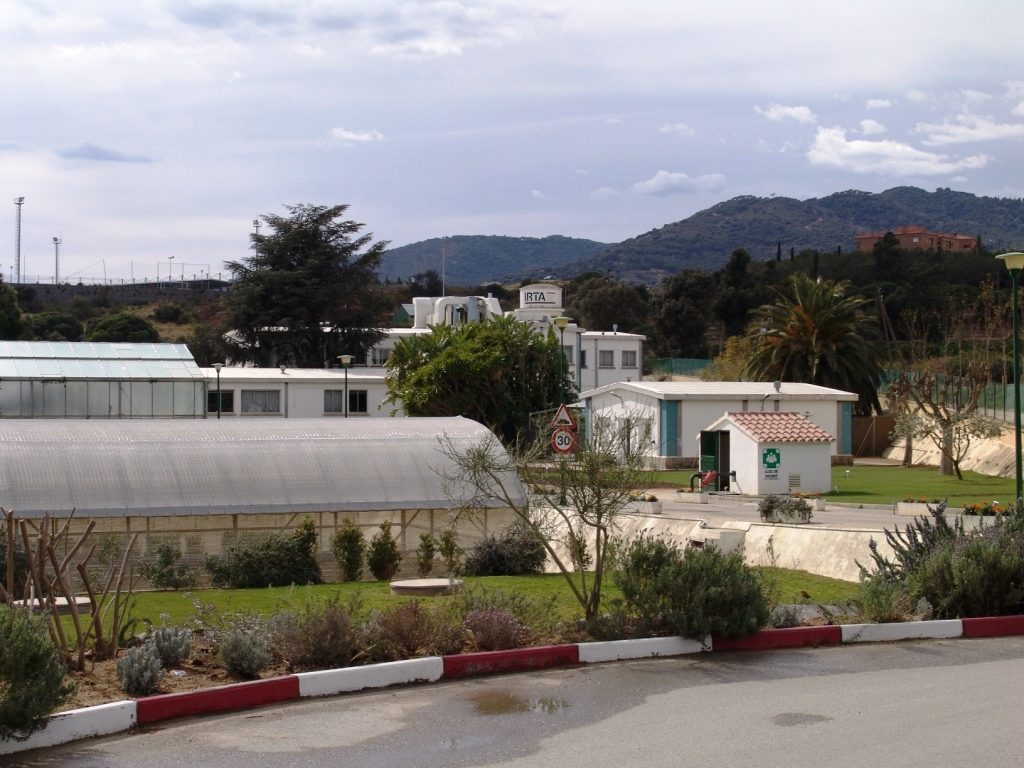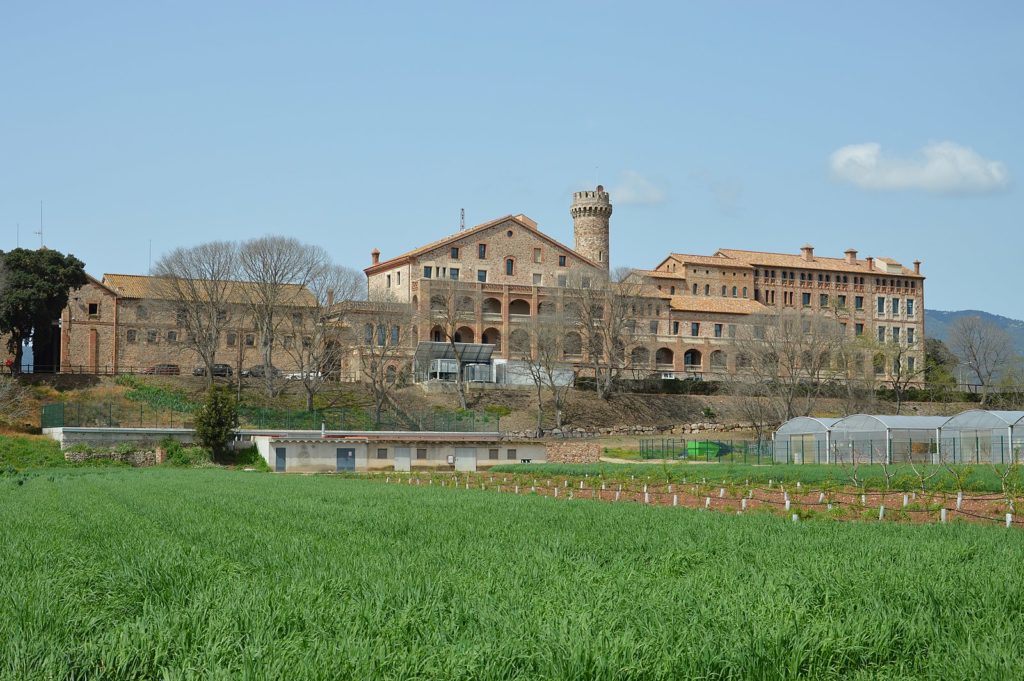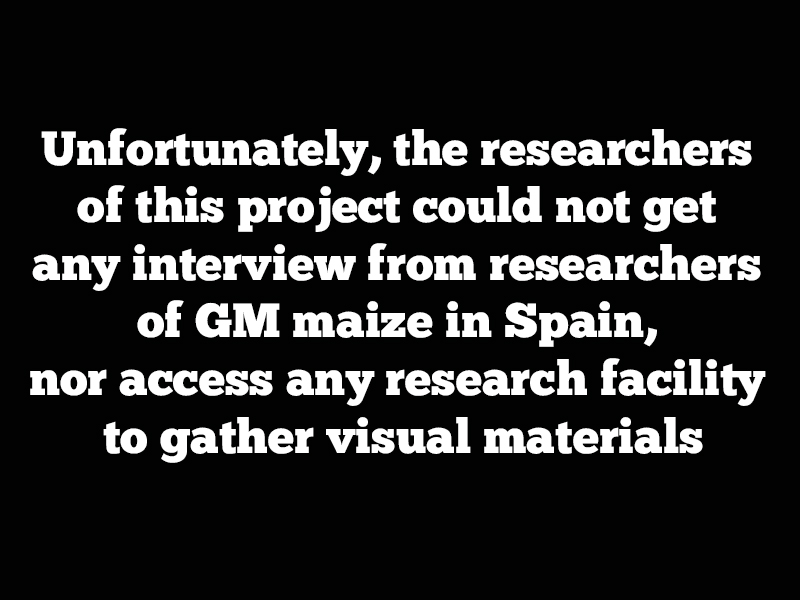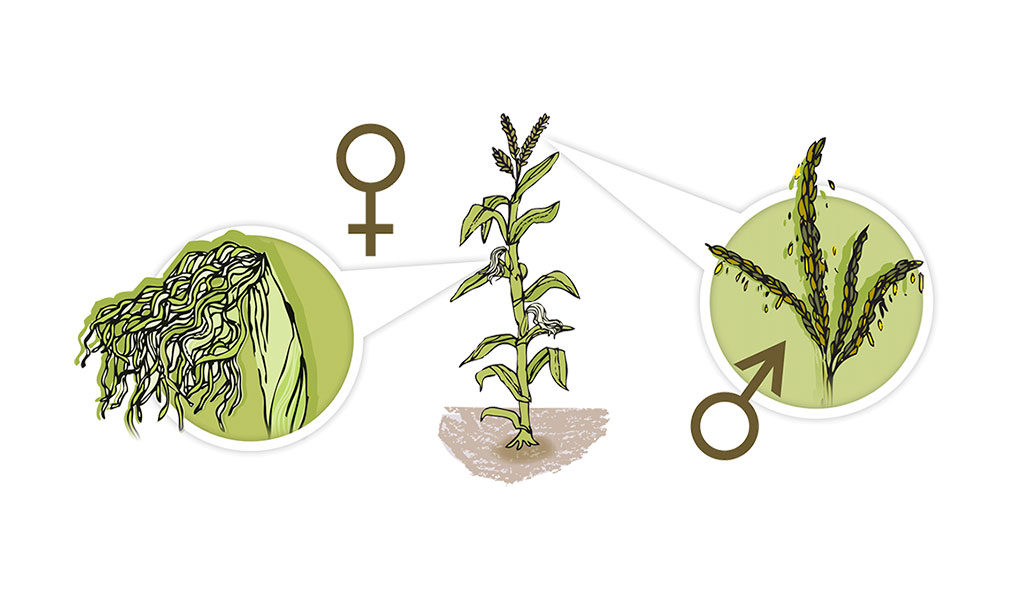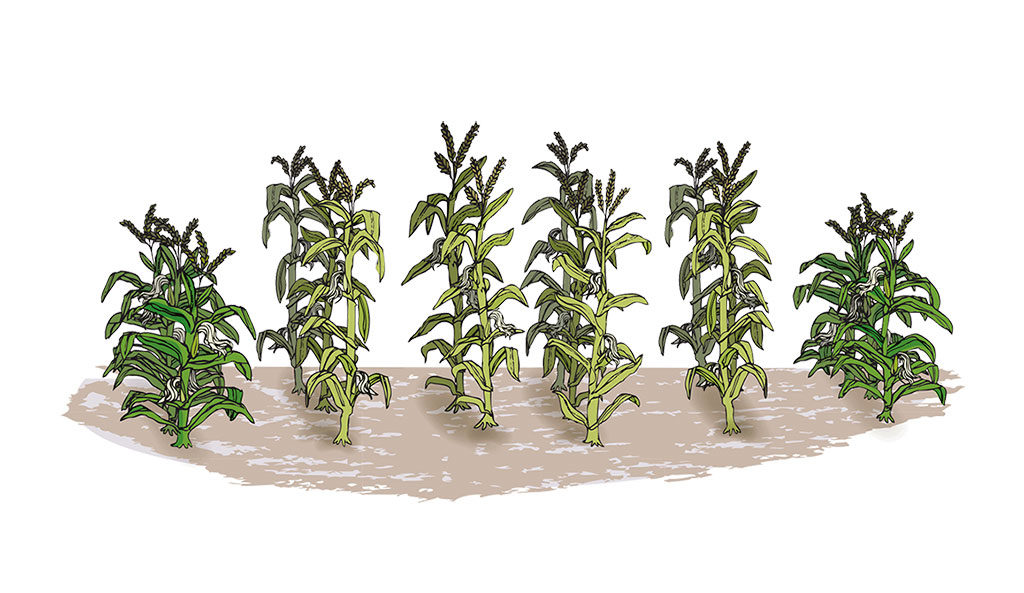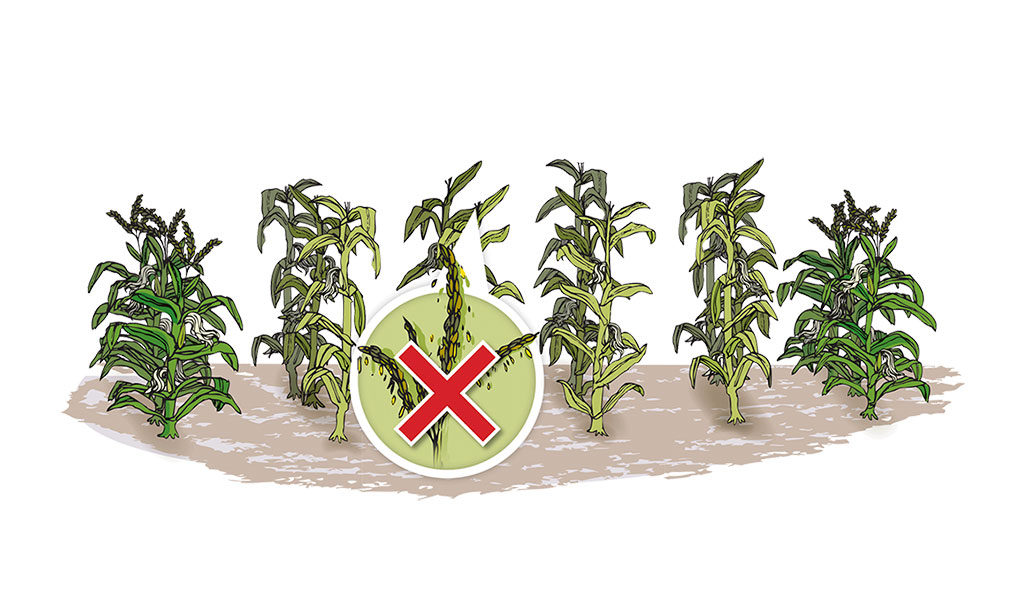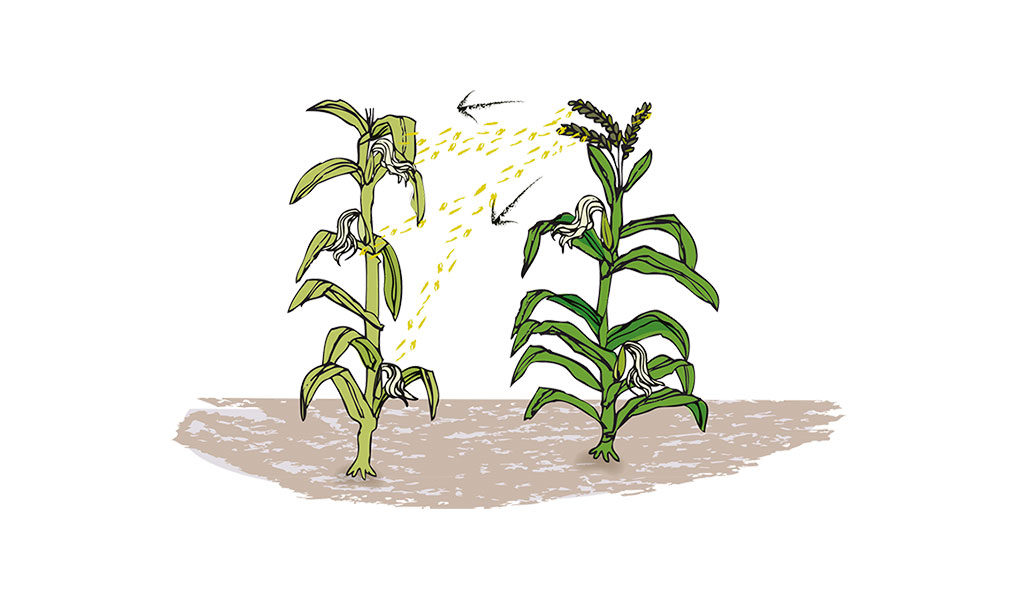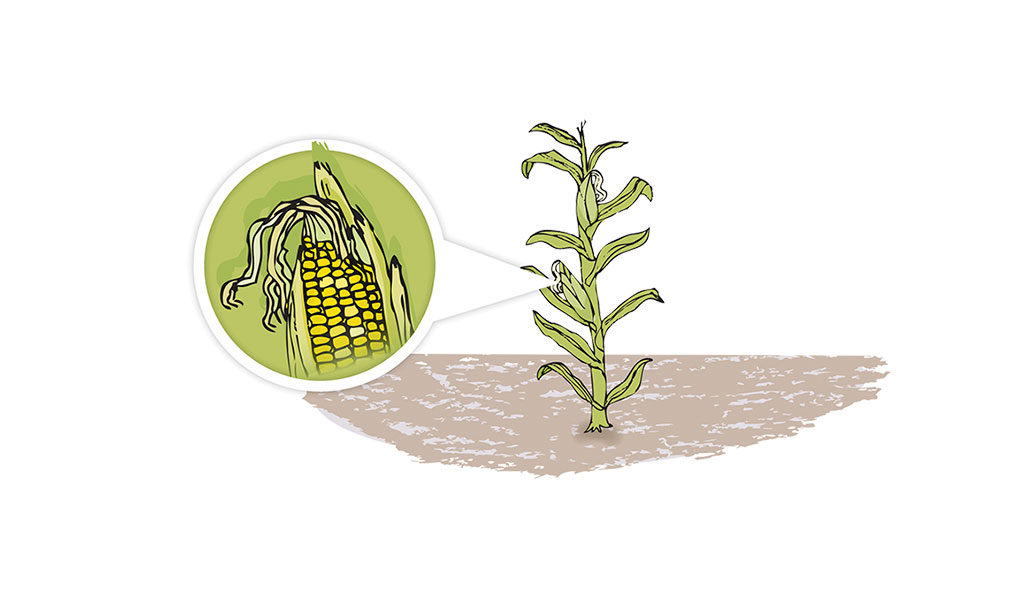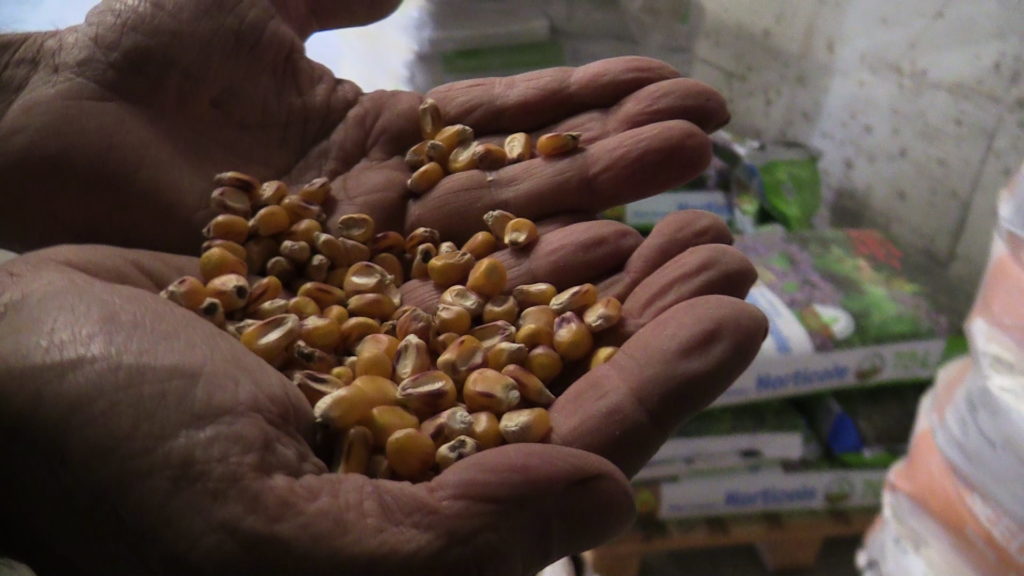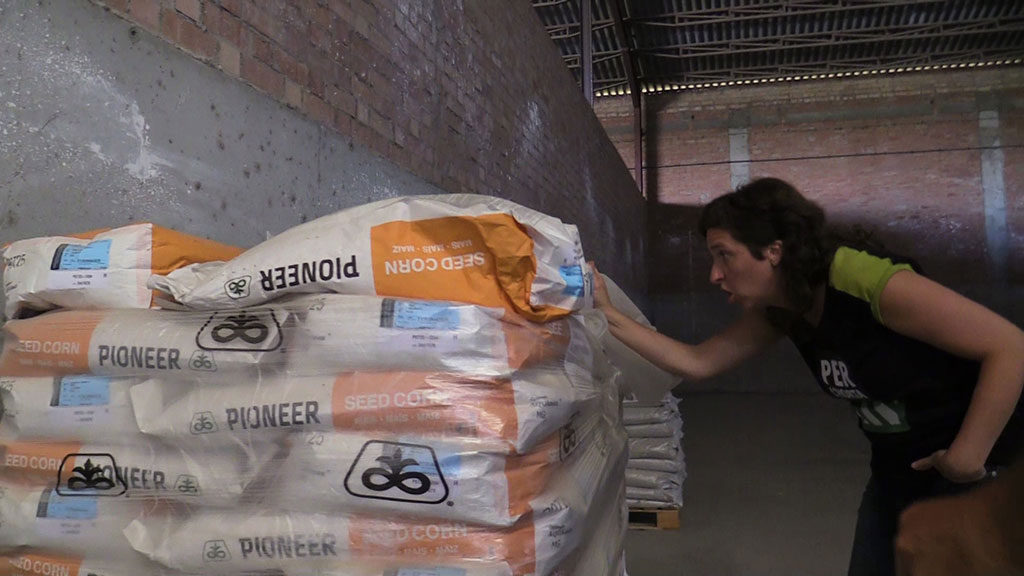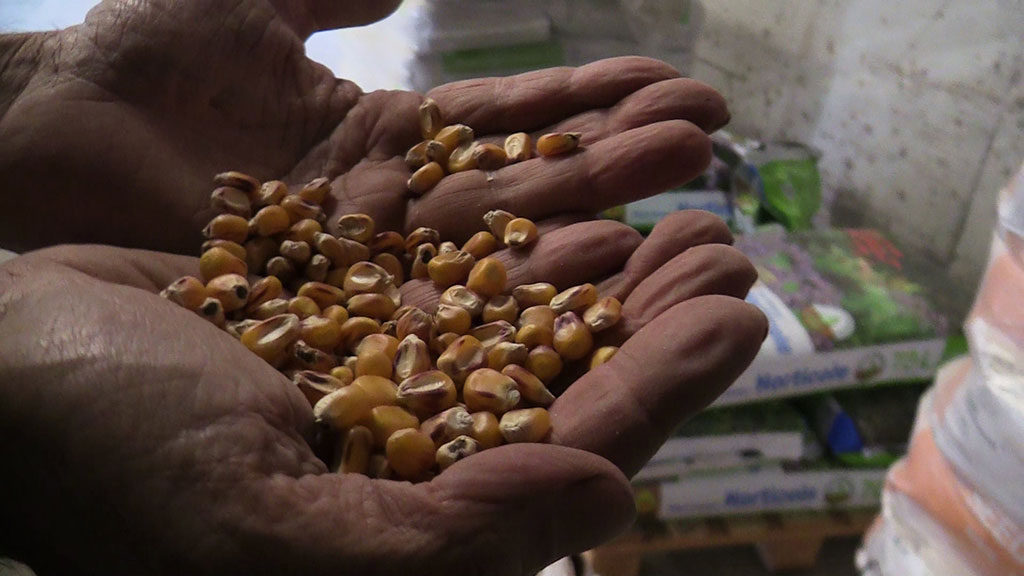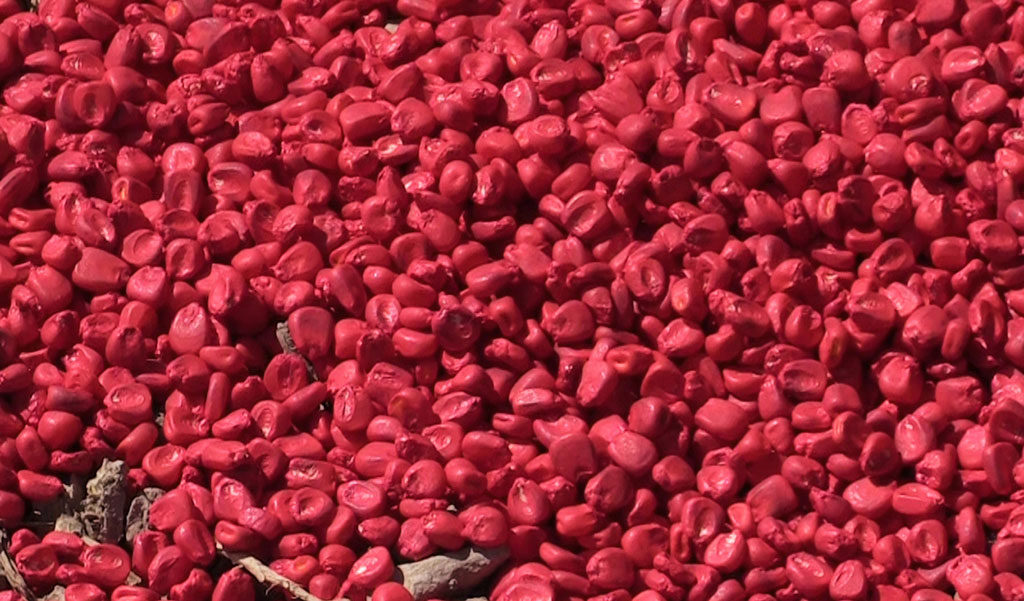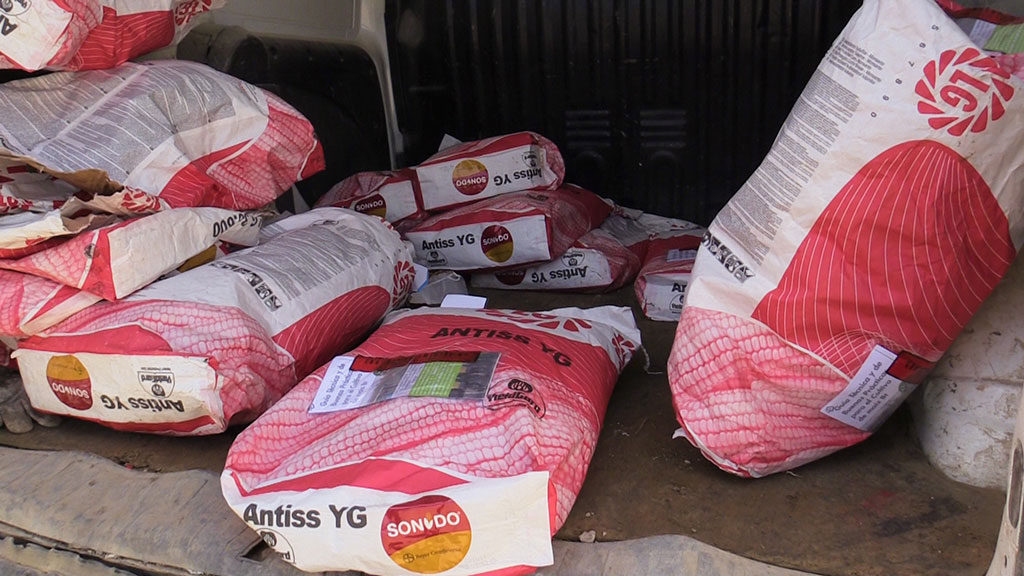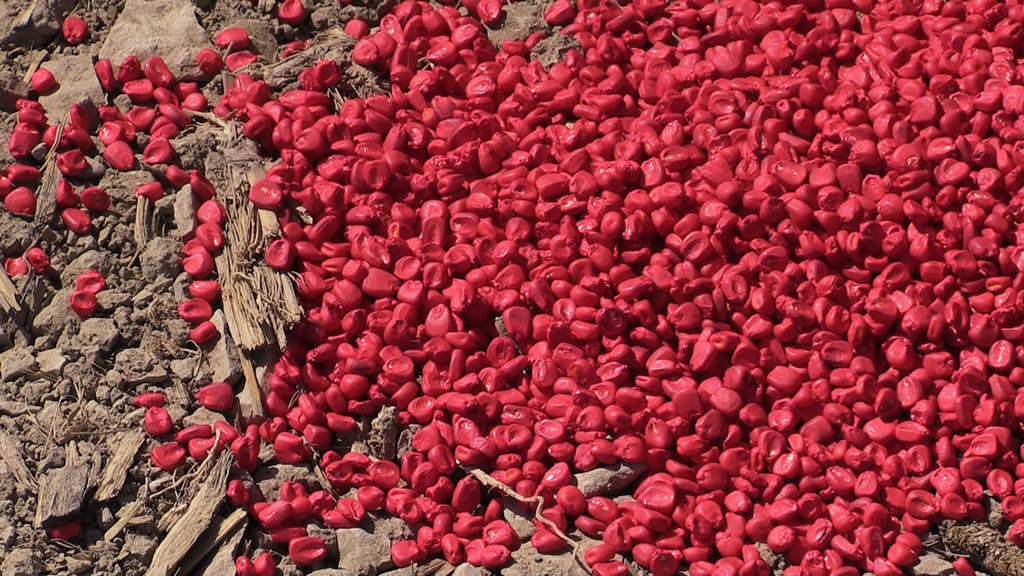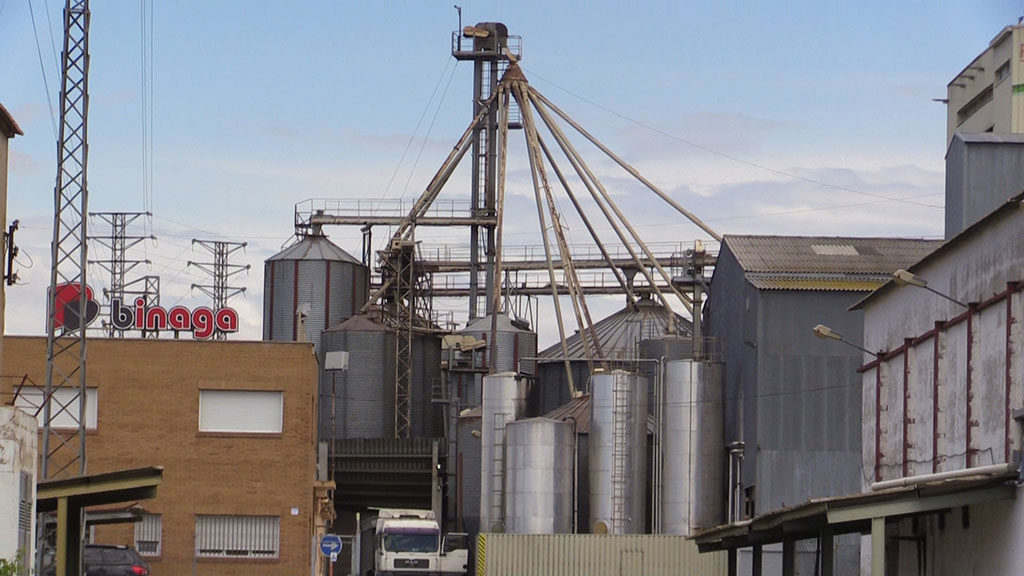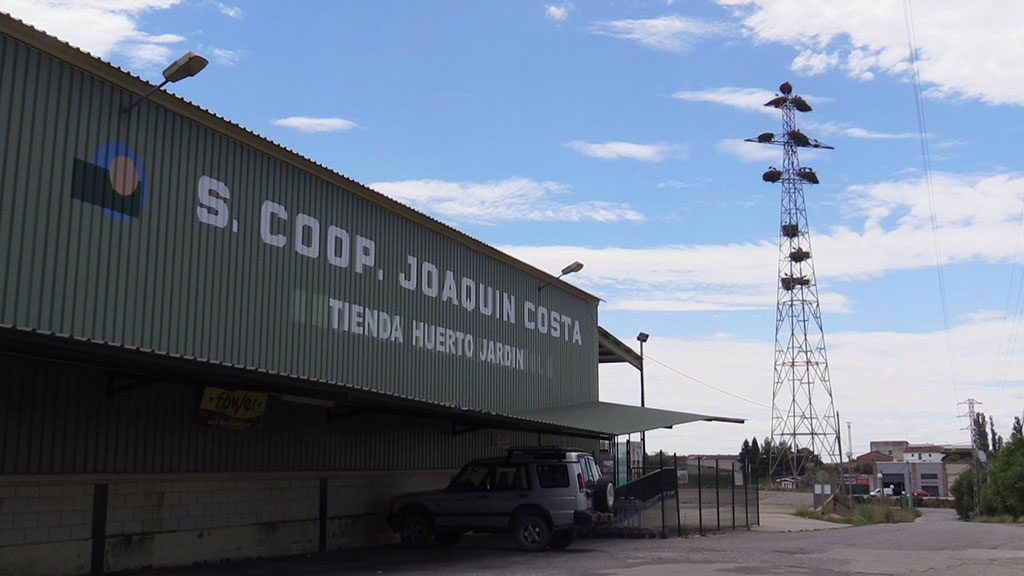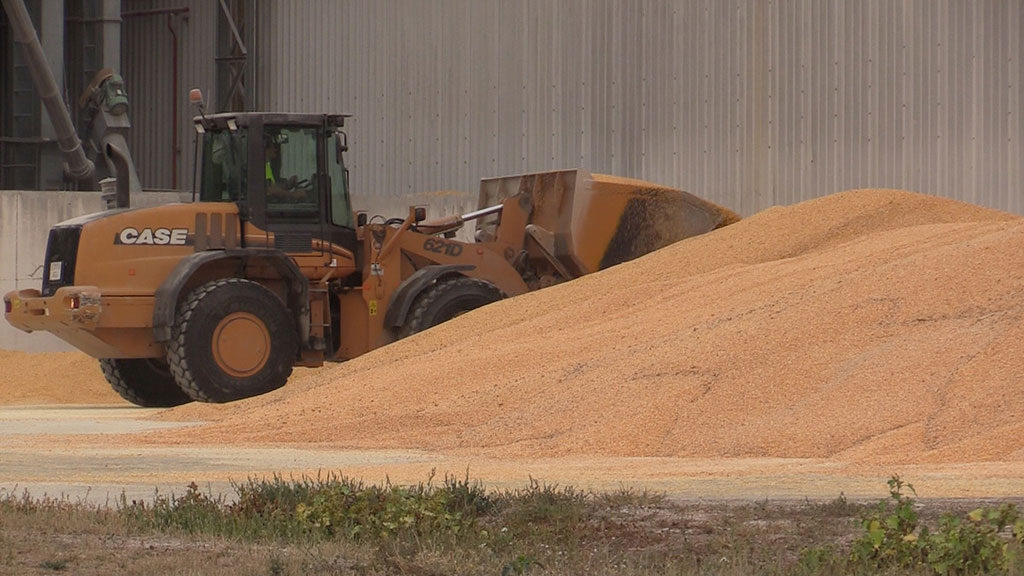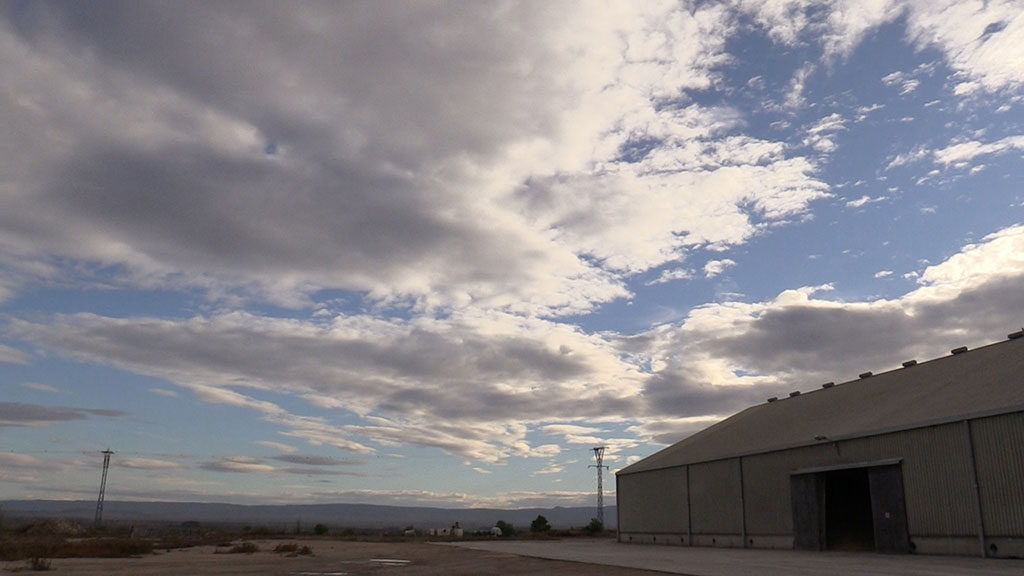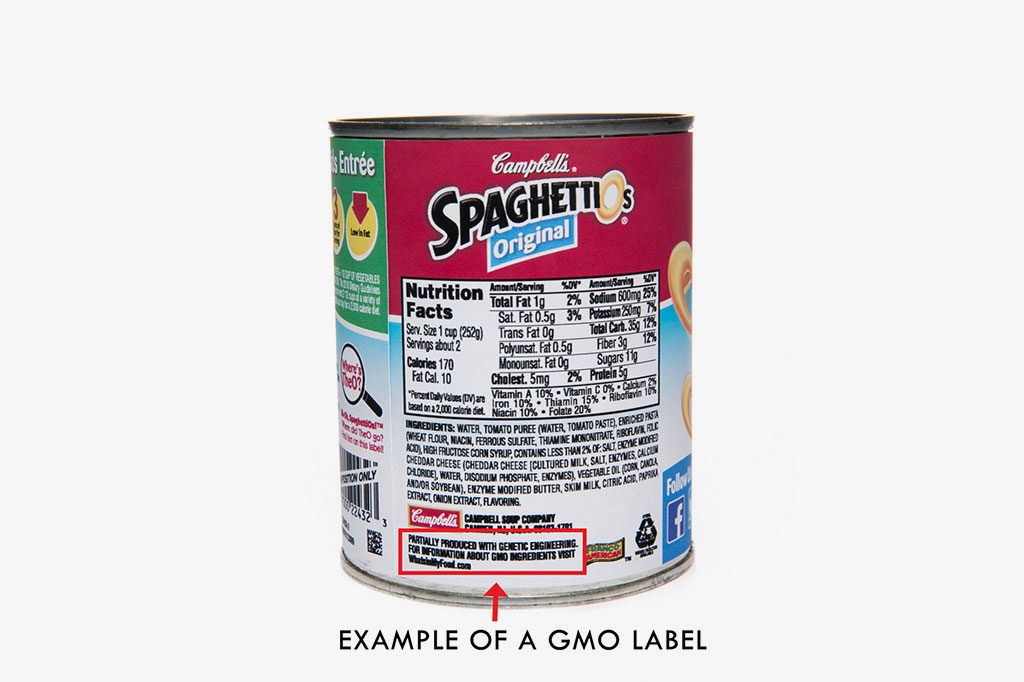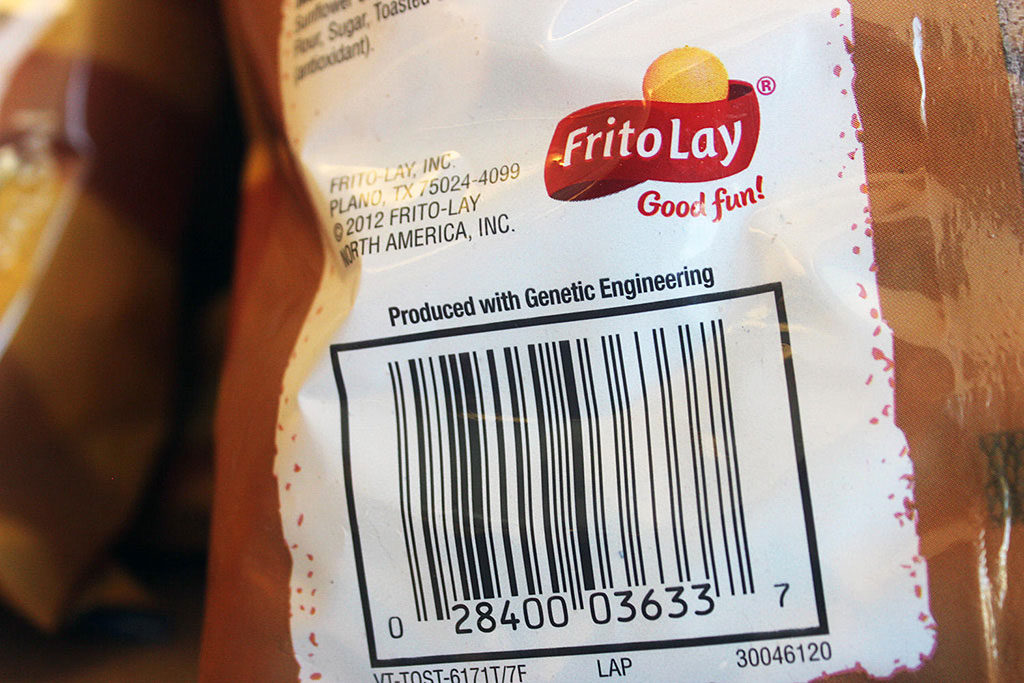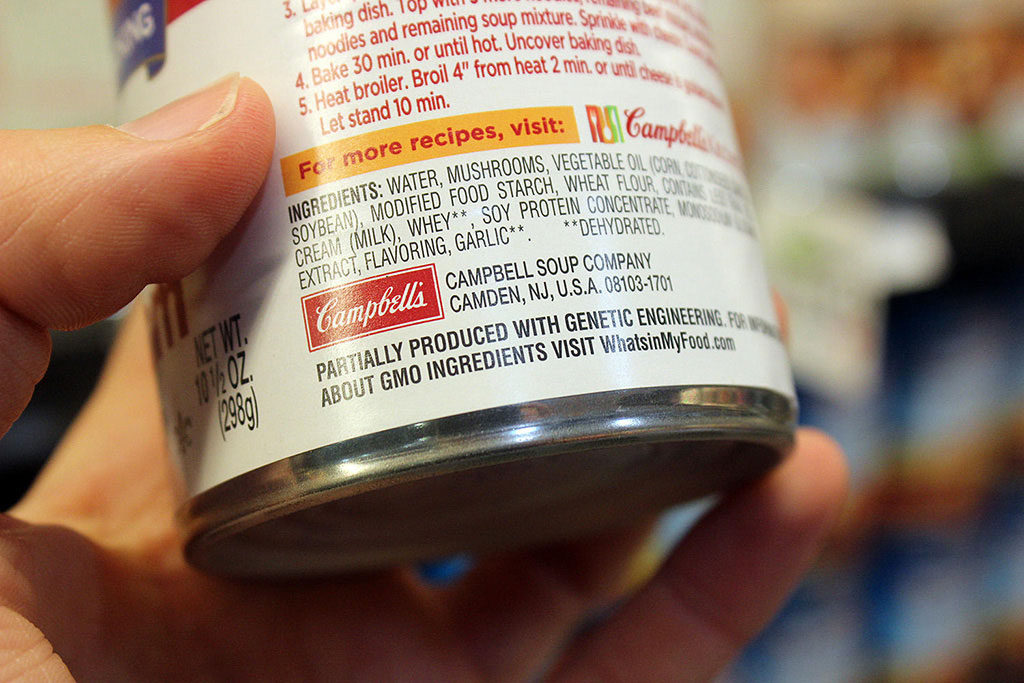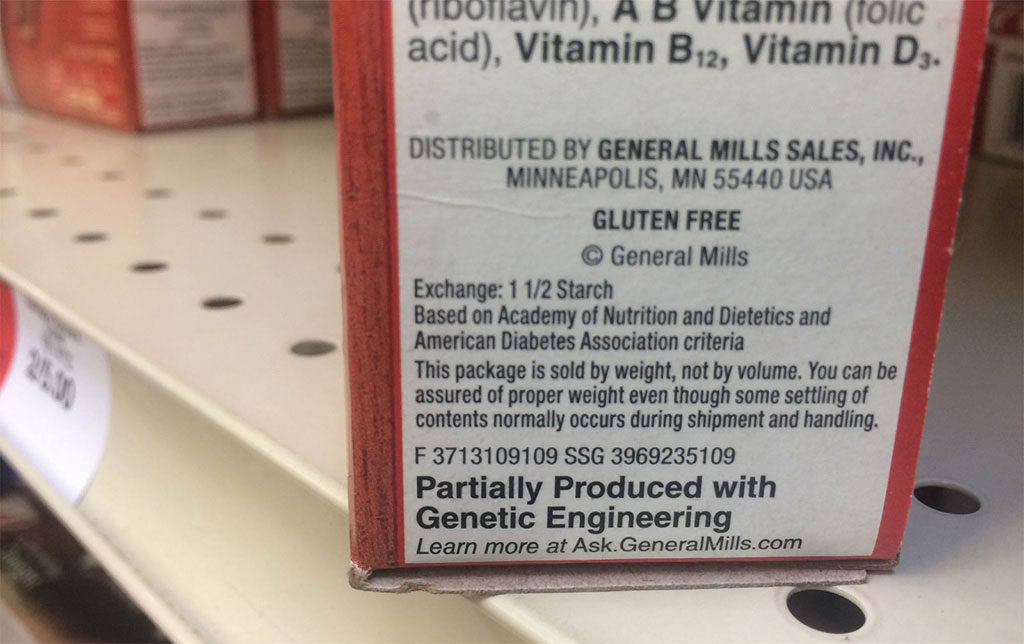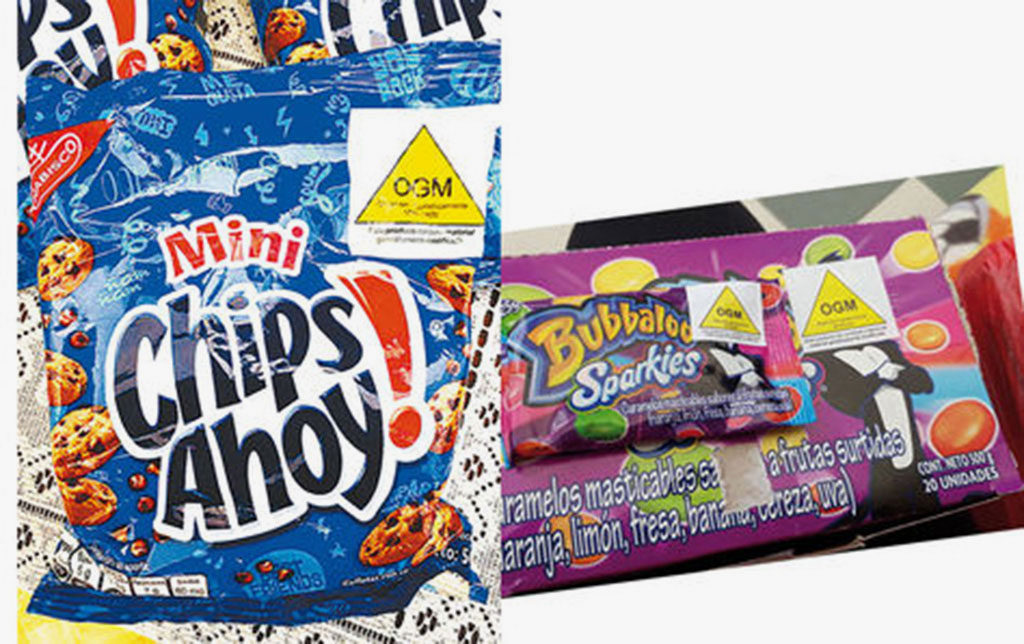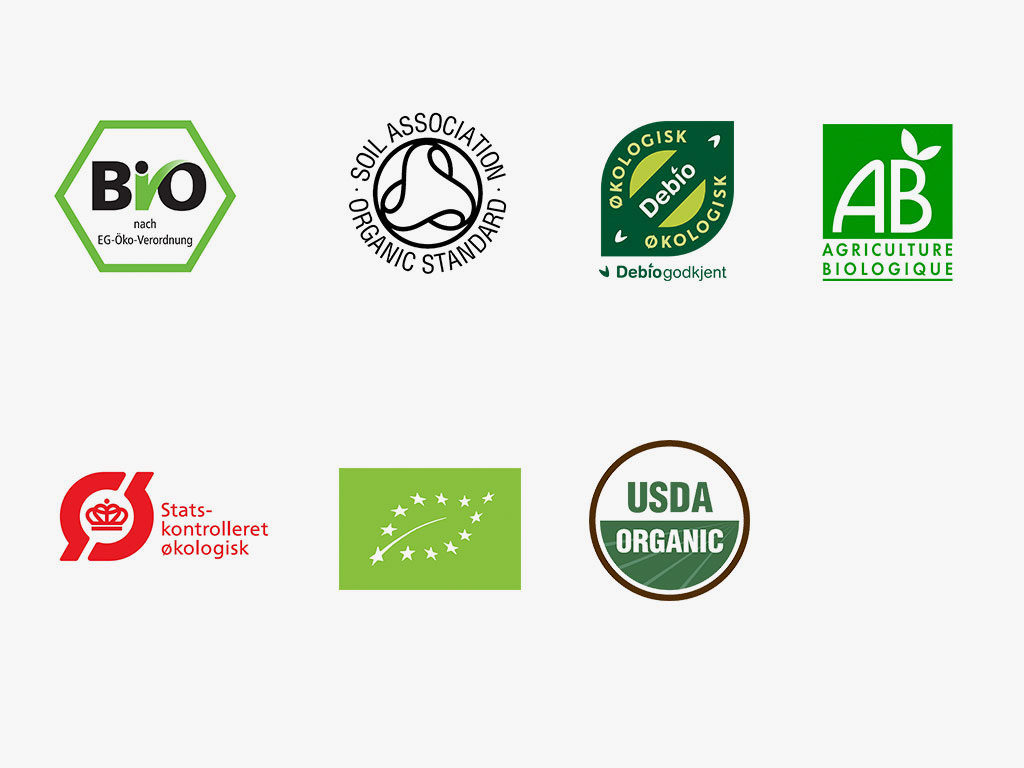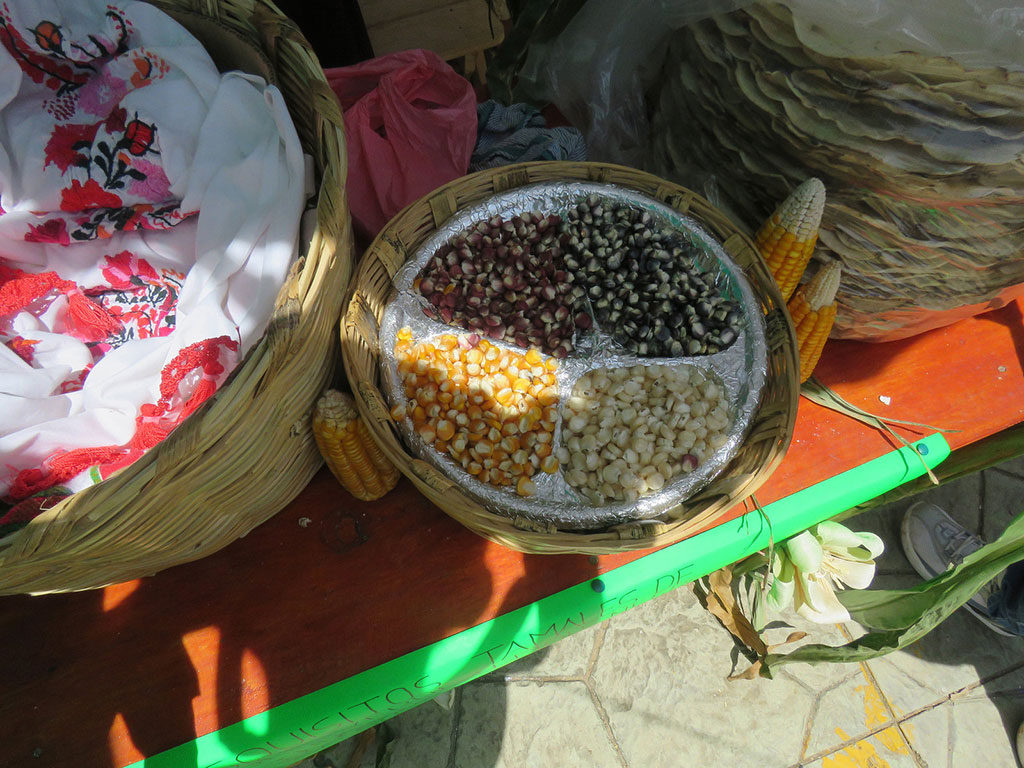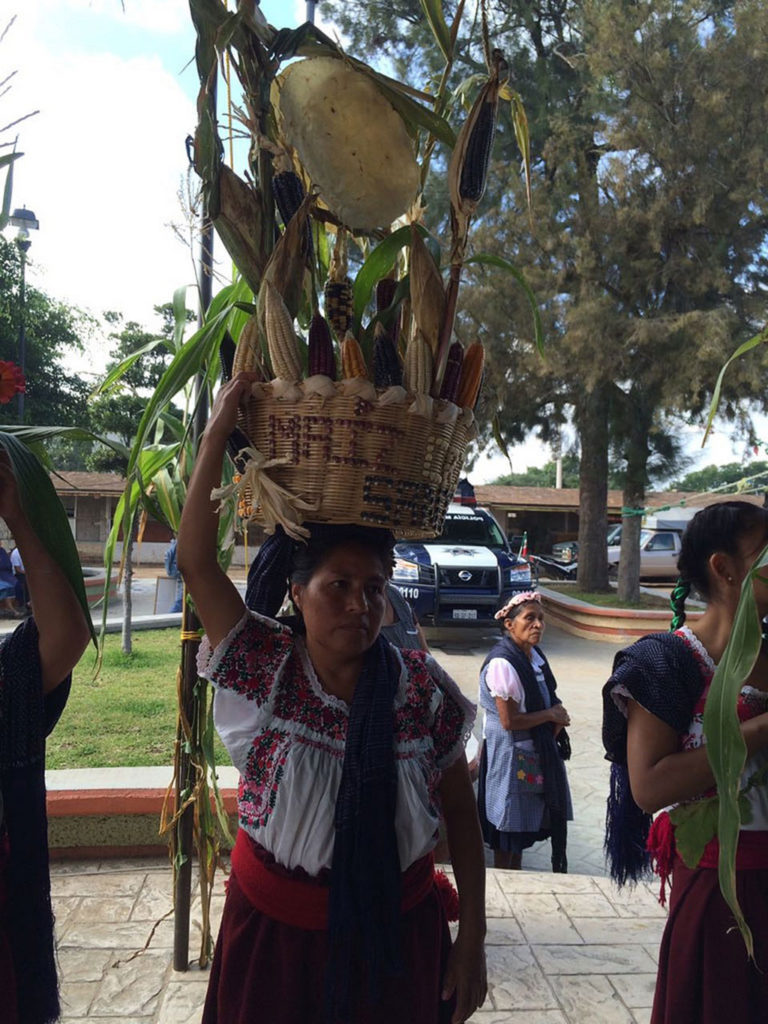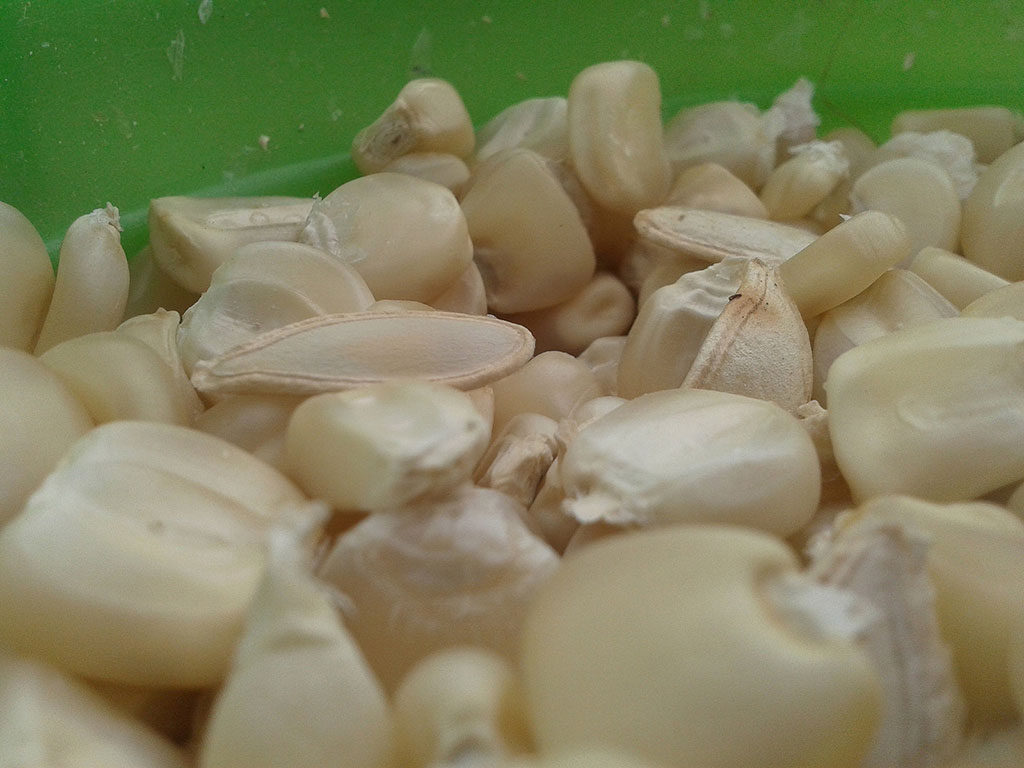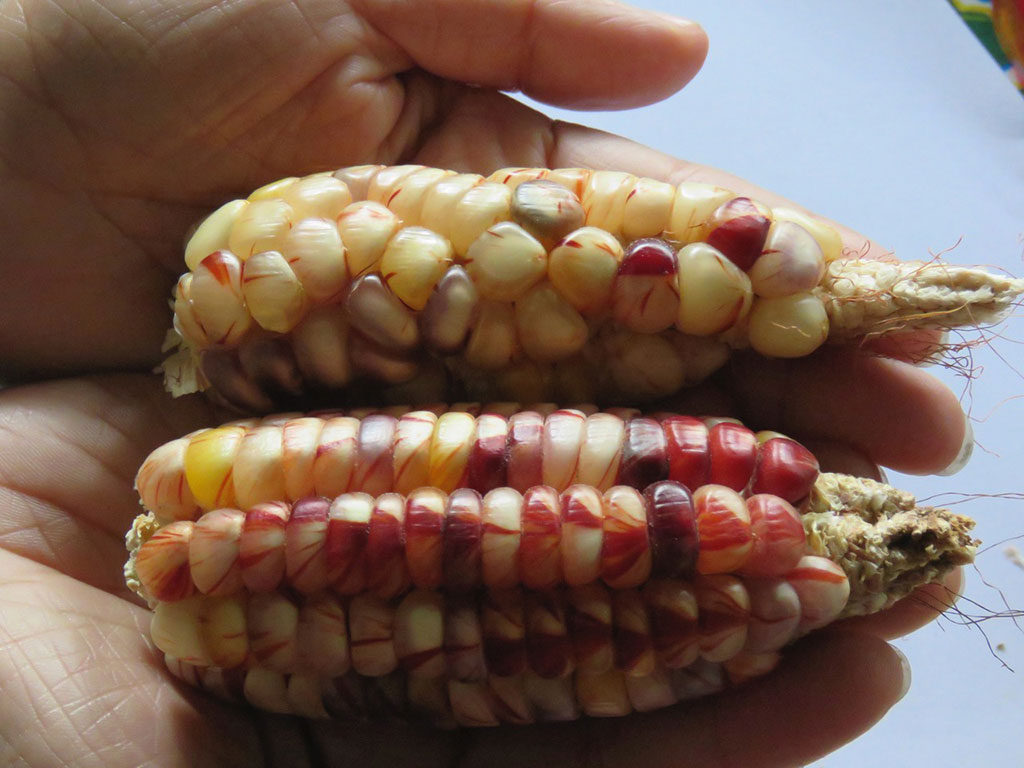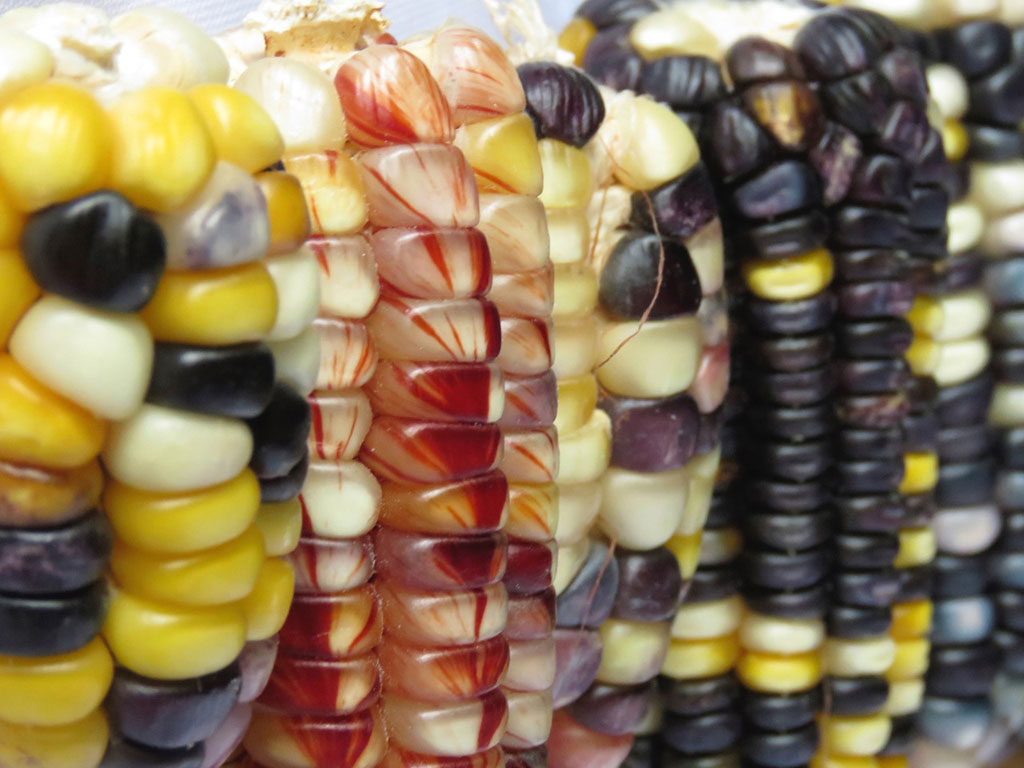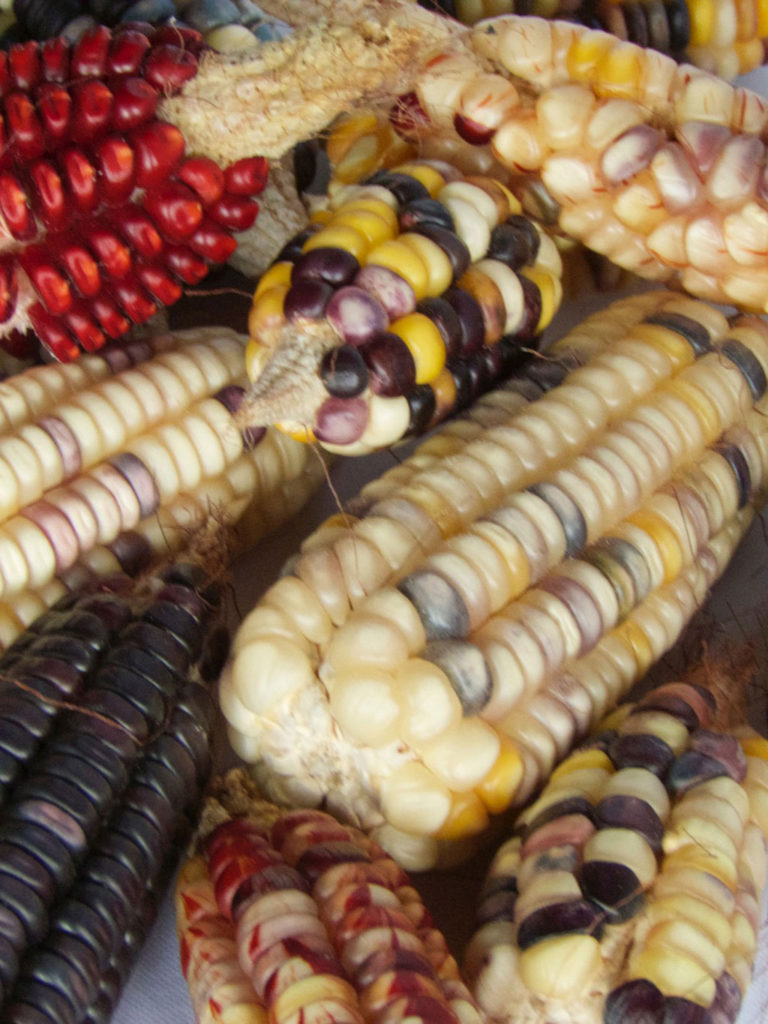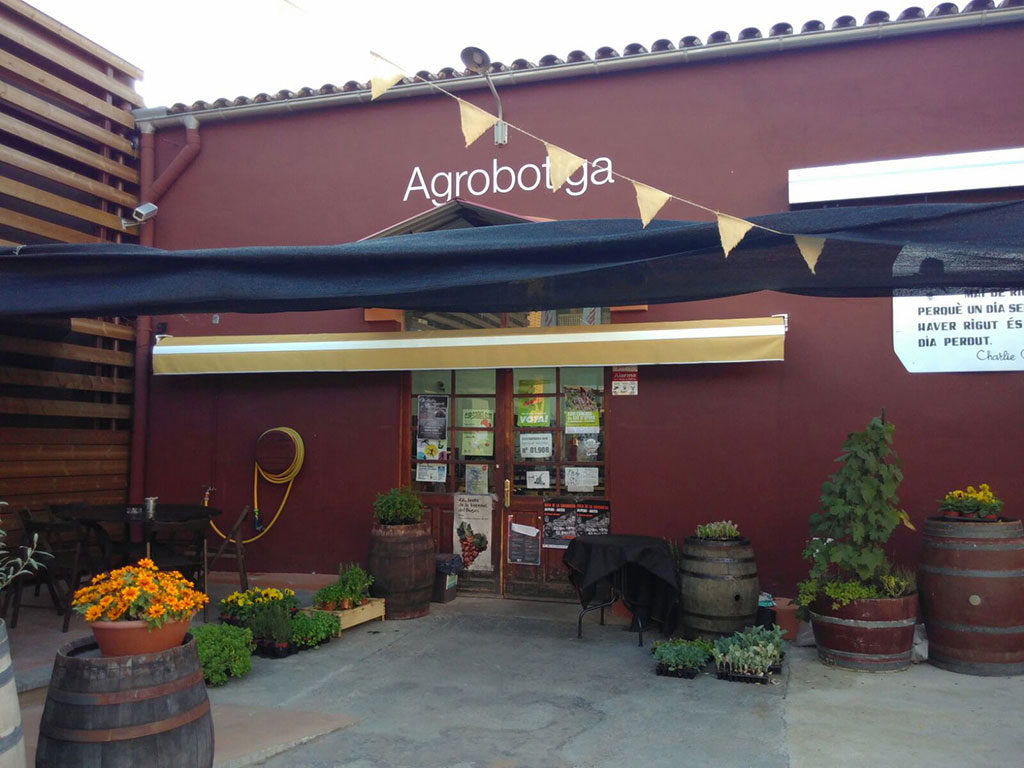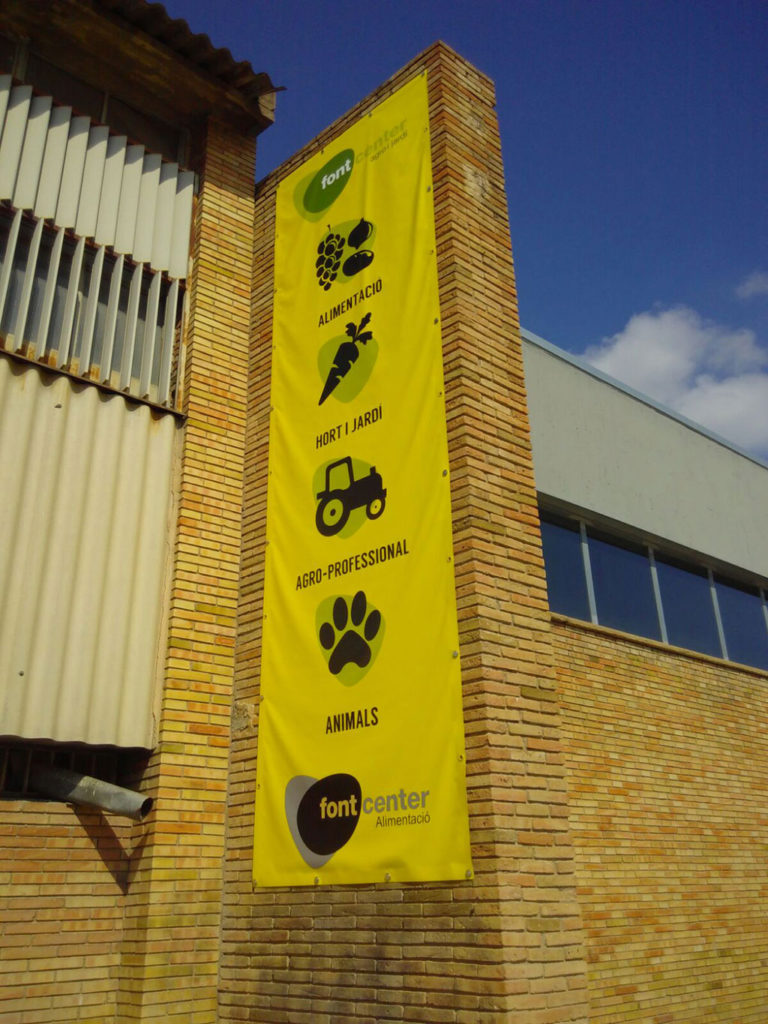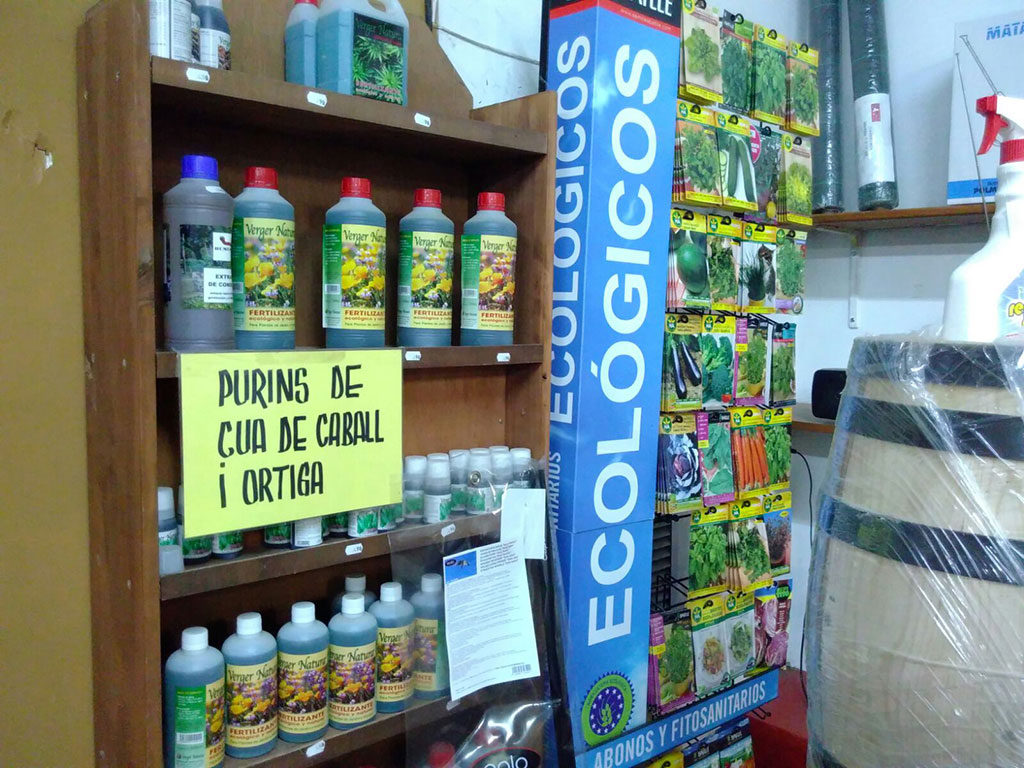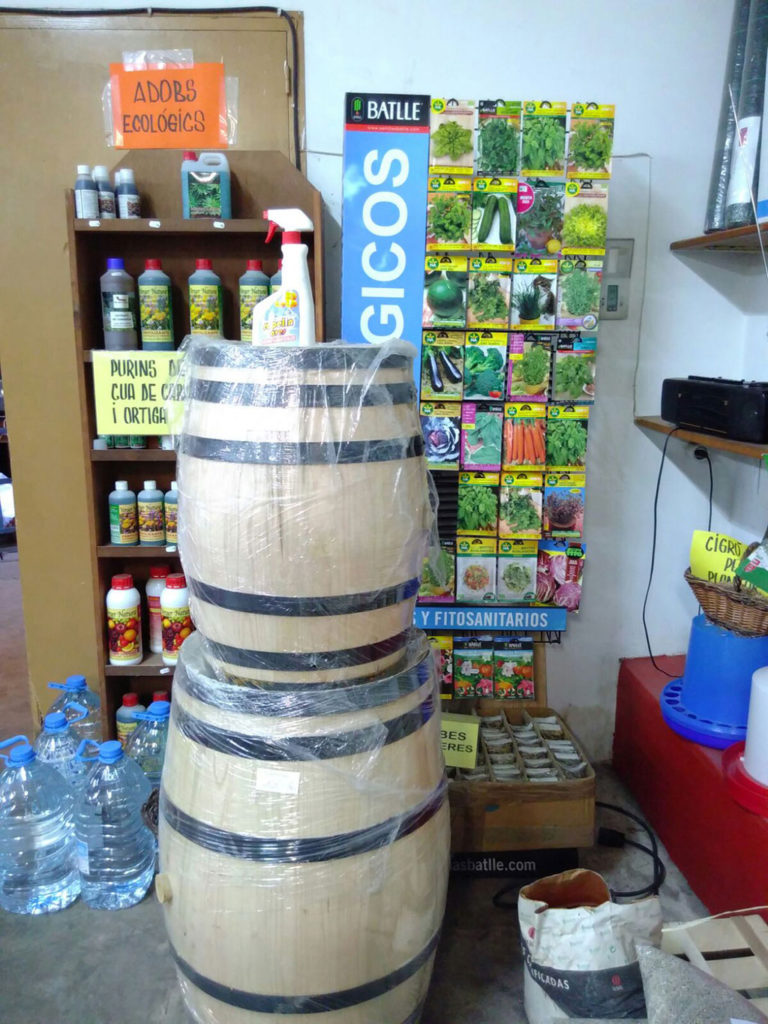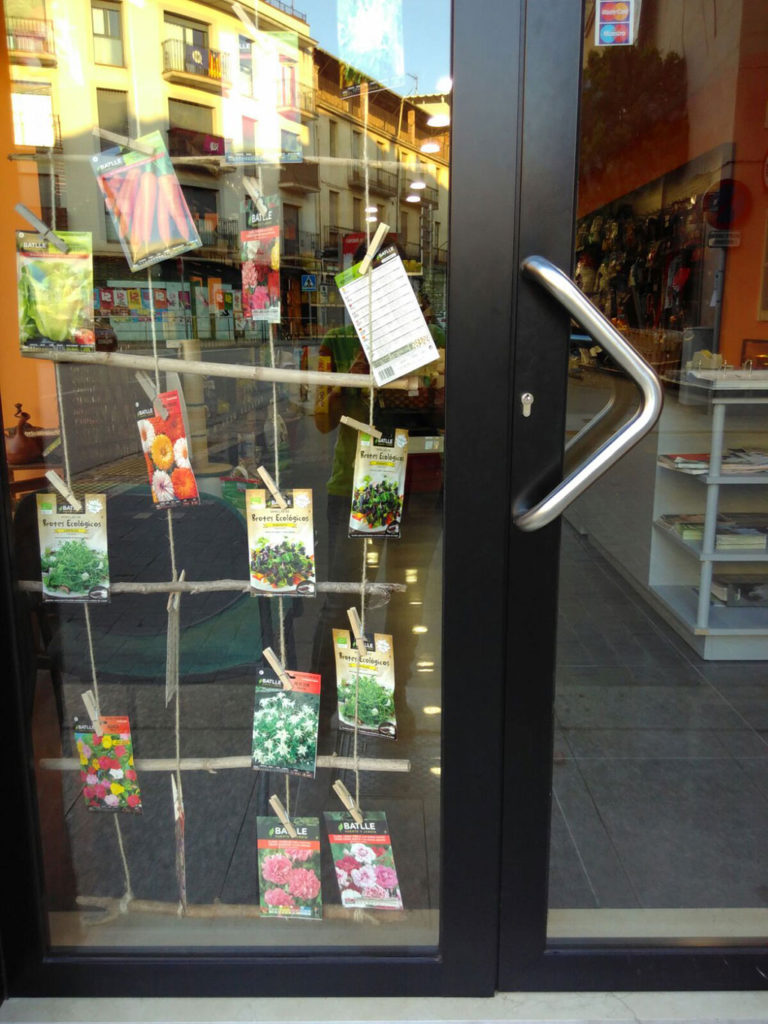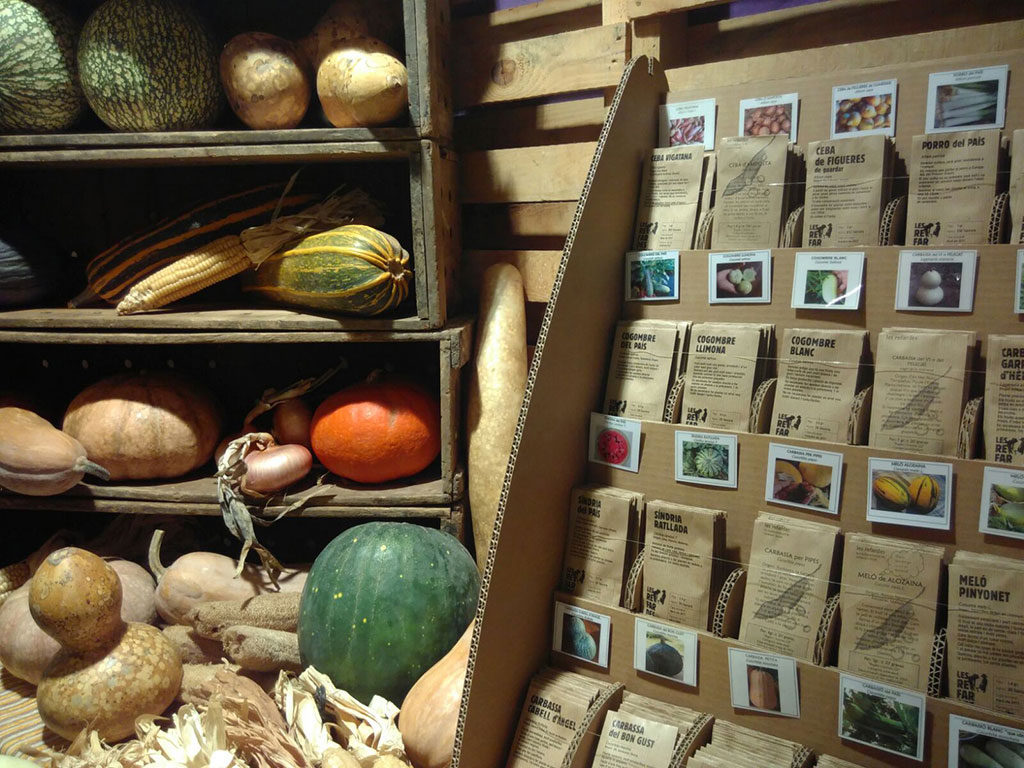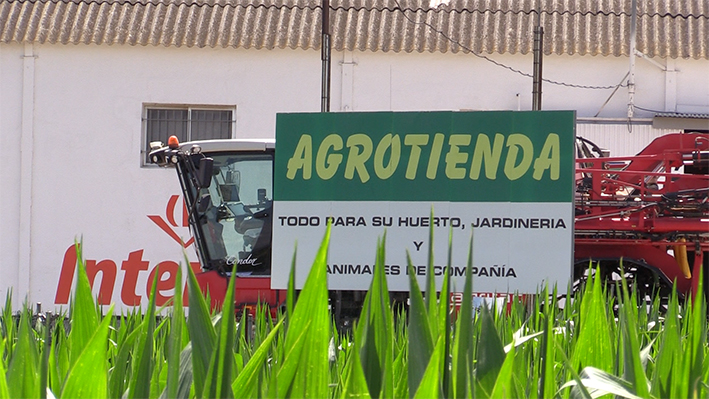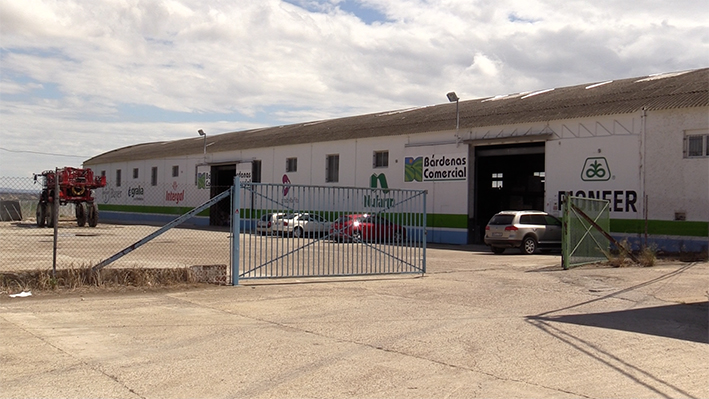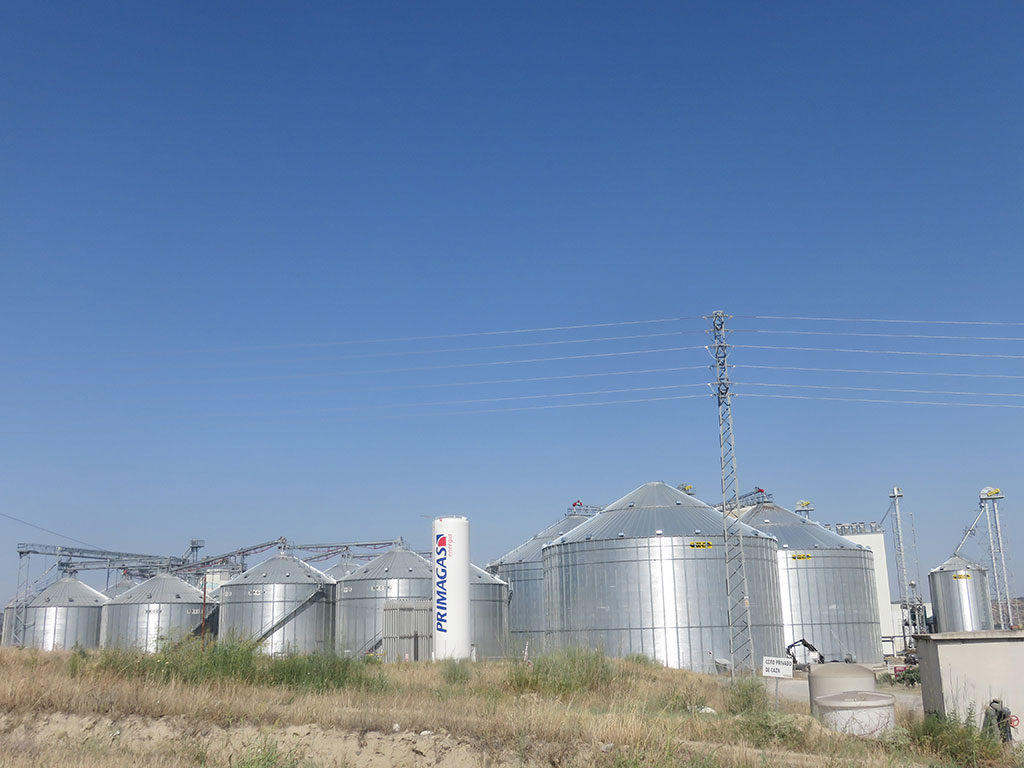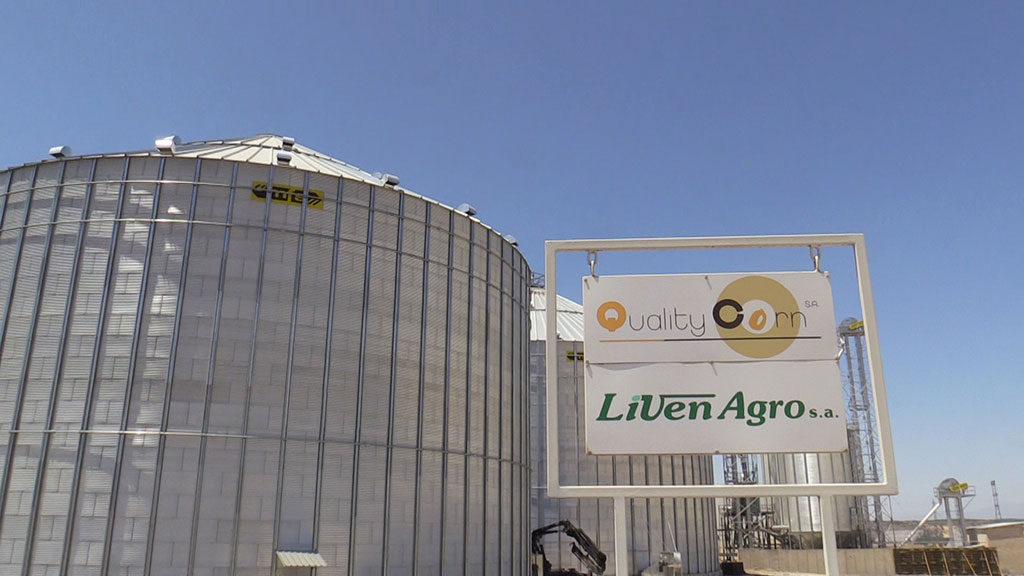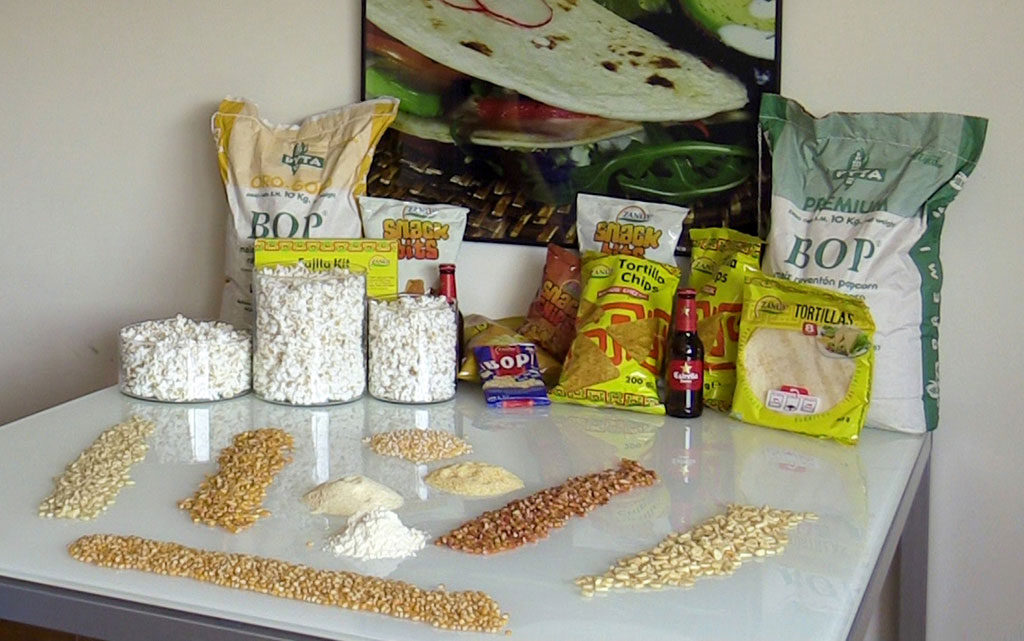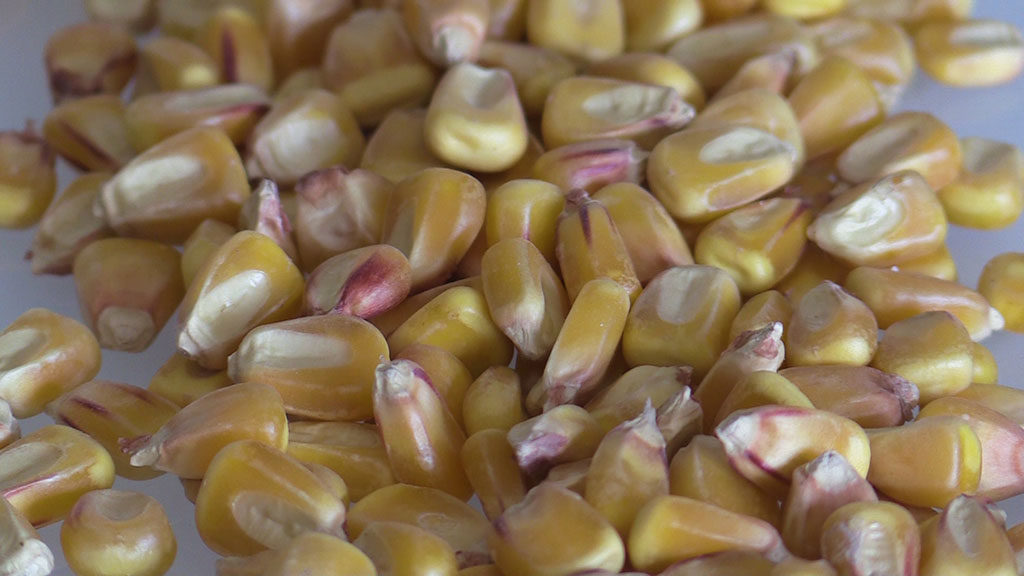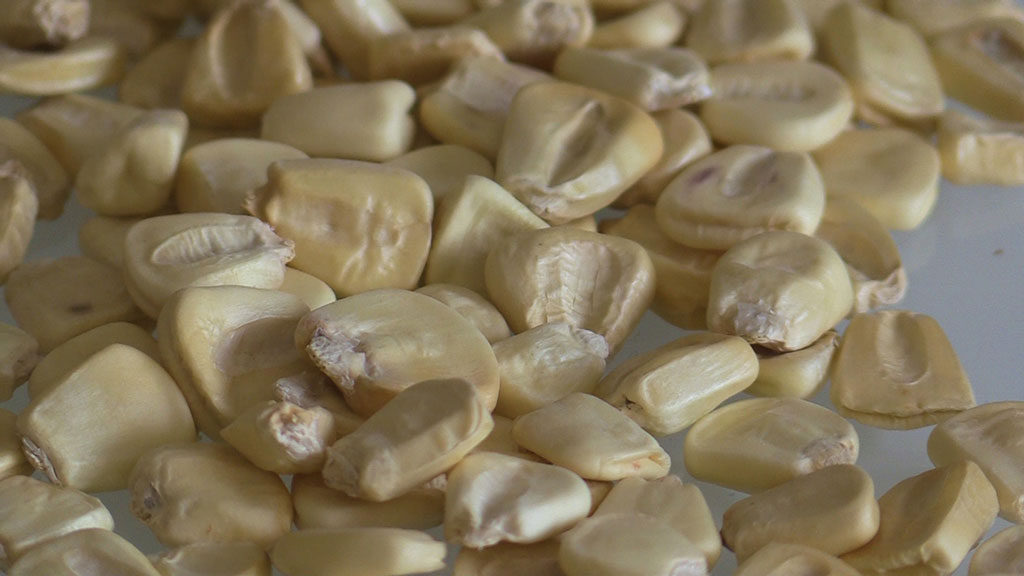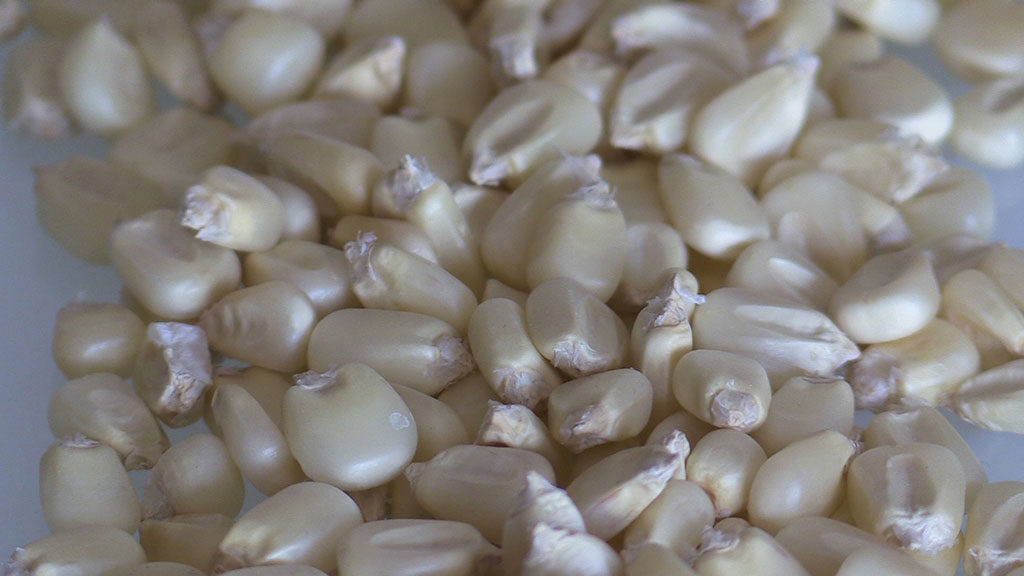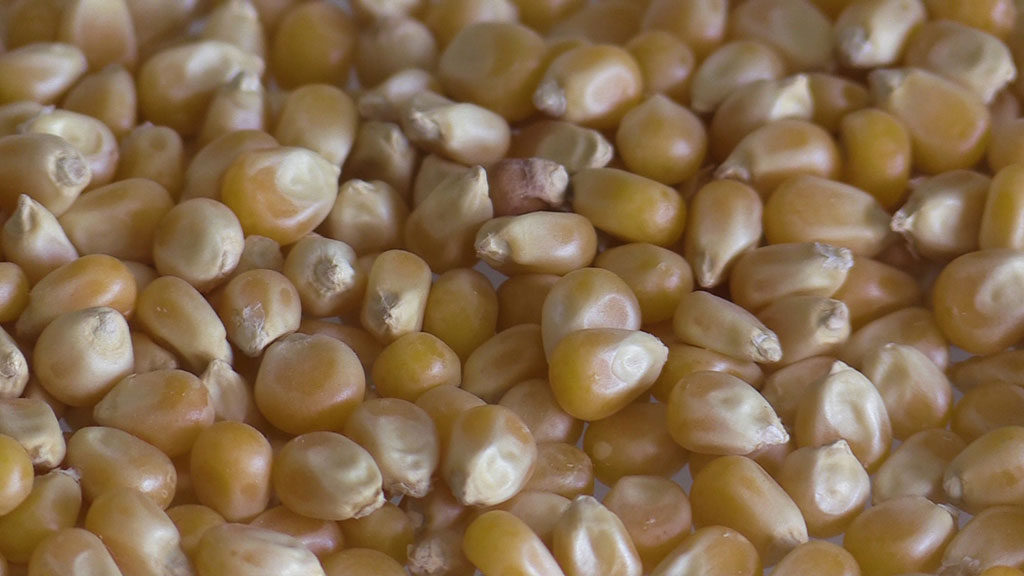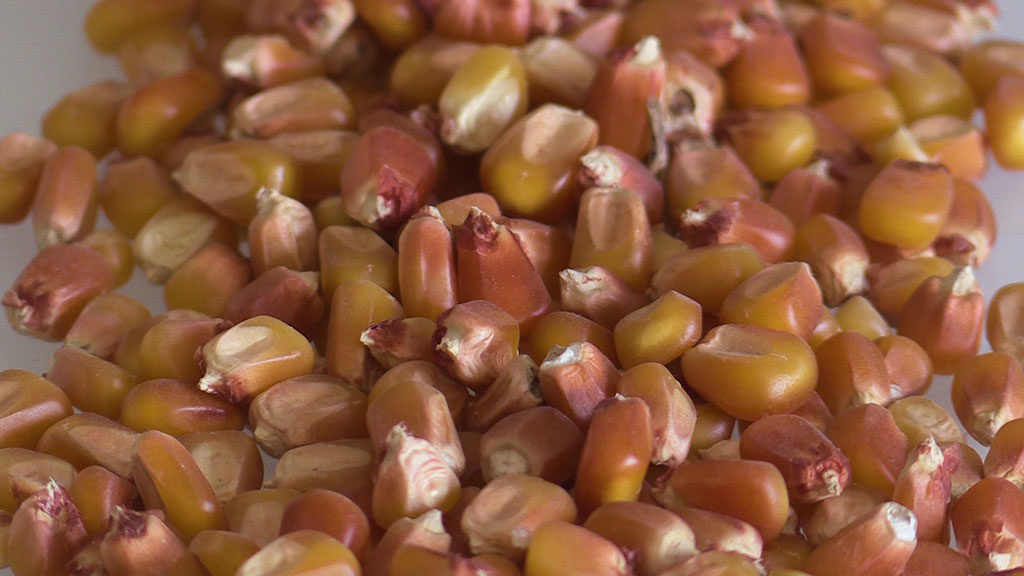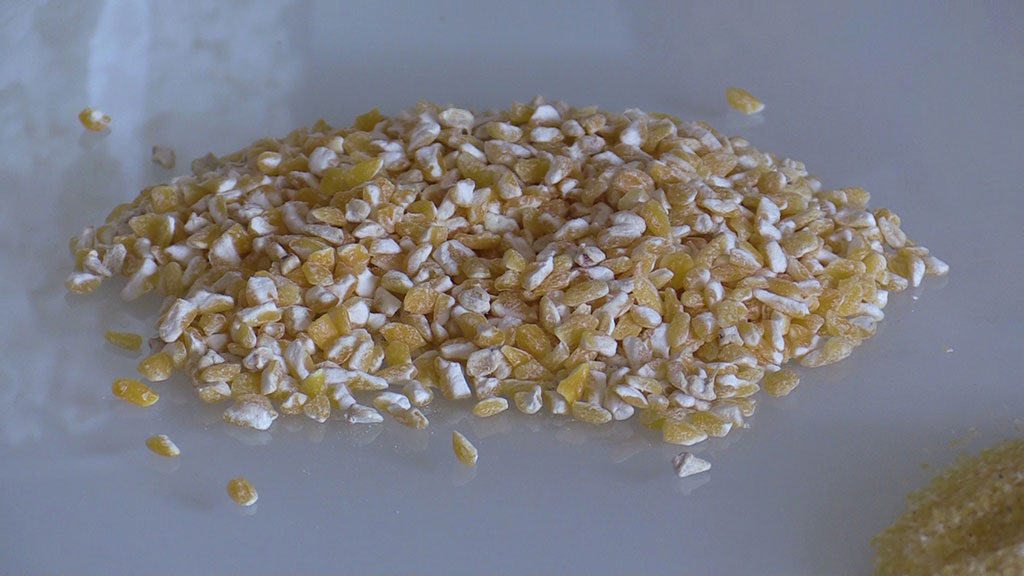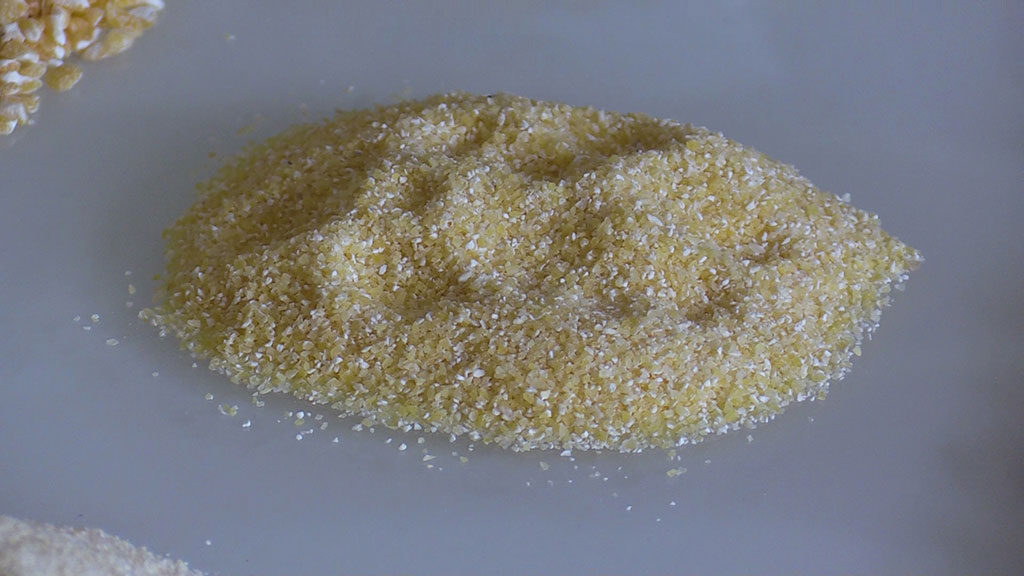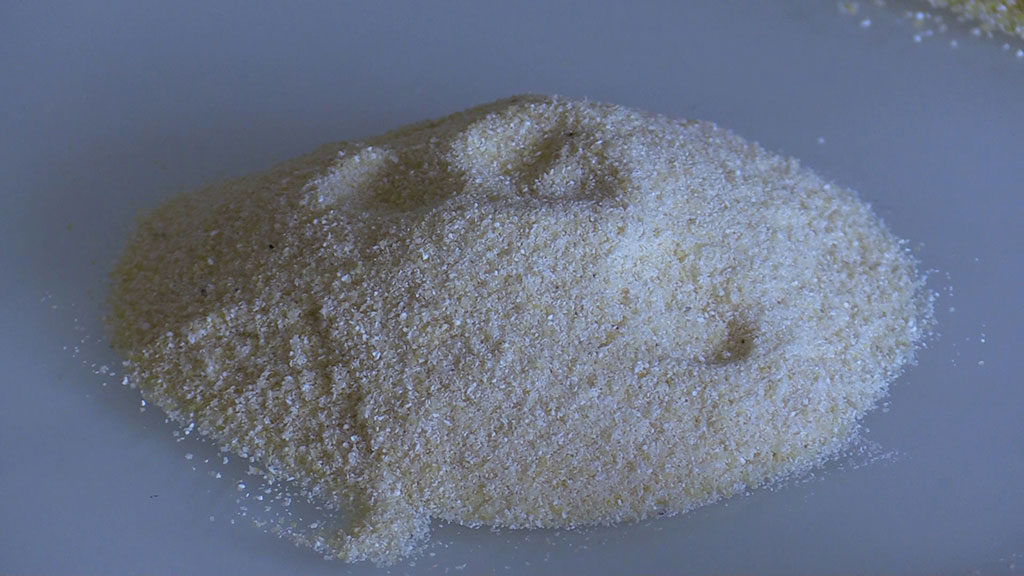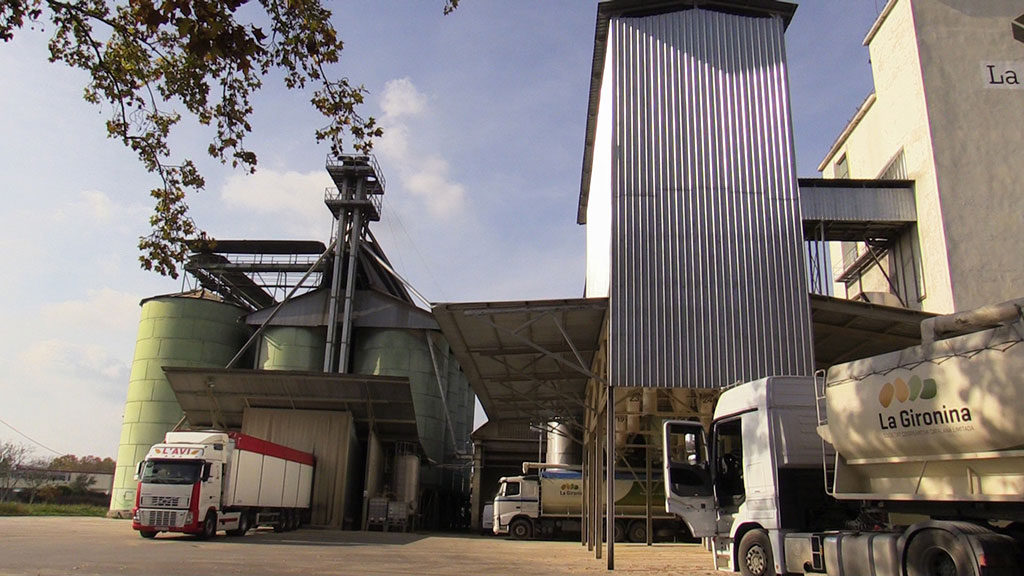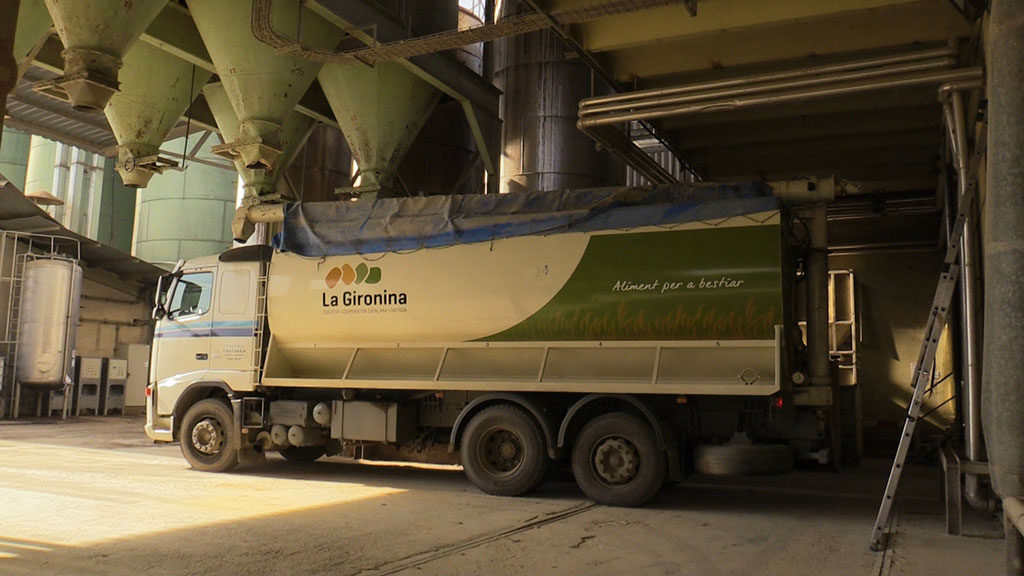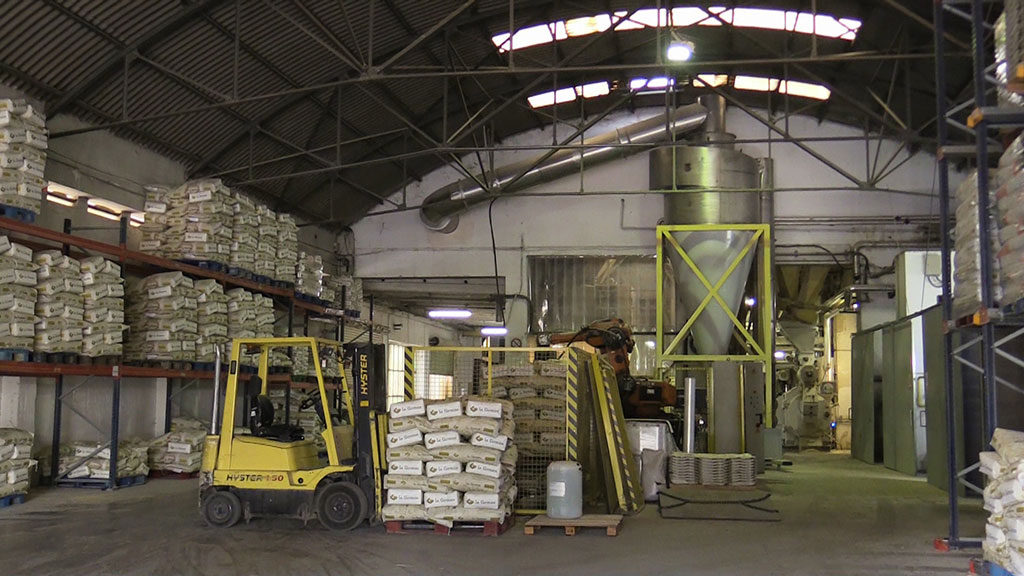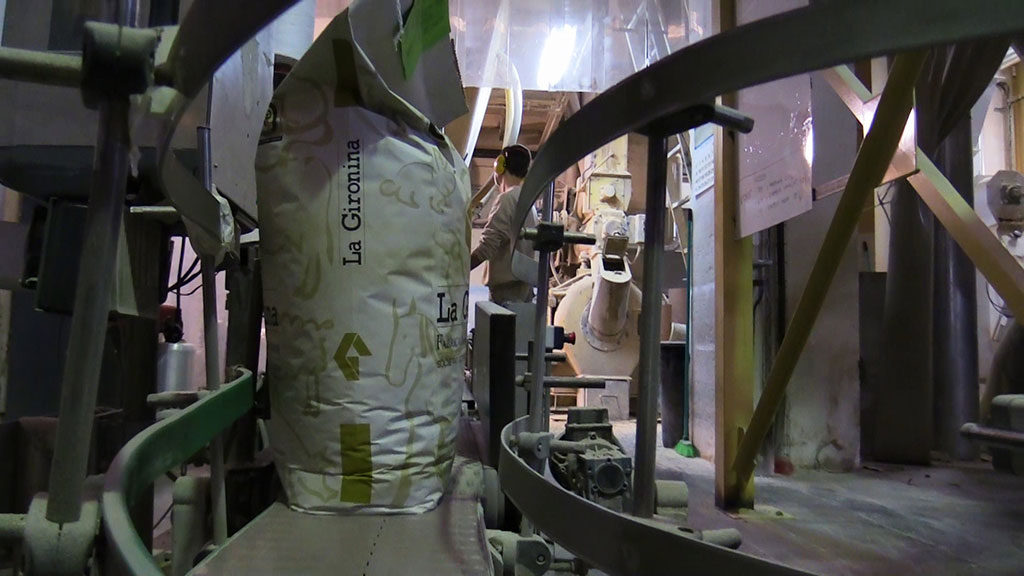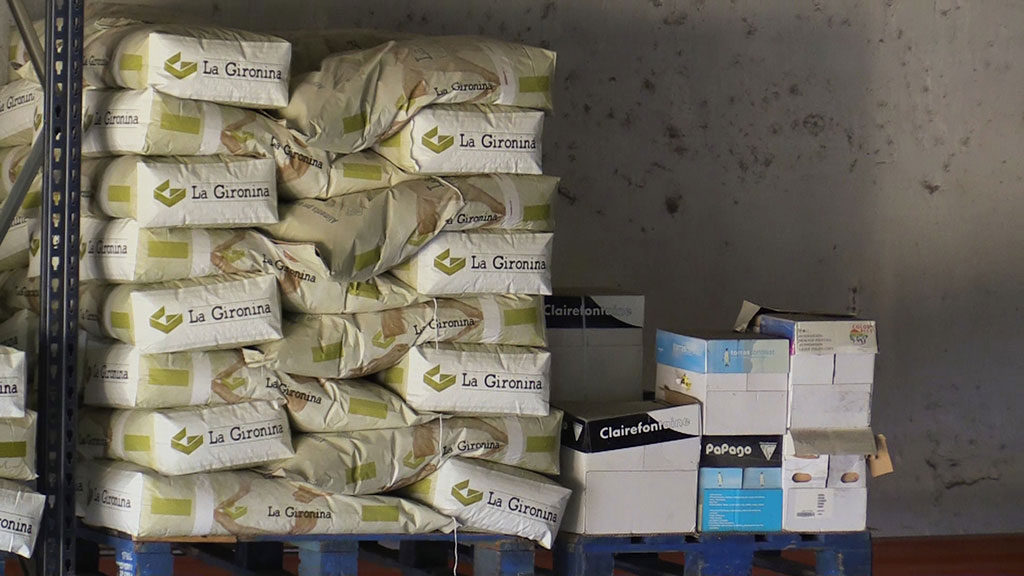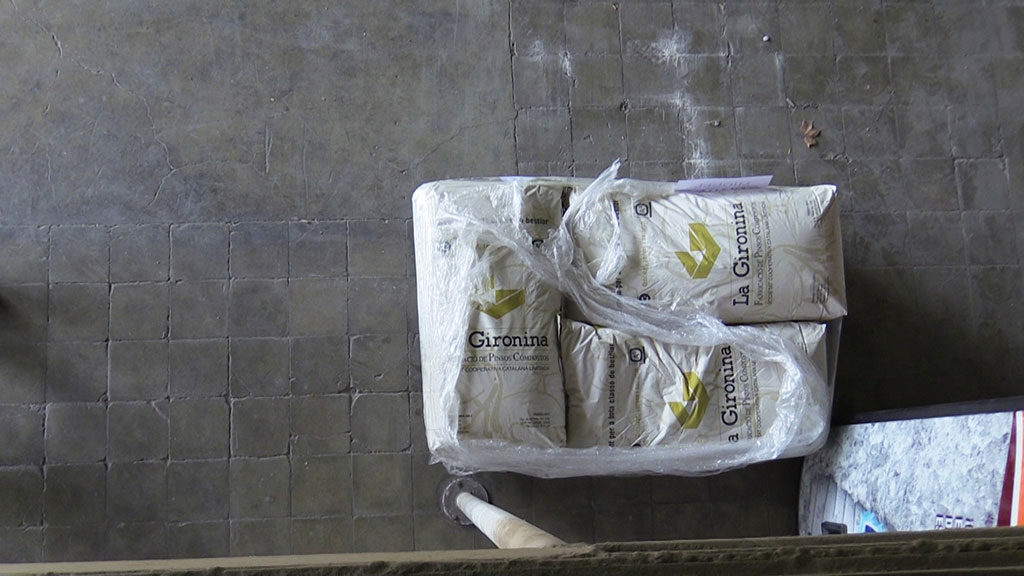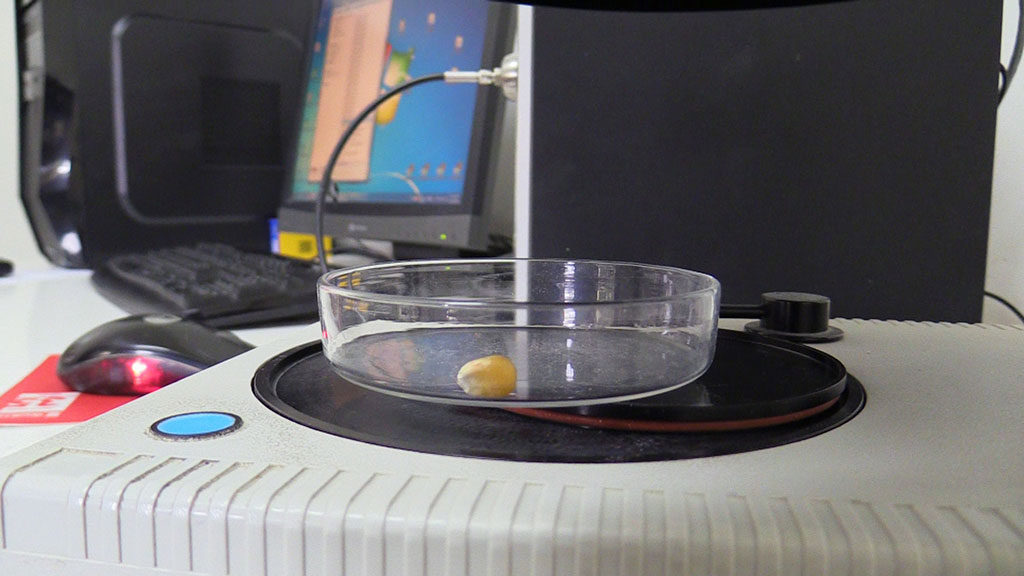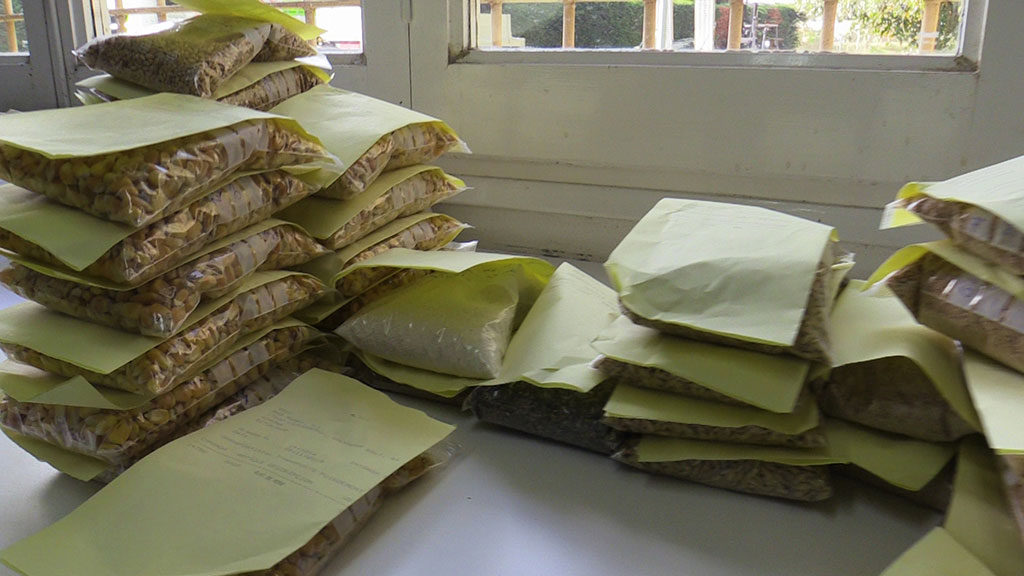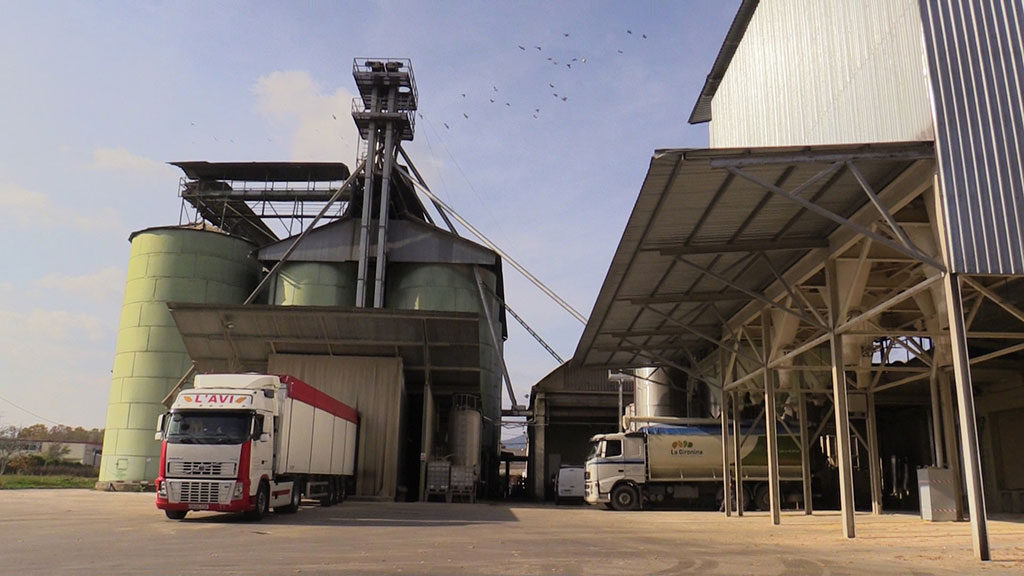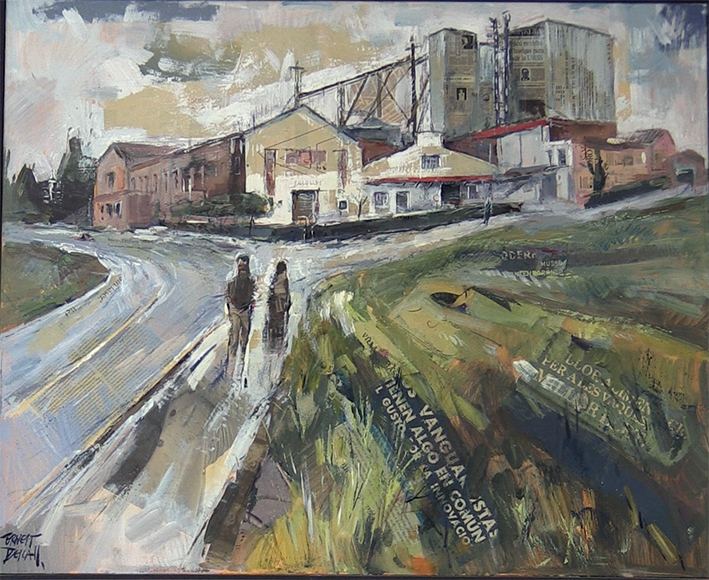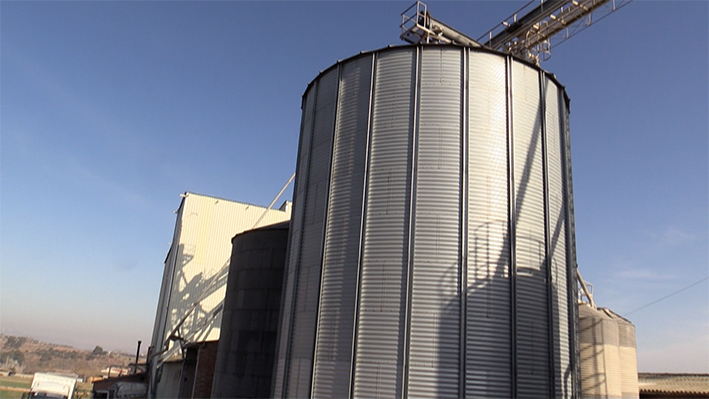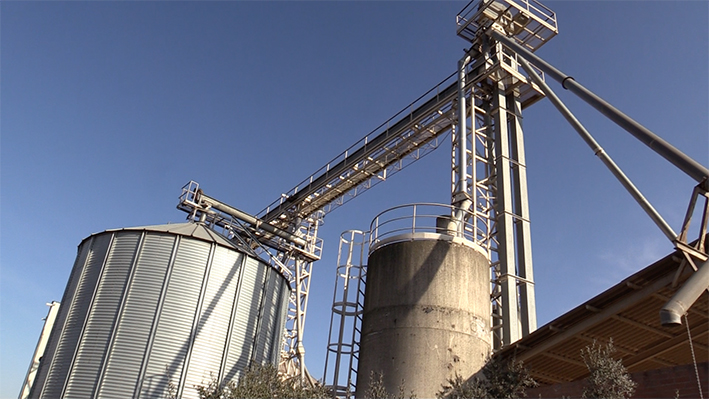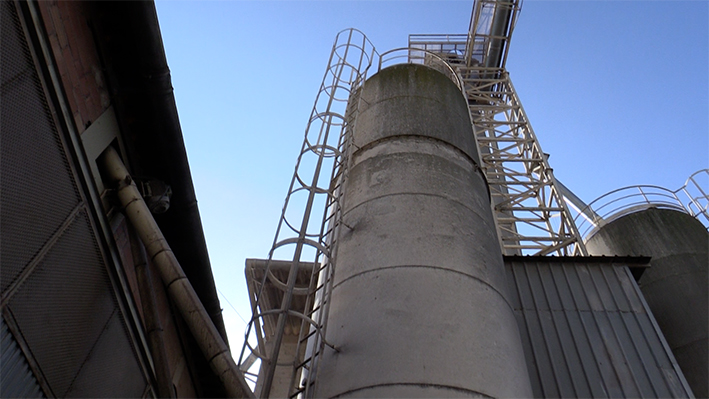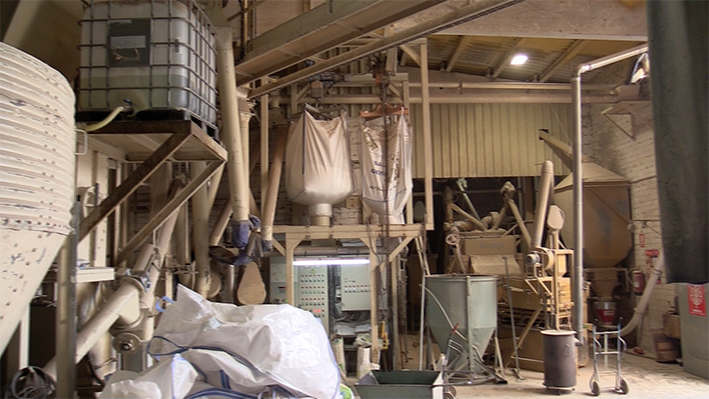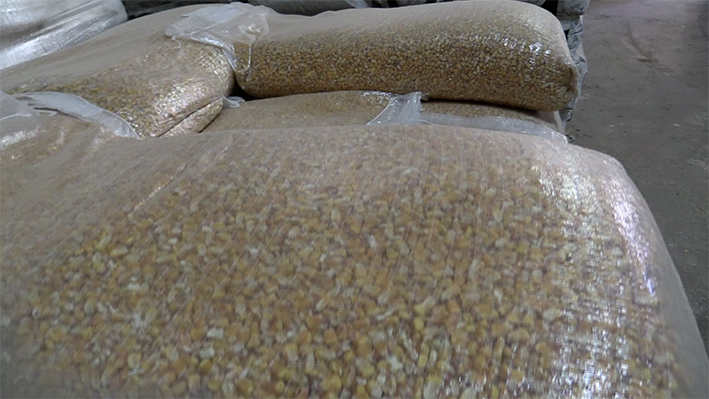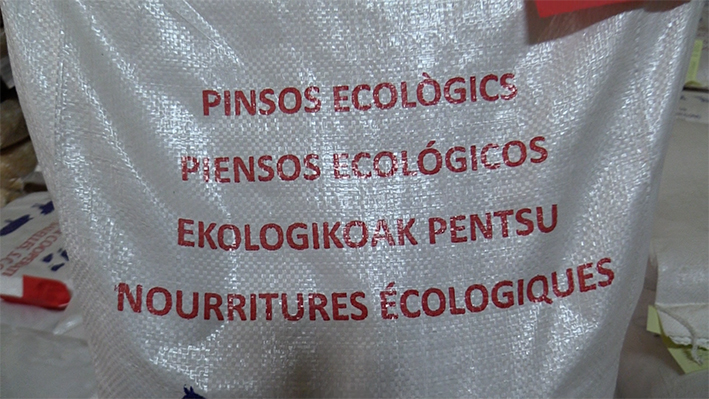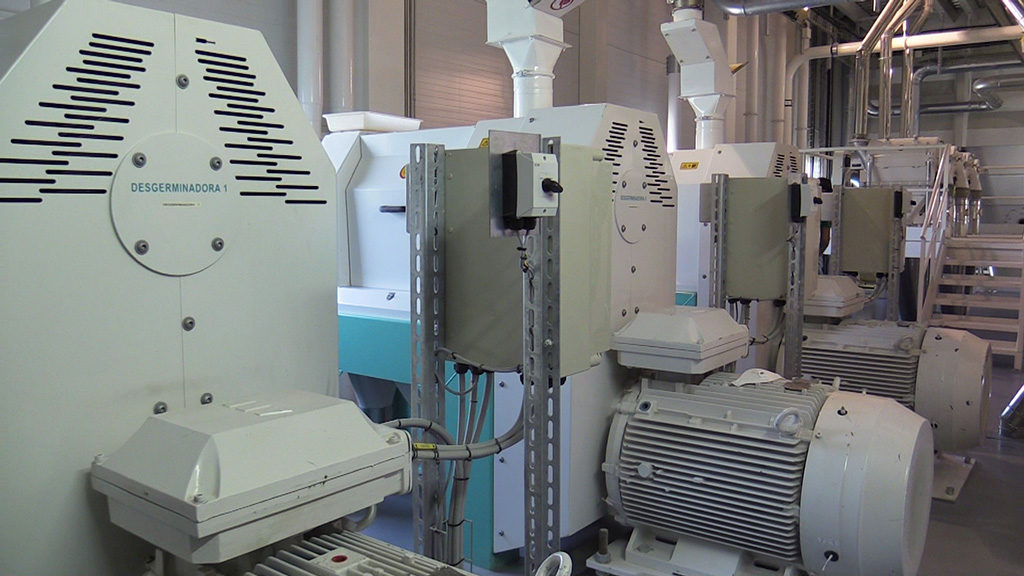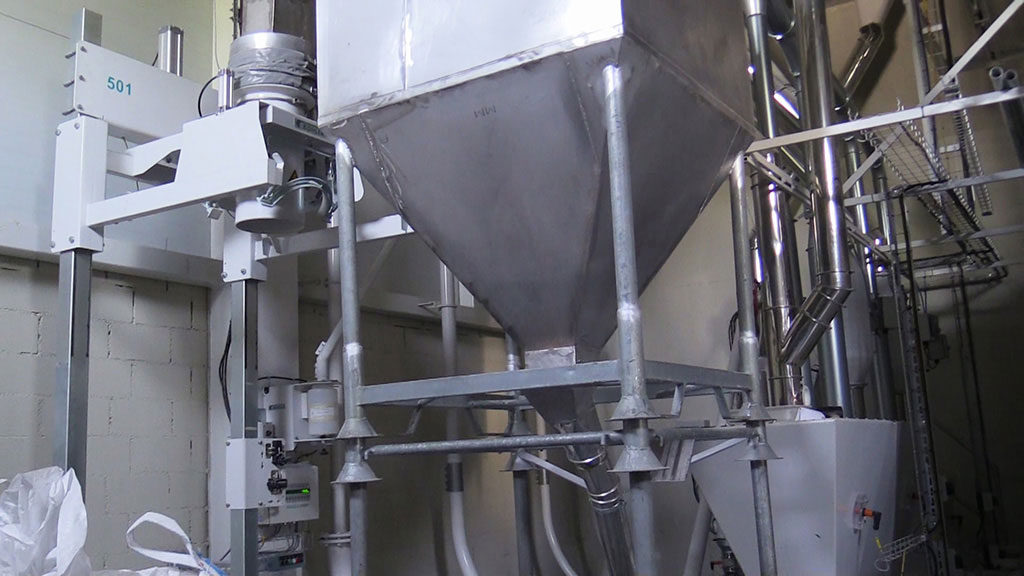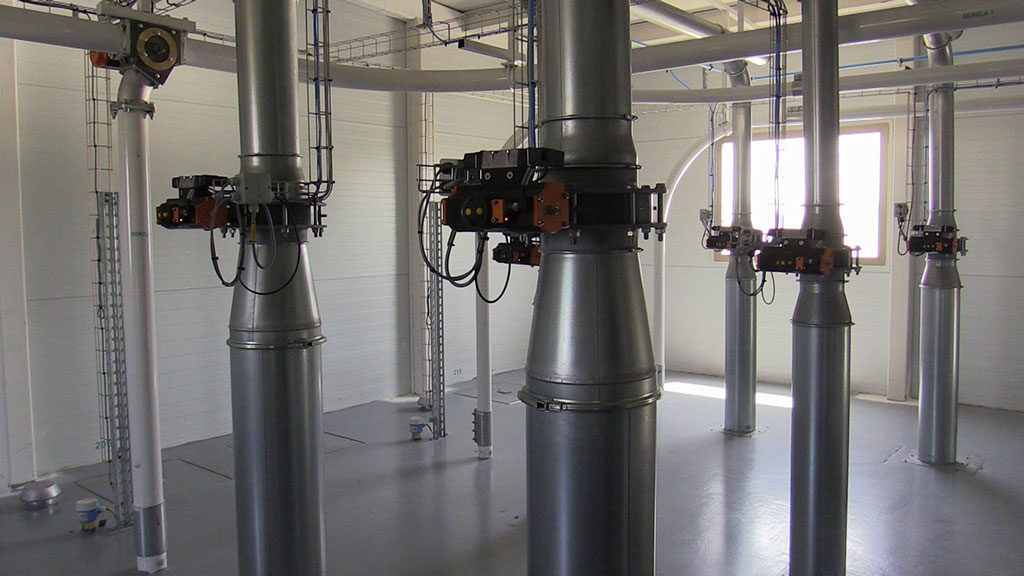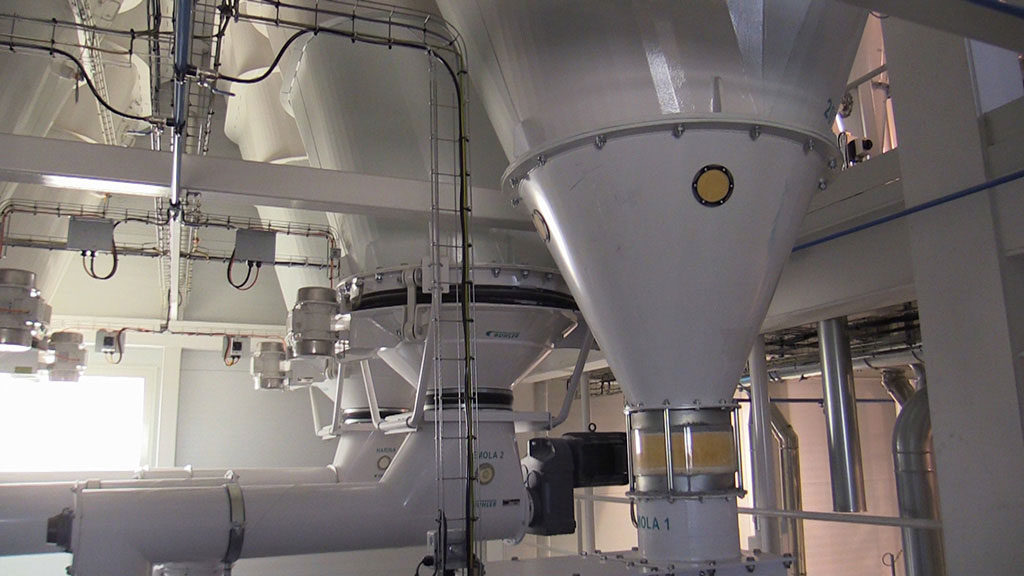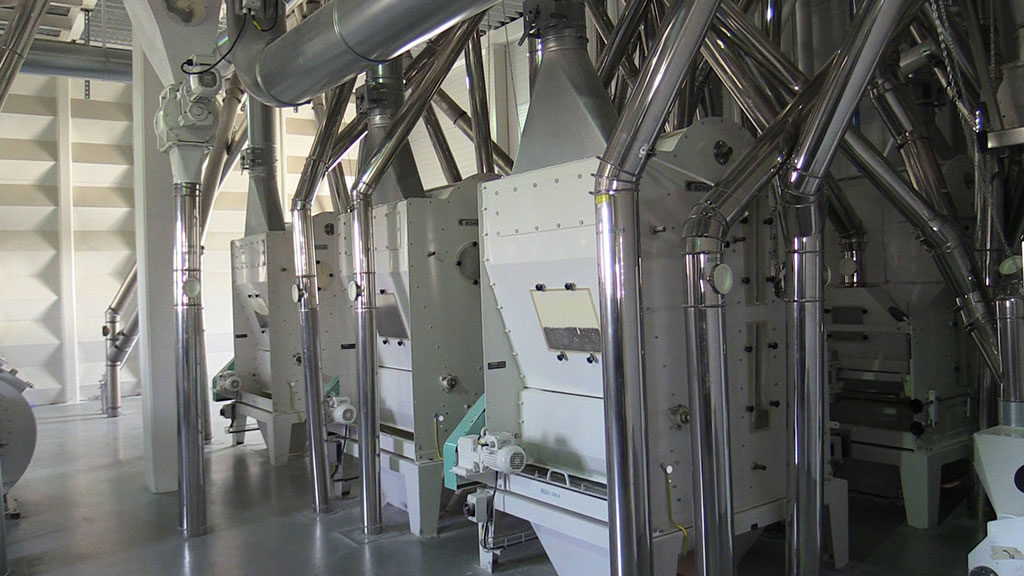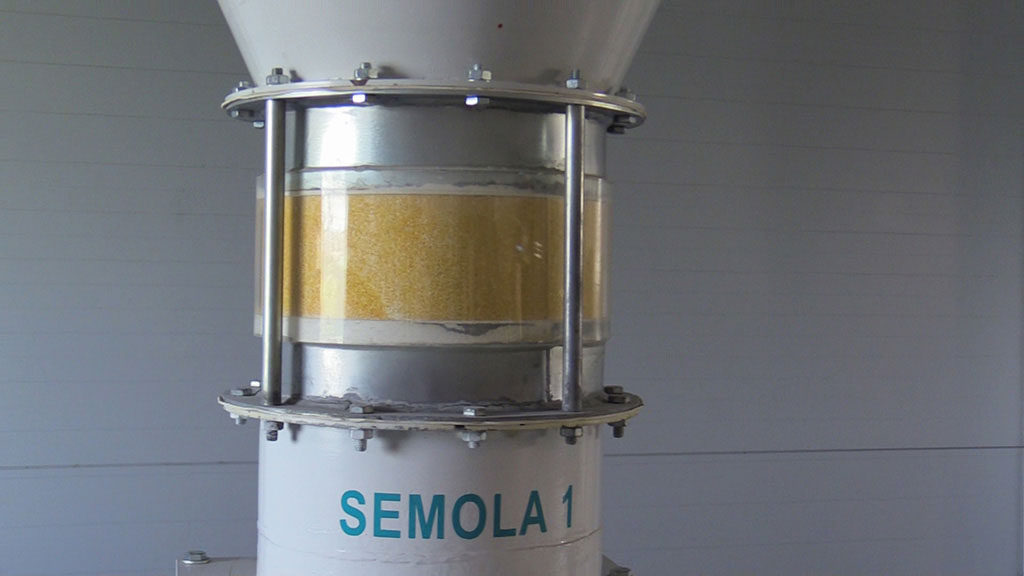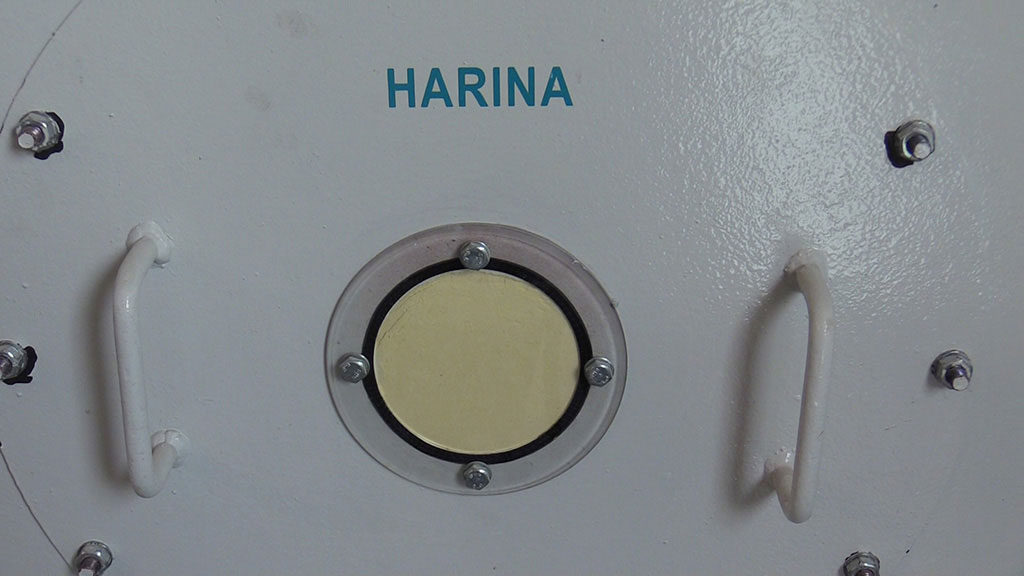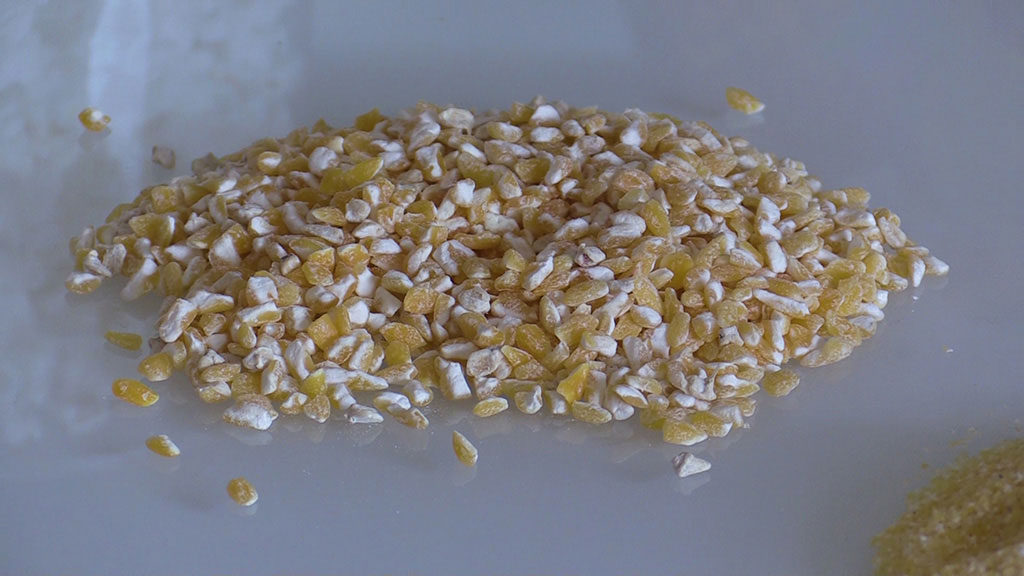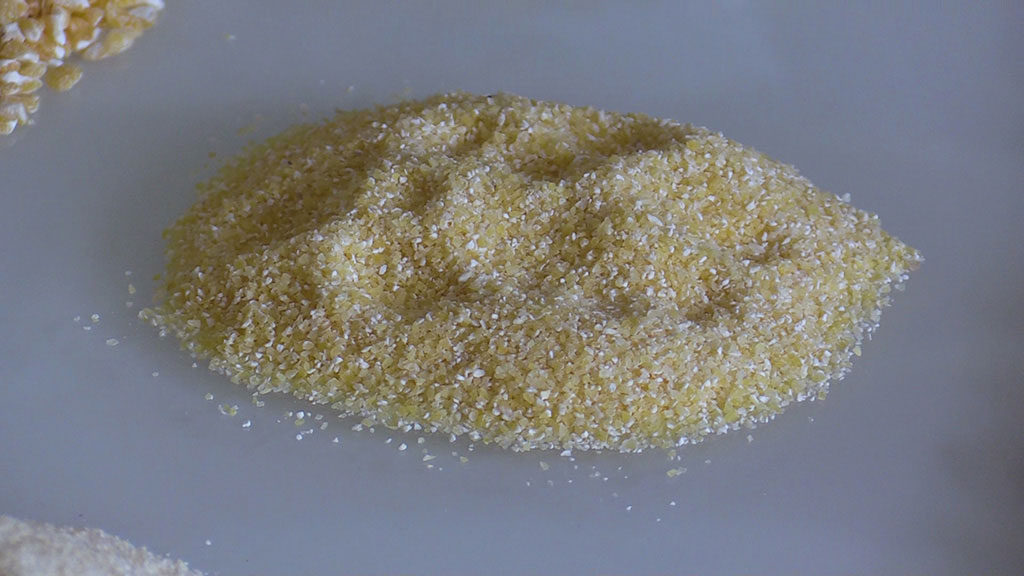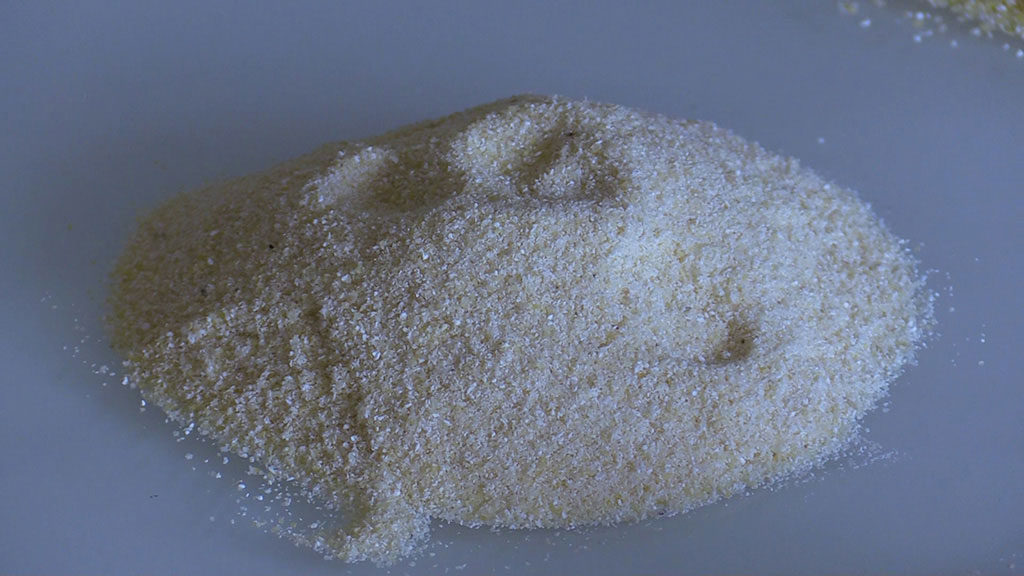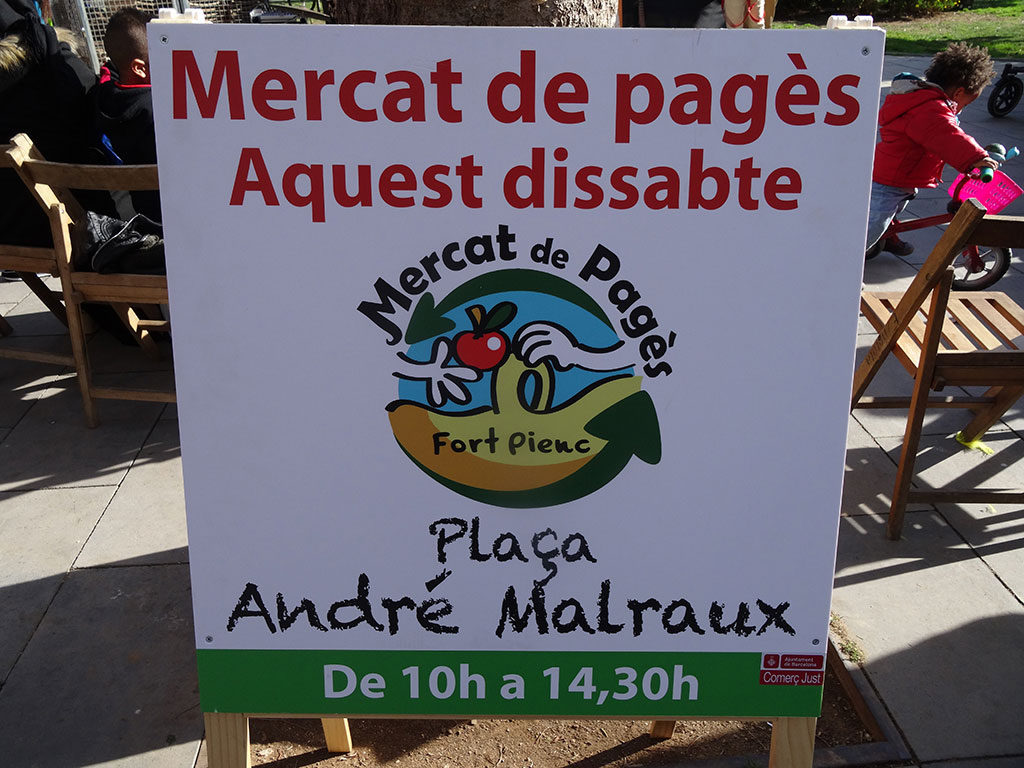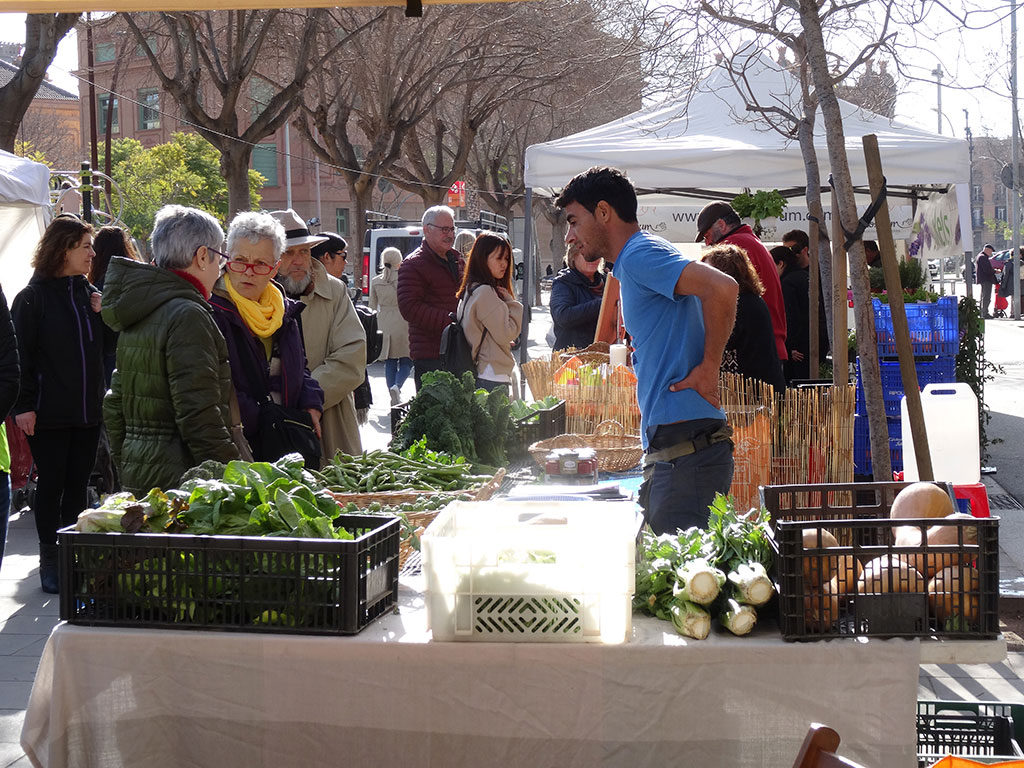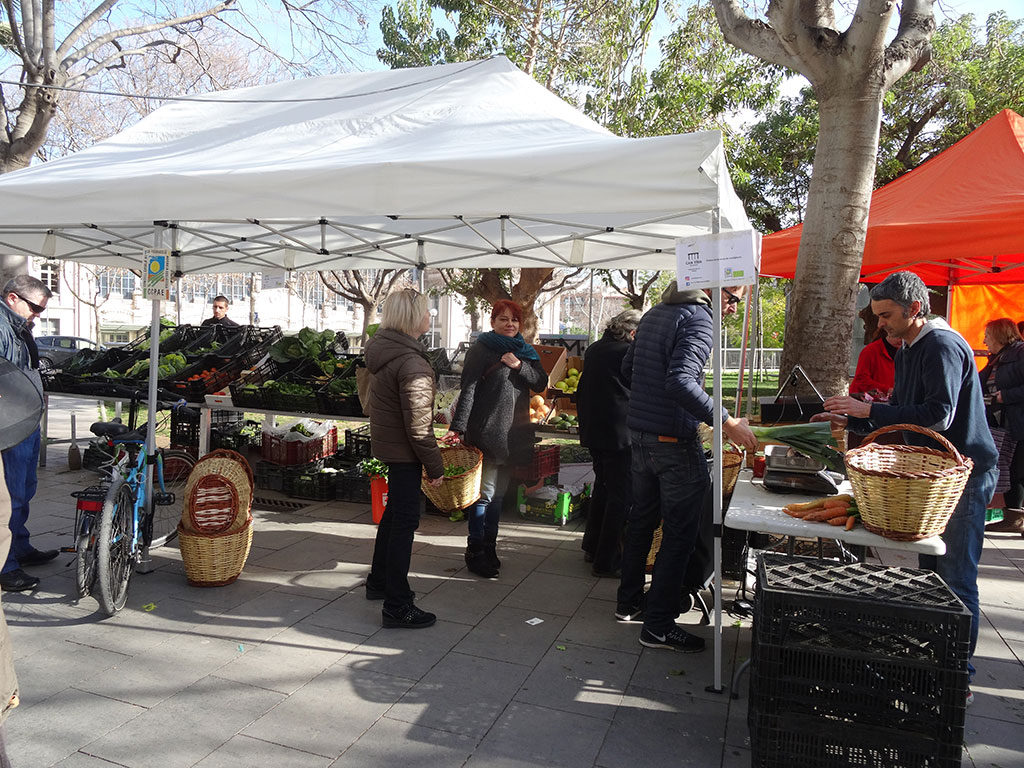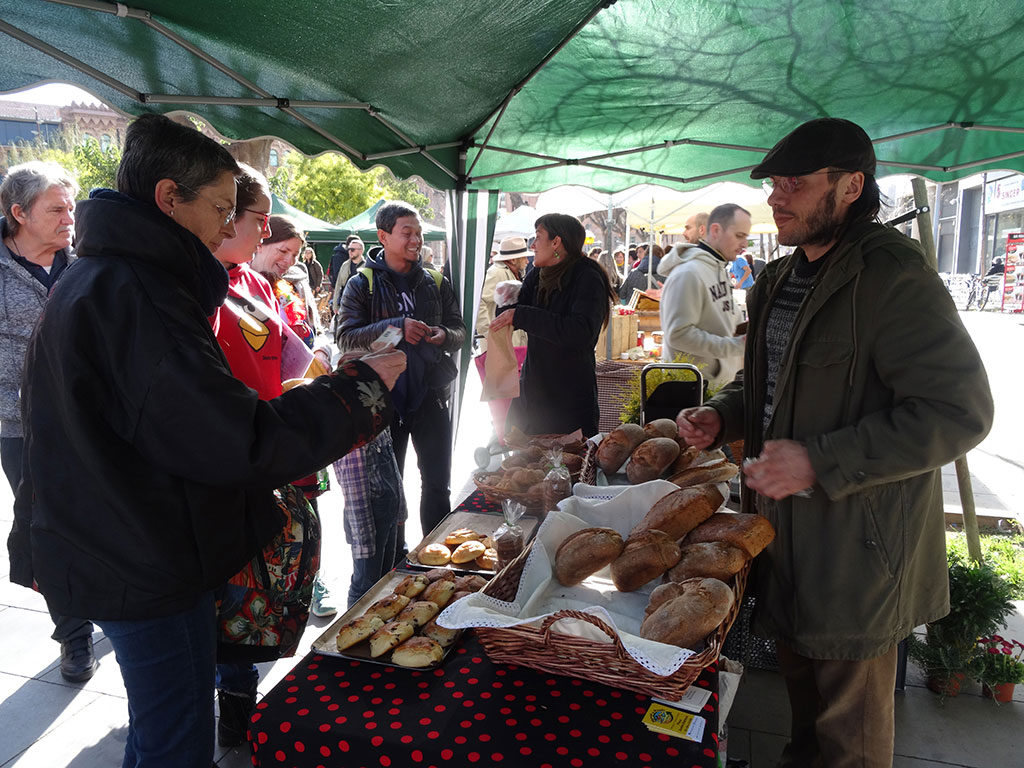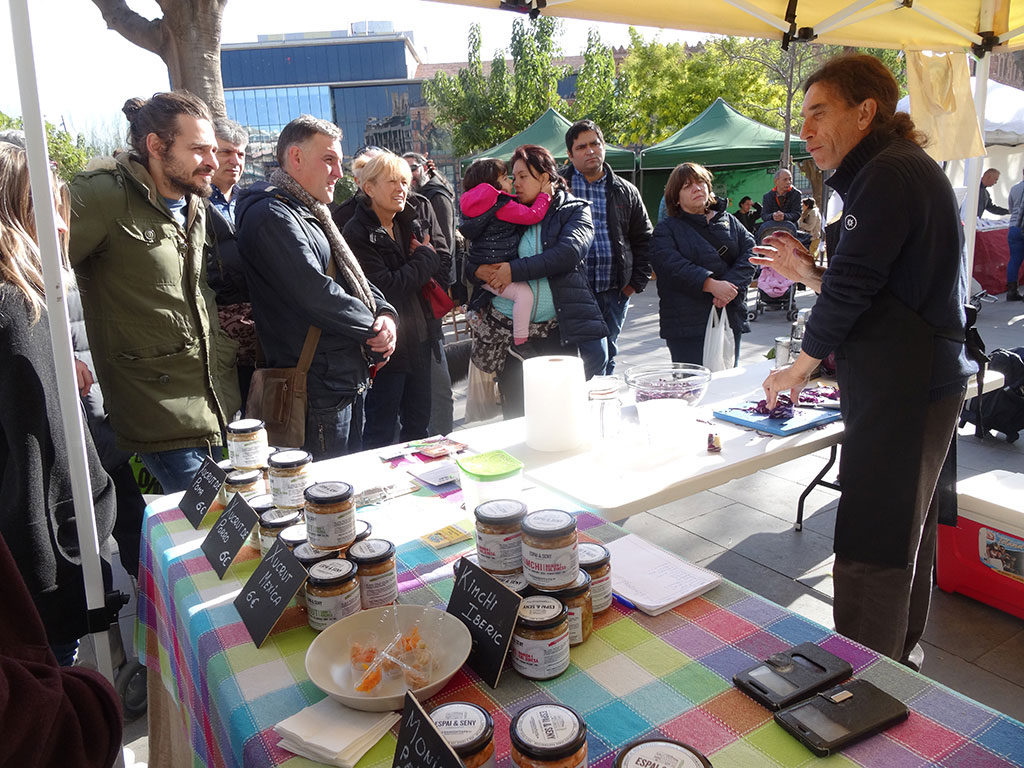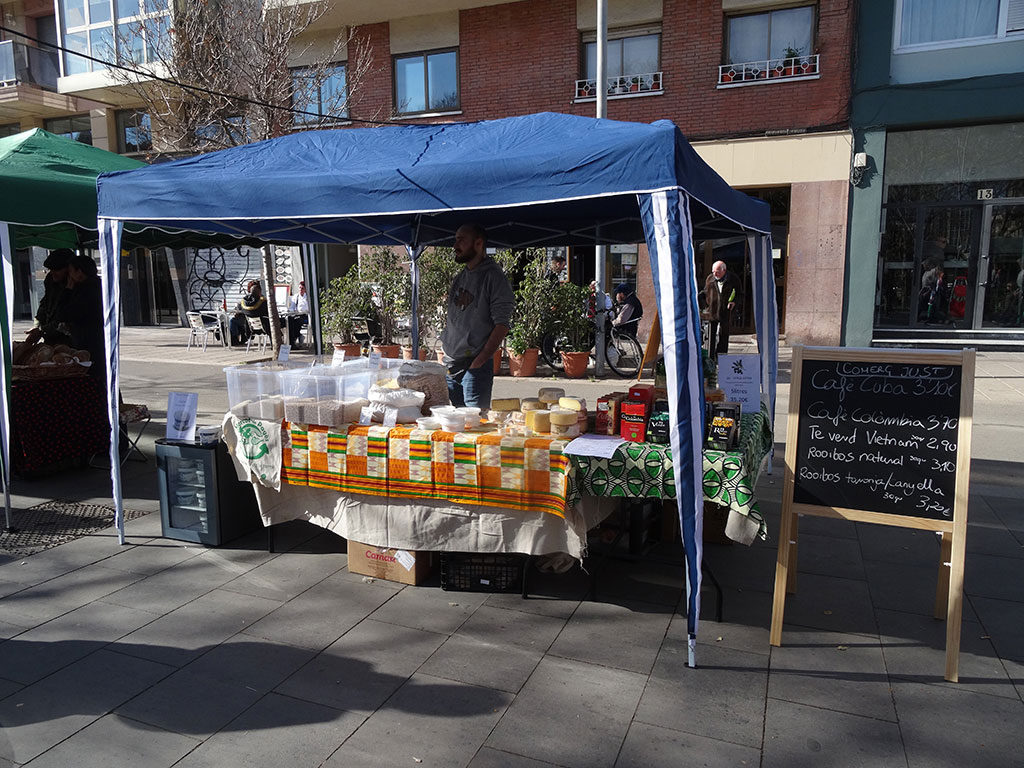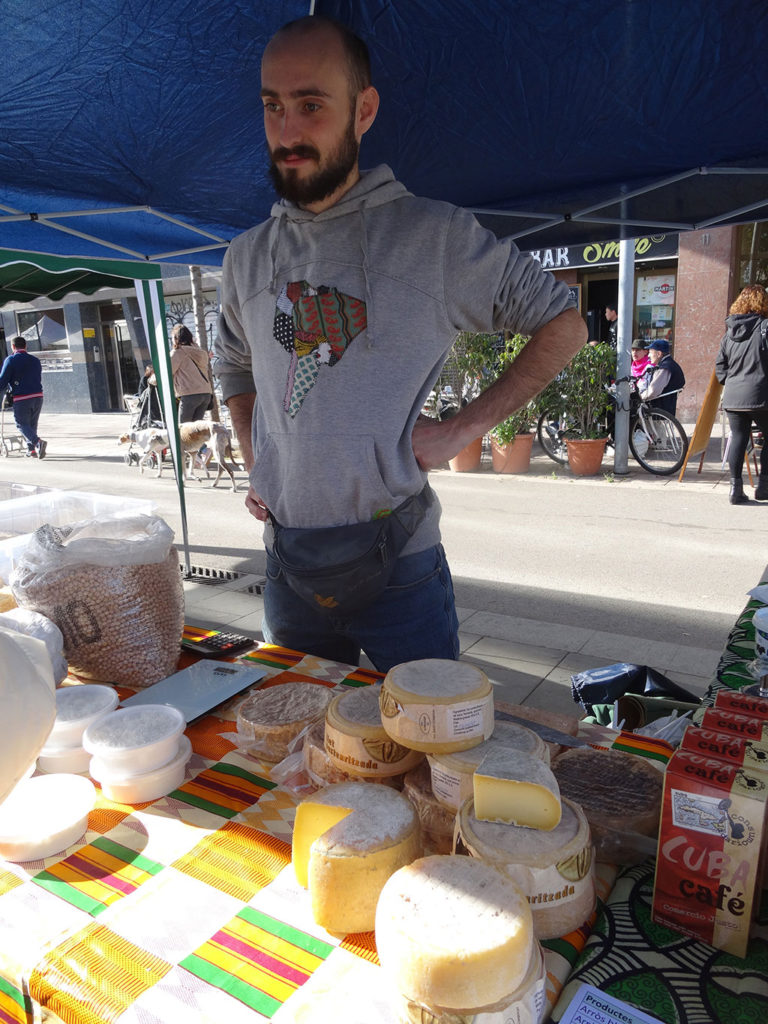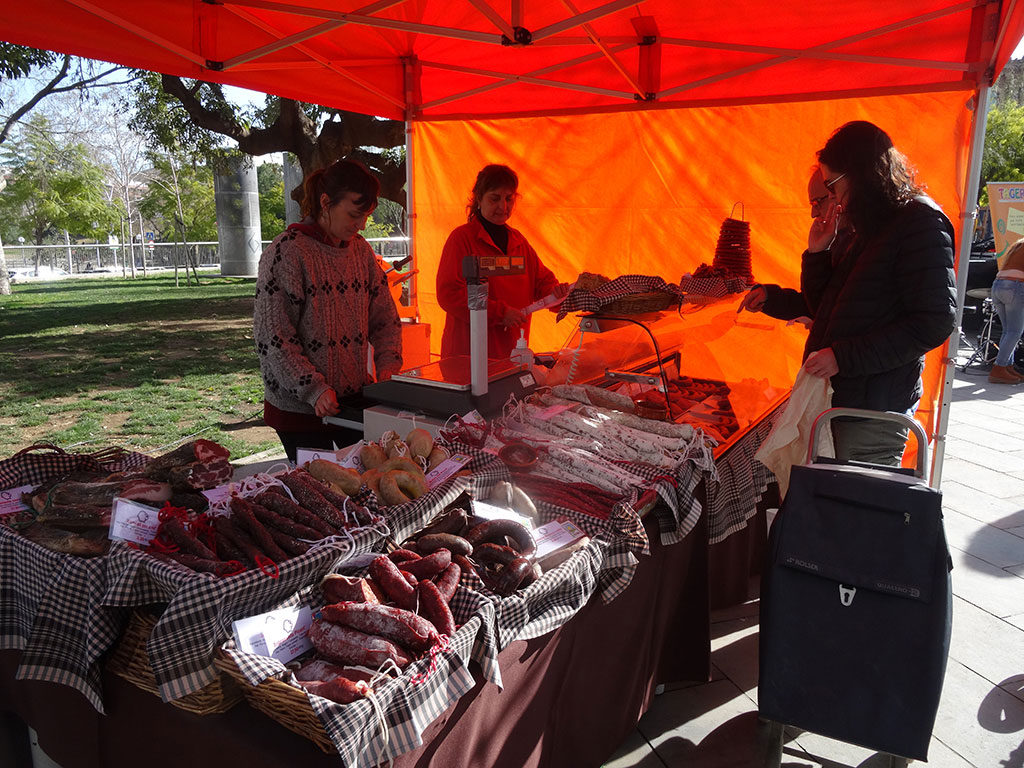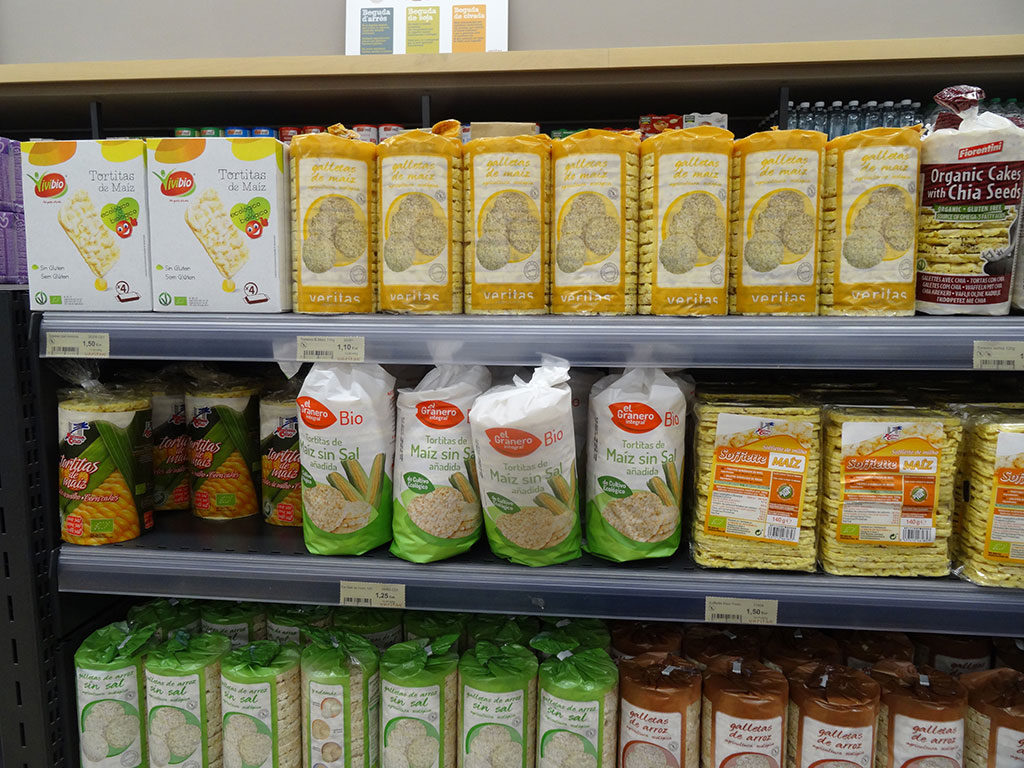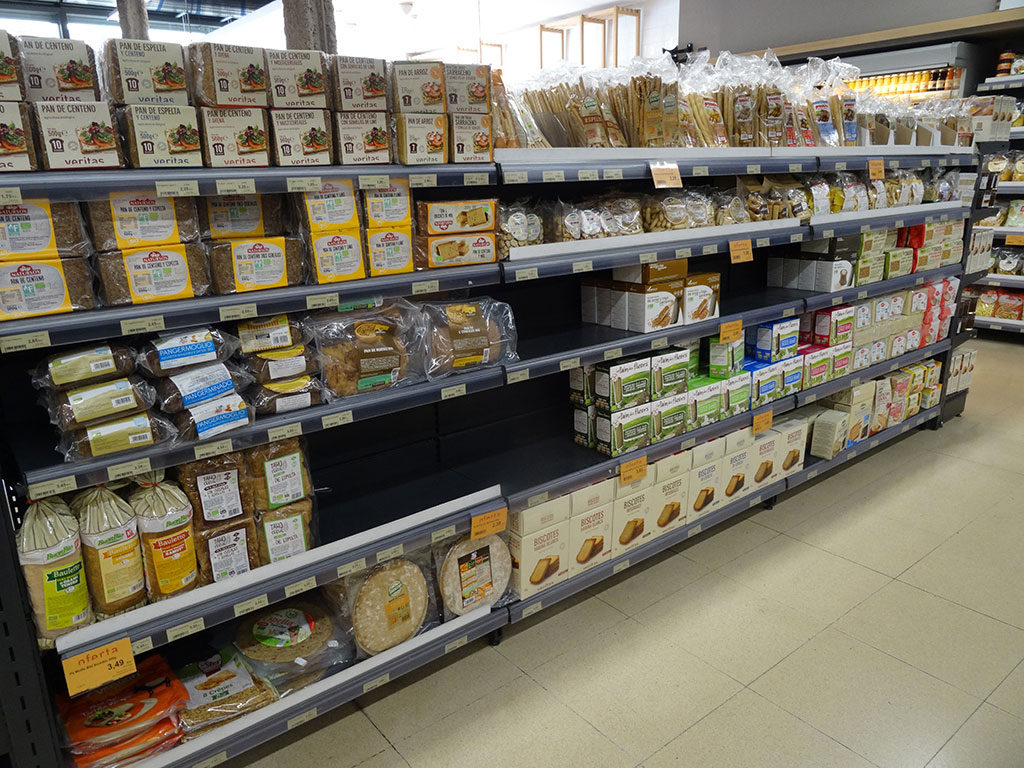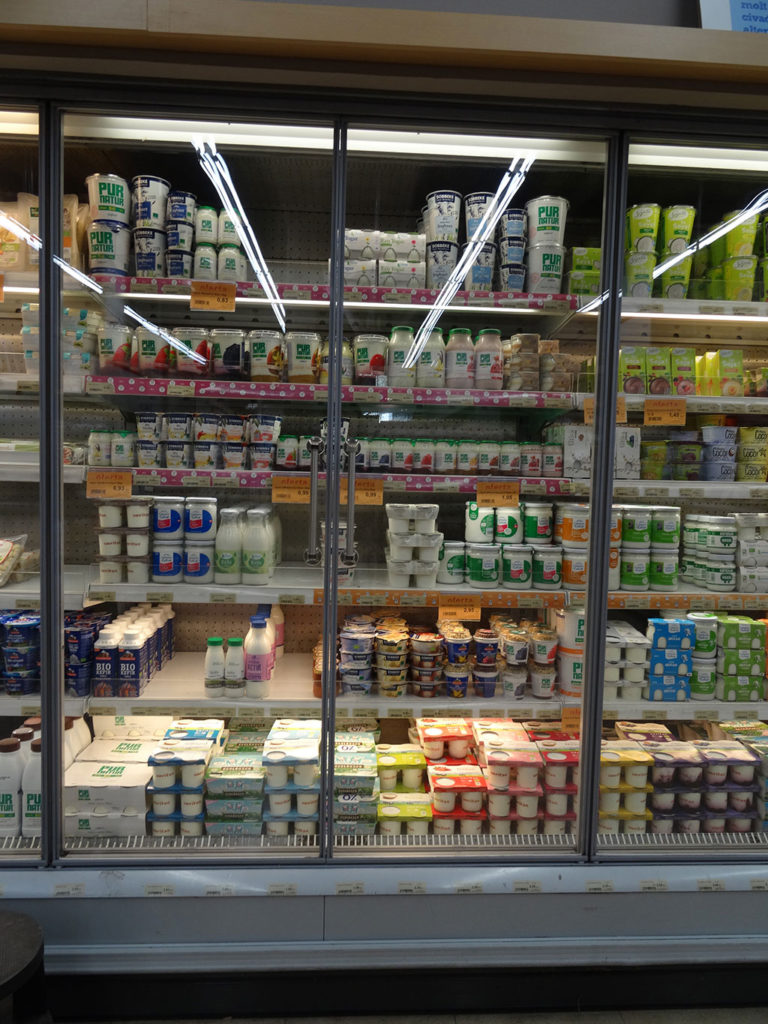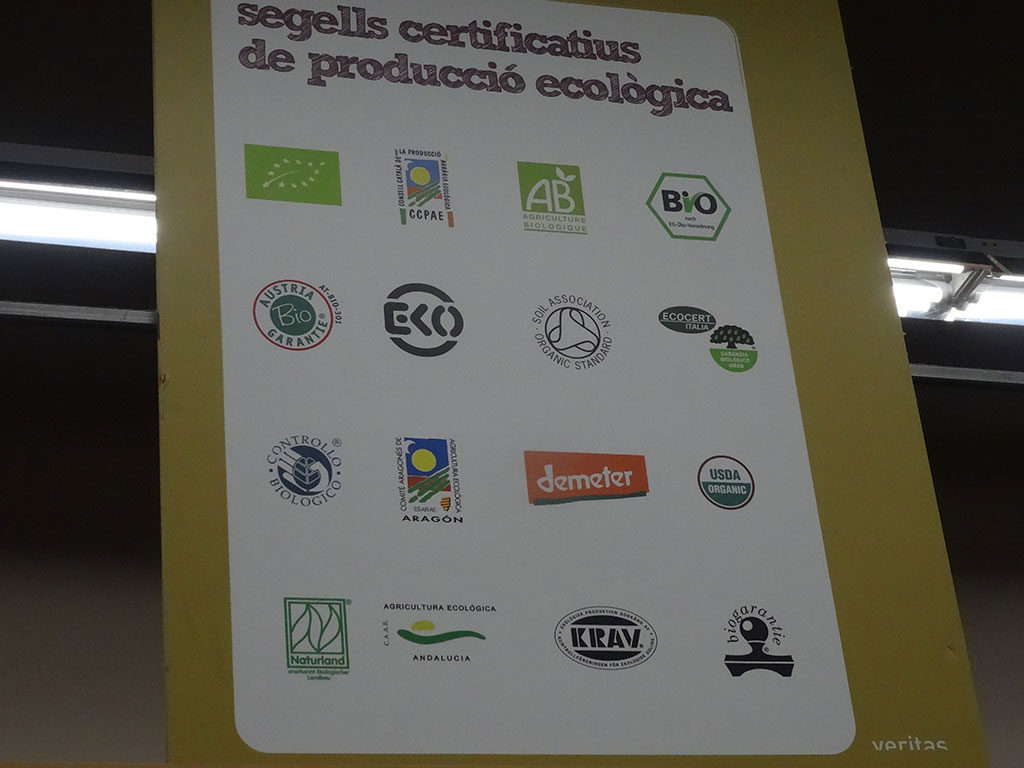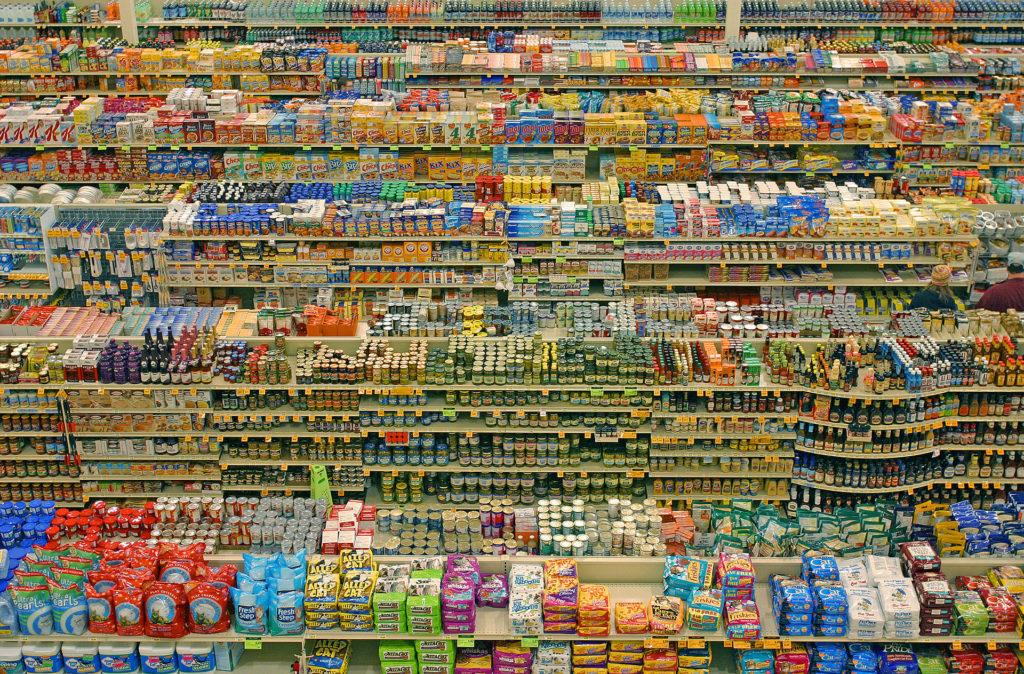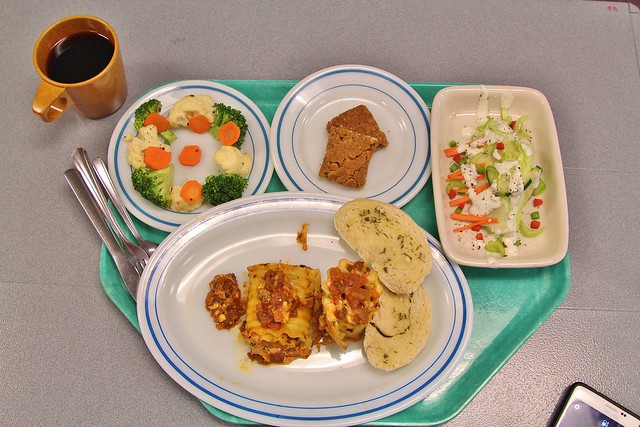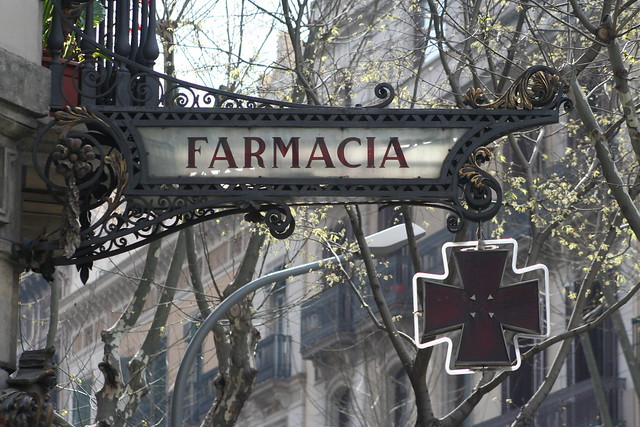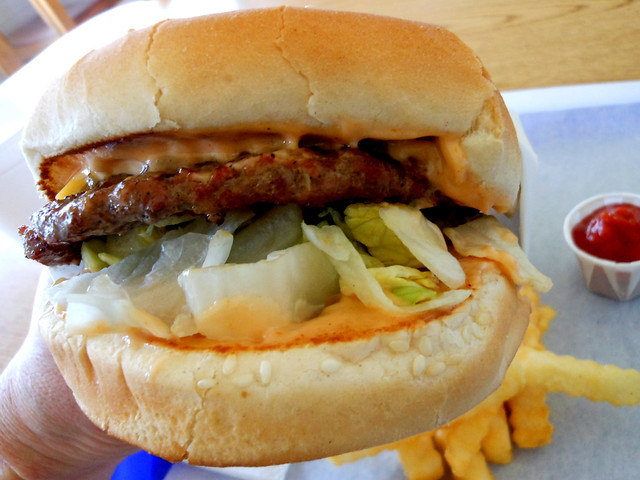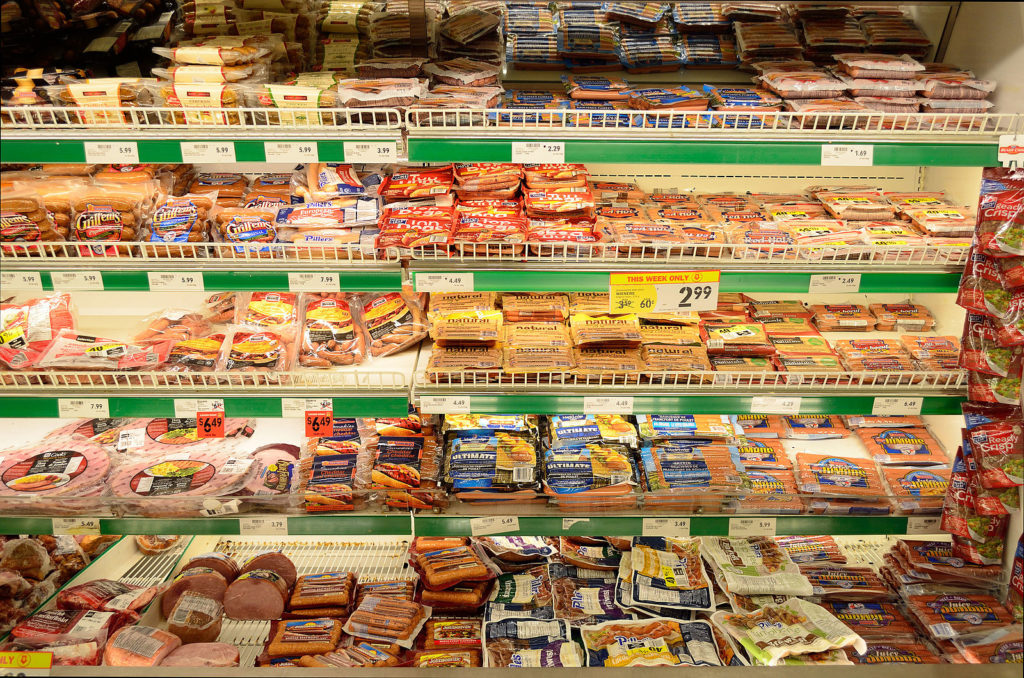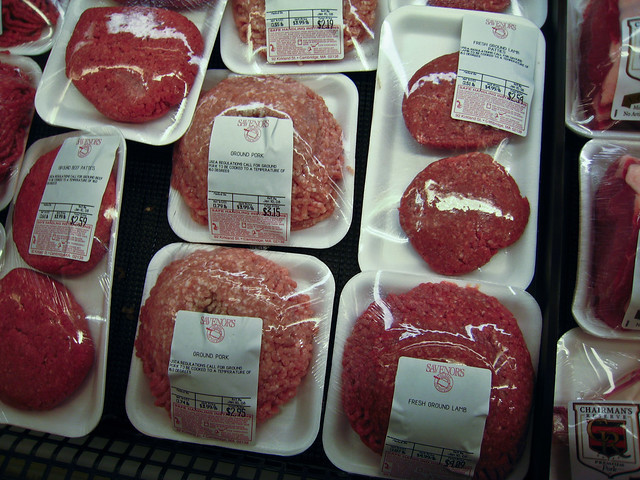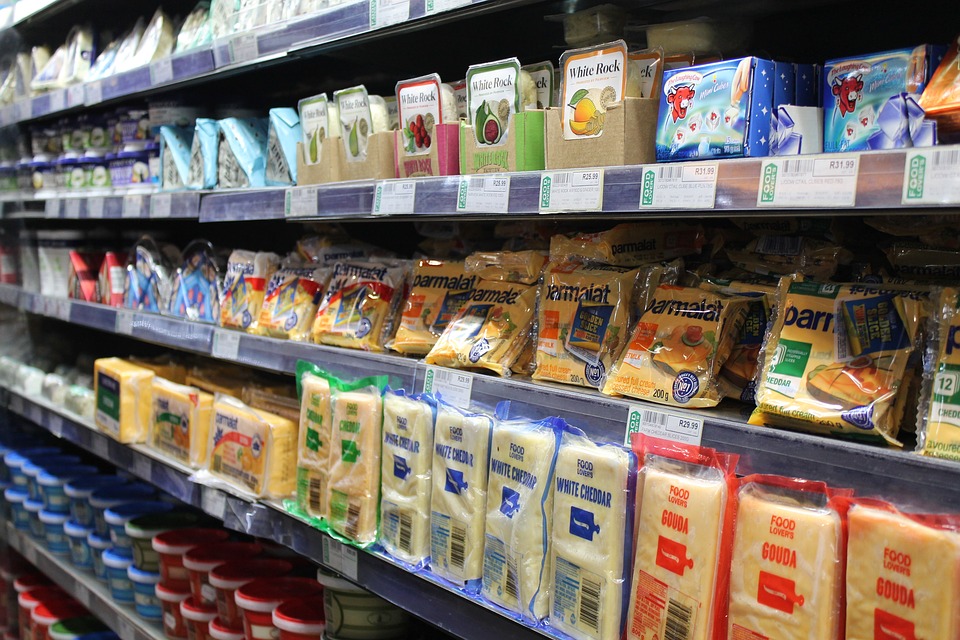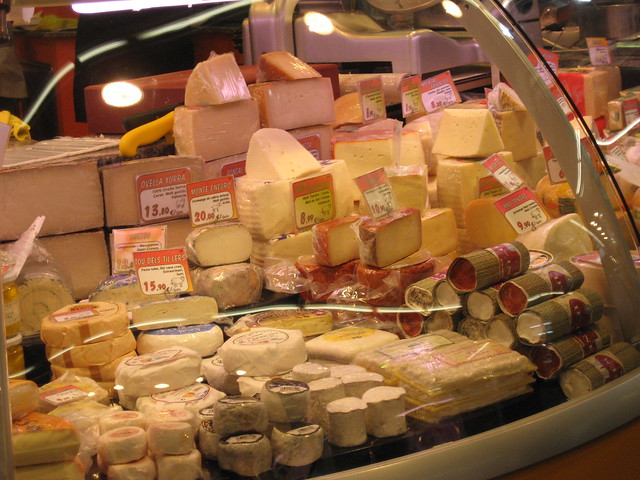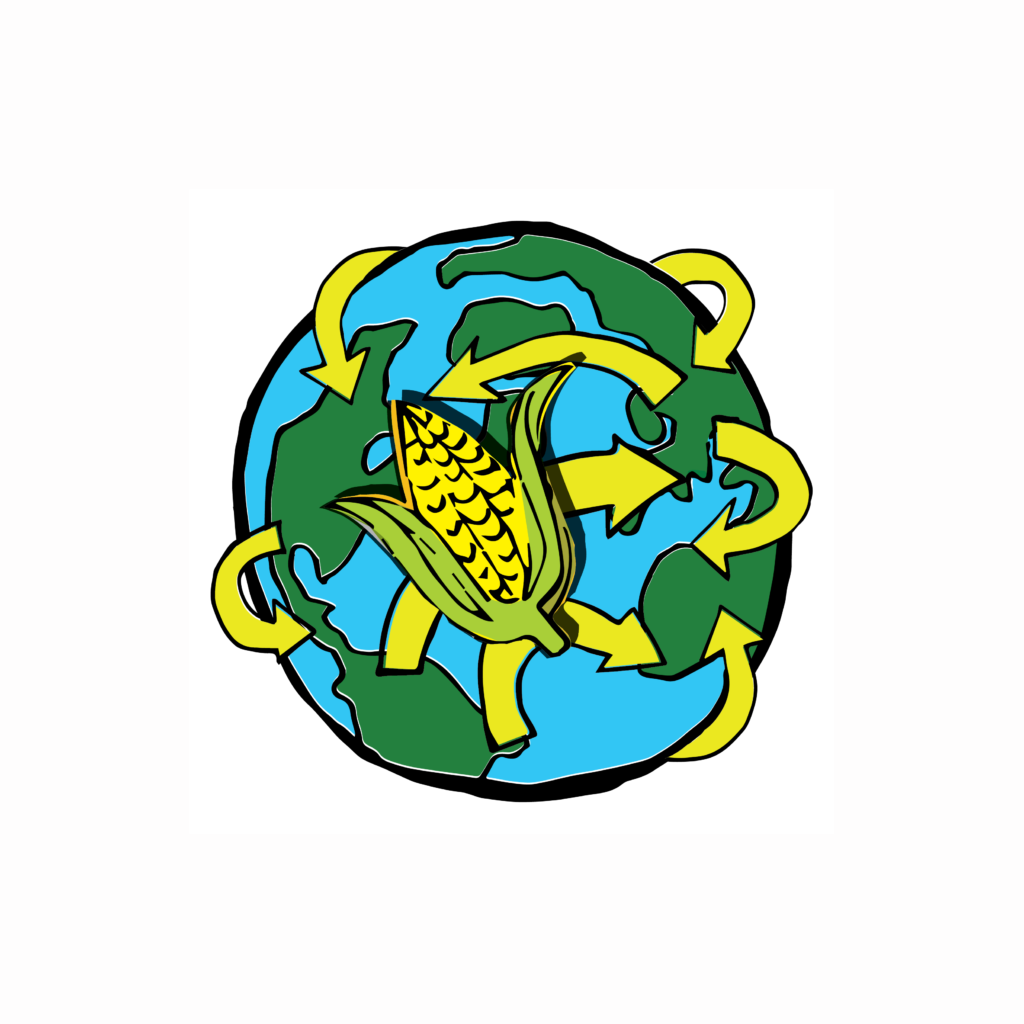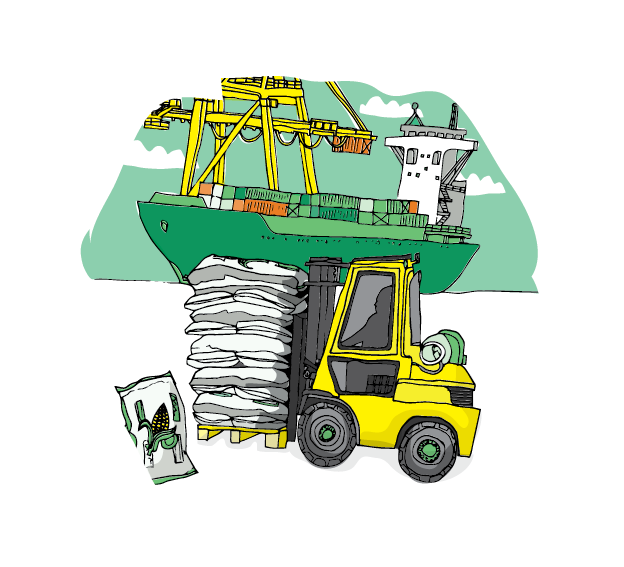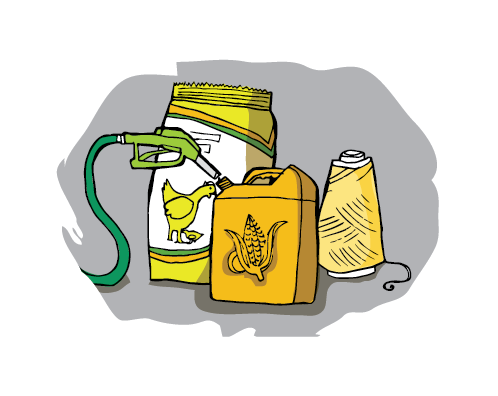Ancestral Farm
Creating maize and its biodiversity
Gene Bank
Storing genetic materials for research and distribution
Field Regeneration
Reproducing seeds
R&D Facilities
Researching and developing new varieties and agricultural practices
Experimental Field
Trialling new varieties and practices
Seed Production Field
Generating seeds for commercial purposes
Treatment Plant
Preparing seeds for sale
Agricultural Supply Warehouse
Selling seeds and agricultural supplies in bulk
Farmer Cooperative
Collectively buying and selling products and crop harvests
Farm
Growing from seed to grain
Dryer & Storage Facilities
Preparing maize for storage
Mills & Refineries
Crushing and grinding grains
Processing Plants
Transforming maize into food, feed or fuel
Livestock Farming
Raising animals as a source of food
Animal Products Processing Facilities
Converting animals and their products into consumer items
Selling Point
Selling food to consumers
You!
Consumption as an ethical and political choice

from Ancestral Farm to Experimental Field




















Interventions
Throughout this maize web there are points at which professional organisations, educational centers, civil society groups and/or social and political institutions can take different decisions or actions that will have a significant influence on the web and the flow of maize through it. These include actions such as implementing legislation, exerting pressure to change legislation, legal or direct actions to challenge regulatory systems and decisions, and the organisation of events or creation of communication to influence public opinion and decision-making.
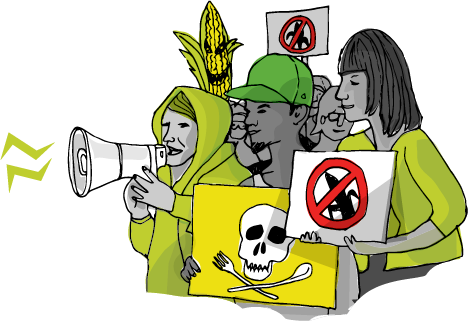
In the agro-ecological maize web there are many groups and institutions campaigning for agroecology and trying to bring consumers and producers into closer contact. For example, International organisations such as La Via Campesina, the largest international peasant’s rights movement, strongly advocate for agro-ecology as the basis for peasant agriculture and food sovereignty and highlight its incompatibility with GM agriculture. On a more local scale, Spanish groups such as Ecologistas en Acción, Escola Agraria de Manresa or La Càtedra d’Agroecologia de la Universitat de Vic campaign and organise activities to raise awareness about the importance of agroecology. All of these groups conduct activities and actions at different points of the web to try and support the development and further uptake of agro-ecological practices and views.
To Know More
[Web from the Convention on Biological Diversity] The Cartagena Protocol on Biosafety
[Press article] Why Europe will let member states opt out of GM crops?
[Academic paper] Addressing socio-economic and ethical considerations in biotechnology governance: The potential of a new politics of care
[Academic paper] Socio-economic research on genetically modified crops: a study of the literature
R&D Facilities
Research and development (R&D) in plant science underpins modern agricultural systems. It involves huge investments of economic and human resources from public and/or private institutions and plays a key role in the understanding and development of new crop varieties, as well as agricultural inputs and production practices.
In Spain, no institutionally supported research is currently being done to better understand or develop heirloom maize varieties. In the past, several experimental fields have been carried out studying the performance of heirloom varieties to be used for bread making.
To Know More
[Academic Article] Maize for bread under organic agriculture
[Academic Article] Breeding maize for traditional and organic agriculture
Seed Production Field
Seeds for commercial use have to be produced under special conditions in large fields dedicated to this purpose. Seed production fields have to be relatively isolated from other maize fields to limit the potential for cross-pollination with other varieties.
Since commercial agro-ecological production is rather marginal in Spain, there are no dedicated fields for seed production, beyond the work that seed banks do to make seeds available to growers and the work that farmers do to produce and save their own seed.
Beware! Potential GM Presence
Genetically Modified sequences of DNA can spread and contaminate chemically intensive, organic and agro-ecological crops. This is a source of conflict between the different agri-food webs challenging their co-existence and putting at risk the ability to both produce and consume GM-free food. This risk is especially relevant for organic producers, who can lose their market if they are contaminated.
GM contamination can take place at different stages of the maize webs and through different mechanisms. It can happen in the field by farmers sowing GM seeds without knowing or through cross-fertilisation due to the transport of pollen by wind or insects. It can also happen through a seeds mixing in farm machinery, transport vehicles or storage and processing facilities.
In maize seed production fields, like in any open field, there is the risk of contamination of non-GM maize by cross-pollination with GM crops. Seed production fields are typically located in isolated areas to try to minimise not only the risk of cross-pollination with GM maize, but to also avoid cross-pollination with any other variety of maize. This is important for maintaining a variety’s unique genetic identity. These contamination risks, however, can still vary significantly depending on the distance of neighbouring GM crops, the type of landscape, the timing of flowering, the wind conditions, the presence of pollinators etc.
Do You Want to Know If Your Food Contains GMOs?
Treatment Plant
Seed treatments are the biological, physical and chemical agents and techniques applied to seeds to try and minimize damage from fungi or insect attacks. These treatments are typically applied in the facilities of seed companies and commonly include toxic chemical components such as organophosphates, neonicotinoids, synthetic pyrethroids, metalaxyl, fludioxonil or captan.
Seeds treated with these chemicals are usually dyed bright colours (e.g. hot pink or orange) to indicate that they have been treated with toxic chemicals and should be handled with care using protective measures. After receiving the treatments, seeds are packaged ready for sale.
Although the chemicals used for seed treatment may cause environmental or health risks if not handled properly, the use of neonicotinoids has become particularly controversial in Europe in recent years due to questions concerning their link to colony collapse disorder in honeybees. After some years of a partial moratorium in the use of neonicotinoids on the seeds of crops attractive to bees, in 2018 its use may be permanently banned in all European outdoor crops, pending the decision of the European Commission. After receiving the treatments, seeds are packaged ready for sale.
Untreated and treated dancing maize seeds
Agro-ecological seeds are not commercialised in a large scale in Spain and they are not subject to treatment processes.
To Know More
[European Commission Website] Current status of the neonicotinoids in the EU
[Online Journal] EU ban on neonics: Too little, too late
[Press Article] Invoking science, Europe shuts the door to neonics
[Academic Article]: Seed treatments for sustainable agriculture-A review
[Academic Article] Quantification of Imidacloprid Uptake in Maize Crops
[Academic Article] Planting of neonicotinoid-treated maize poses risks for honey bees and other non-target organisms over a wide area without consistent crop yield benefit
Beware! Potential GM Presence
Genetically Modified sequences of DNA can spread and contaminate chemically intensive, organic and agro-ecological crops. This is a source of conflict between the different agri-food webs challenging their co-existence and putting at risk the ability to both produce and consume GM-free food. This risk is especially relevant for organic producers, who can lose their market if they are contaminated.
GM contamination can take place at different stages of the maize webs and through different mechanisms. It can happen in the field by farmers sowing GM seeds without knowing or through cross-fertilisation due to the transport of pollen by wind or insects. It can also happen through a seeds mixing in farm machinery, transport vehicles or storage and processing facilities.
In the facilities where treatment and packaging takes place, there is a risk of accidental admixture of seeds from different varieties.
Farmer Cooperative
Farmer cooperatives are voluntary associations of farmers which form jointly-owned enterprises, mainly to provide themselves with supplies and sell their harvest. By taking advantage of bulk volume discounts and other economies of scale, farmer cooperatives can bring down the cost of the inputs that members need to purchase compared with individual purchases from commercial suppliers. Thus, they can provide agricultural inputs such as seeds, fertilizers, chemicals, fuel, and farm machinery to their members at discounted prices. In some cases, they can also offer facilities for drying and storage, as well as facilitate the selling of harvests.
In Spain there are very few farm cooperatives specifically for organic or agro-ecological farmers and the ones that exist are small and mostly oriented to vegetable production.
To Know More
[Press Article] La Sazón, una cooperativa de agricultura ecológica desde cuatro localidades del Alto Aragón (in Spanish)
[Doctoral Thesis] Ajates Gonzalez, R. (2016). Agricultural cooperatives: promoting or hindering fairer and more sustainable food systems? The case of Spain and the UK. (University of London)
GMO label
Currently, 64 countries around the world require labeling of GM foods. Labeling enforces both consumers’ ‘right to know’ and farmer’s ‘right to choose different productions models’, as it provides information that allows them to make informed choices. For countries requiring labeling of pre-packaged GM food/feed products, the list of ingredients must indicate “genetically modified” or “produced from genetically modified [name of the organism]”. In the case of products without packaging, these words must still be clearly displayed in close proximity to the product (e.g a note on the supermarket shelf).
In Europe, these labelling requirements do not apply to GM food/feed products if each ingredient contains less than 0.9 percent GM. This limit was set to exclude labeling requirements in cases where presence is adventitious or technically unavoidable.
Meat, eggs or dairy products obtained from animals feed with GMOs do not have to be labelled, since these products are not considered to be genetically modified. In this way, the consumer loses track of the GM agri-food web at this point. Most of the GM maize produced in Spain is for producing feed, but since the products derived from the animals fed GM maize are not labelled, the consumer rarely sees a label indicating that a product has GM components.
To Know More
[European Commission Website] Traceability and labelling of GMOs
Grain Stock Market
The food stock market is an aggregation of buyers and sellers of stocks connected to food items, organised and connected through a loose virtual network of economic transactions. It is an institution that heavily influences the price that maize is sold and bought for in free market economies. While there are still some places where stocks are set in an ongoing live auction, these markets and their exchanges are now about 75% electronic. Anyone with internet access can engage in these electronic markets by placing an order through a broker. Some stock markets are more influential than others (e.g Chicago Stock Exchange), and their prices may go on to shape more regional exchange markets. Due to its significant role in the setting of global food prices, the actions of the stock market have significant implications for all actors across the web worldwide.
Barcelona’s Grain Trade Market
In the agro-ecological web, the influence of the international stock market on maize prices is much lower due to the stronger focus this web has on self-production, local contexts and direct relations between producers and consumers within short supply chains. Agro-ecological farmers often produce for themselves and have little leftover to trade, or directly sell to consumers, and therefore the influence of the international stock market within this maize web is reduced and indeed, there is a specific aim within this system to minimize its power.
To Know More
[Website] Grain stockmarket of Barcelona
[Document] Marketing organic grans
[Document] Price evolution of grains in Spain
Organic Certification
Organic production has a unique and specific identity that is legally designated. This unique identity means that there is also a specific market for organic products. In order to access this market, producers (e.g. seed suppliers, farmers, processing companies) have to comply with legal obligations for organic production and undergo inspection to confirm compliance with these requirements. Compliance with the required conditions is officially acknowledged with an ‘organic’ label. This certification process is overseen by government authorities or private companies and entails additional costs for the farmers, which is reflected in the price of the final product.
Requirements for organic production – as well as the image of the label – vary from country to country, but generally involve a set of production standards for growing, storage, processing, packaging and shipping that, besides being subject to the same agricultural, food safety and other government regulations that apply to non-certified producers, include factors such as:
- Avoidance of synthetic agrotoxic chemicals (e.g. fertilizers, pesticides, antibiotics, food additives), irradiation, and the use of sewage sludge.
- Avoidance of genetically modified seeds and ingredients;
- Use of farmland that has been free from prohibited chemical inputs for a number of years;
- For livestock, adhering to specific requirements for feed, housing and breeding;
- Keeping detailed written production and sales records;
- Maintaining strict physical separation of organic products from non-certified products;
- Undergoing periodic on-site inspections.
To know more
[Website] Organic certification in the EU
[Academic Paper] Should Organic Agriculture Maintain Its Opposition to GM? New Techniques Writing the Same Old Story.
Experimental Field
Field trials are an important step in the process of developing and testing the effectiveness of new varieties. Data obtained from field trials is used to decide which varieties continue to be developed, which are released onto the commercial market, and what agronomic practices and crop protection measures (e.g. to protect against diseases, insects, or weeds) are recommended. Varieties can differ from one to another in characteristics such as yield, length of growing season, resistance to stressors (such as pests or drought), ear size, etc. The genetic diversity of maize provides a high degree of versatility for the crop and understanding how different varieties that are developed during R&D grow and respond to environmental conditions is tested during field trials.
In Spain, no institutionally supported research is currently being done to better understand or develop heirloom maize varieties, and therefore there are also no field trials either.
Beware! Potential GM Presence
Genetically Modified sequences of DNA can spread and contaminate chemically intensive, organic and agro-ecological crops. This is a source of conflict between the different agri-food webs challenging their co-existence and putting at risk the ability to both produce and consume GM-free food. This risk is especially relevant for organic producers, who can lose their market if they are contaminated.
GM contamination can take place at different stages of the maize webs and through different mechanisms. It can happen in the field by farmers sowing GM seeds without knowing or through cross-fertilisation due to the transport of pollen by wind or insects. It can also happen through a seeds mixing in farm machinery, transport vehicles or storage and processing facilities.
In field trials, like in any open field, there is a risk of contamination of non-GM maize by cross-pollination with GM crops. This risk can vary significantly depending on the distance of neighbouring GM crops, the type of landscape, the timing of flowering, the wind conditions, presence of pollinators etc. Understanding this risk in Spain is made difficult by the lack of transparency concerning the exact location of GM field trials. Furthermore, GM crops may be approved for field trials before they are approved for cultivation, which means field trials can also introduce a risk of contamination with events not yet approved for commercial cultivation.
Do you want to know if your food contains GMOs?
Ancestral Farm
Maize (Zea mays) is a domesticated version of the wild grass teosinte (Z. mays ssp. parviglumis) and a remarkable accomplishment of the breeding efforts of Native American farmers around 10,000 years ago in central Mexico.
The evolution of maize and the development of Native American societies and culture were intimately interwoven. These early farming communities used maize not only as the basis of their diet, but also for art and spiritual inspiration. In fact, maize played a central role in shaping many of Mesoamerican people’s cosmovisions, as it was considered to be the essence of humankind and the very origin of life itself.
The colonisation of the Americas during the 16th century promoted the spread of these varieties around the world. One reason for this spread across the Americas and to the rest of the world points to the value of maize stalks in producing alcohol, which was consumed in rituals and other social events. This, together with its value as a staple grain, are key factors that may have acted as a stimulus to both the domestication and rapid expansion of maize around the globe.
Currently, maize is the world’s most widely grown cereal with a global production of nearly 1000 million tons. A highly versatile grain, it is cultivated in different agricultural systems across a wide range of latitudes, altitudes, moisture regimes, slopes, soil types, societies and cultures.
To Know More
[Academic Article] Global maize production, utilization, and consumption
[Video] The Mayan creation story
Gene Bank
Both seed banks and gene banks are repositories of seeds (or other reproductive material) that aim to preserve materials for future use and protect biodiversity.
Seed banks are a type of repository typically focused on supporting in-situ conservation of biodiversity (i.e favouring conservation ‘in context’ or in this case ‘on farm’) and are interested in conserving the seed as a whole functional unit rather than placing specific emphasis on its genetic elements.
Seed banks obtain their seeds from farmers, store them in refrigerators (if available) and periodically reproduce new seeds together with farmers to replace the old ones and ensure the seed is always healthy and viable. They also usually gather and document knowledge associated with the seeds. For example, when prospecting for new seeds for the collections, seed bank workers often perform some ethnobotanical tasks to document cultural and ecological aspects, including things like culinary uses and agricultural practices. Seed banks can sell and/or freely distribute seeds directly to farmers or gardeners. They can also sell them through stores -or very often through online commerce- to the general public.
A conservation center for cultivated biodiversity
↑ English subtitles available
Despite international and European mandates on the need to protect agro-biodiversity, today seed banks in Spain face huge challenges. To make seeds from heirloom varieties legally available for commercial purposes, the seed variety has to be registered in an official catalogue and this requires proof of distinctness, uniformity and stability. Since obtaining registration for heirloom varieties through this process can be expensive and the appropriateness of the criteria used is actually disputed, the vast majority of heirloom varieties are not currently registered, thus living in a limbo of a-legality. This means some seed banks may sell without this official registration. In addition to this, there is not much interest in heirloom seeds from Spanish political institutions and therefore, there is not a lot of financial help available to maintain, research or register them.
An introduction to heirloom legislation
↑ English subtitles available
To Know More
[Magazine Article]: What makes a seed (truly) organic?
[Website]: Esporus Project (in Catalan)
[Website]: Les Rafardes Project
[Website]: Spanish Seed Network
Beware! Potential GM Presence
Genetically Modified sequences of DNA can spread and contaminate chemically intensive, organic and agro-ecological crops. This is a source of conflict between the different agri-food webs challenging their co-existence and putting at risk the ability to both produce and consume GM-free food. This risk is especially relevant for organic producers, who can lose their market if they are contaminated.
GM contamination can take place at different stages of the maize webs and through different mechanisms. It can happen in the field by farmers sowing GM seeds without knowing or through cross-fertilisation due to the transport of pollen by wind or insects. It can also happen through a seeds mixing in farm machinery, transport vehicles or storage and processing facilities.
In both seed and gene banks, there is the risk of unwittingly receiving seeds contaminated with transgenes from GM plants during collection, regeneration or distribution. Monitoring for GM contamination is rarely done by seed banks although if contamination is identified, the whole collection of those seeds will be disposed of and all the people who have been given those seeds informed.
Do You Want to Know If Your Food Contains GMOs?
Field Regeneration
Seed and gene banks need to periodically reproduce their seeds to ensure they remain viable. They do this through field regeneration. The fields used for this regeneration process can be at or near the seed or gene banks, however, in many cases, the amount of land surrounding them is limited, the environmental conditions might not be the best for all crops, and/or the capacity and knowledge to regenerate all types of crops might be lacking. Therefore, both seed and gene banks often request this task be done elsewhere by other actors, such as farmers.
Seed banks very often work with a network of farmers and growers for regeneration work. Thus, others are requested to grow a specific seed and variety and return some of the harvest back to the seed bank, and in this way help with the maintenance of the seed bank collections and agrobiodiversity conservation.
Since maize is a plant that can easily cross-pollinate with other varieties, it is important for seed savers to have regeneration fields as isolated from others as possible. This geographical isolation becomes the primary strategy to avoid genetic contamination from other maize plants (both GM and non-GM).
To know more
[Website] Esporus Project (in Catalan)
[Website] Les Rafardes Project
Beware! Potential GM Presence
Genetically Modified sequences of DNA can spread and contaminate chemically intensive, organic and agro-ecological crops. This is a source of conflict between the different agri-food webs challenging their co-existence and putting at risk the ability to both produce and consume GM-free food. This risk is especially relevant for organic producers, who can lose their market if they are contaminated.
GM contamination can take place at different stages of the maize webs and through different mechanisms. It can happen in the field by farmers sowing GM seeds without knowing or through cross-fertilisation due to the transport of pollen by wind or insects. It can also happen through a seeds mixing in farm machinery, transport vehicles or storage and processing facilities.
In regeneration fields, like in any open field, there is the risk of contamination of non-GM maize by cross-pollination with GM crops. This risk can vary significantly depending on the distance of neighbouring GM crops, the type of landscape, the timing of flowering, the wind conditions etc. However, if pollination in reproduction fields is done manually, this risk is significantly reduced.
Do you want to know if your food contains GMOs?
Agricultural Supply Warehouse
The sale of seeds to farmers can occur through different avenues. One of these is through companies specialised in the distribution of agricultural supplies, either in bulk or small scale.
Small scale non-professional agro-ecological producers of maize in Spain often purchase their seeds from stores that are epicenters for food and non-professional agricultural goods and supplies in rural areas. In contrast, professional agro-ecological farmers may save and reuse seeds from their own harvests or obtain their seeds directly from seed banks or commercial seed projects.
To Know More
[Activity] Search and visit a small agro-store and and/or an agricultural supplies warehouse near you.
- What type of seeds are they selling?
- What other agricultural supplies they sell?
- If you visited both places, what are the major differences between them?
Farm
Farming is a crucial activity to sustain human life and includes the cultivation of plants, animals and fungi for food, fiber, fuel, and other products. Agriculture was a key development for the shift from nomadic to sedentary forms of human civilization and its development has been driven by very different climates, cultures, and technologies. Farms vary significantly in scale (i.e small-scale to large-scale), practices (e.g. organic vs chemically intensive) and type of ownership (single individual, family, community or company).
Agro-ecological farmers merge traditional agricultural knowledge with modern agricultural science and aim to produce food that is both socially and ecologically sustainable. They are grounded in a philosophy that seeks to transcend a sole focus on yield and address a range of goals simultaneously. Such farms rely on ecological processes, biodiversity and cycles adapted to local conditions, rather than the use of external inputs. This is accomplished by using, where possible, agronomic, biological, and mechanical methods, as opposed to using synthetic materials, antibiotics, GMOs and growth hormones to fulfill any specific function within the system. However, they are focused on pursuing not only organic certification requirements but also in integrating social considerations such as fair supply chains for both producers and consumers, reconnecting production-consumption activities, and considering and managing the biological diversity of a field. Agro-ecological farmers pursue their practices as a way of life and as a sustainable way to develop rural societies (i.e by valuing traditional knowledge, strengthening social networks and revitalising local economies).
In Spain, agro-ecological farmers include not only small-scale farmers for commercial or subsistence purposes, but also some home gardeners, urban gardeners, organic agrarian schools, school garden project managers or housing communities. The seeds used on agro-ecological farms are often (but not always) heirloom or traditional Open Pollinated Varieties and sometimes these seeds are saved, exchanged and/or reused on the farm (e.g. for feeding chickens or for planting the next season). In fact, biological materials are often reused in agro-ecological webs, fostering the idea of a circular economy and helping to reduce costs and dependencies from external inputs. In Spain, when agro-ecological production is for commercial purposes and the maize therefore leaves the farm, it usually then follows the same path as the certified organic maize web.
Interviewing an Agro-ecological Farmer
↑ English subtitles available
To Know More
[Report] Agroecology: Key Concepts, Principles and Practices
[Academic Article] Just Existing Is Resisting: The Everyday Struggle against the Expansion of GM Crops in Spain
Beware! Potential GM Presence
Genetically Modified sequences of DNA can spread and contaminate chemically intensive, organic and agro-ecological crops. This is a source of conflict between the different agri-food webs challenging their co-existence and putting at risk the ability to both produce and consume GM-free food. This risk is especially relevant for organic producers, who can lose their market if they are contaminated.
GM contamination can take place at different stages of the maize webs and through different mechanisms. It can happen in the field by farmers sowing GM seeds without knowing or through cross-fertilisation due to the transport of pollen by wind or insects. It can also happen through a seeds mixing in farm machinery, transport vehicles or storage and processing facilities.
The simultaneous cultivation of GM and non-GM maize in the same region is a tremendous challenge for non-GM farmers, especially agro-ecological and organic. The risk of cross-pollination between GM and non-GM maize plants varies significantly depending of the distance of neighbouring GM crops, the type of landscape, the wind conditions, and the time of flowering, the presence of pollinators etc.
In Spain it is common for farmers to share farm machinery, which creates a potential avenue for GM contamination. If sowing or harvesting machinery has not been thoroughly cleaned, GM maize could be mixed with non-GM maize. If GM contamination took place, farmers would have to sell their harvest as was GM maize, losing money in the process, and in the case of organic farmers, even losing their organic certification. These risks of GM contamination create a disincentive for farmers to sow non-GM maize, and as a consequence, the production of agro-ecological and organic maize remains marginal.
Just Existing is Resisting
Dryer & Storage Facilities
If maize is to be stored and processed, it first needs to be dried to lose between a third and a quarter of its weight. The drying process reduces the amount of water and humidity in the grain, inhibiting seed sprouting and preventing the growth of fungus and insect damage. Thus, drying is key for good storage and further processing activities. There are different types of maize drying facilities but the main feature in all of them is to expose the grains to warm air to evaporate water. After the drying process, the maize is stored in large facilities, usually silos, until it is sold to be processed somewhere else.
Maize produced within the agro-ecological web is also sometimes officially recognised as certified organic. In those cases, agro-ecological maize is mixed and dried and stored with organic maize, entering the certified organic agri-food web and becoming one of the ingredients of organic processed products.
In Spain, most drying facilities are integrated within farmer cooperatives or storage facilities. Facilities that specifically handle agro-ecological maize are very difficult to find. Due to the small amount of agro-ecological farmers, most dryer companies do not invest in preparing their facilities to specifically receive agro-ecological maize. This is a huge problem for agro-ecological farmers since it cannot be mixed with grain produced within the other webs and as all maize farmers, they need their maize to reach a specific level of humidity in order to sell it to processing companies. This means that these farmers either have to: a) travel further to find a dryer that handles organic maize (although this increases transport costs); b) try to reach low levels of humidity by leaving the crop in the field (although it is difficult to achieve the required levels of humidity and is highly dependent on climate conditions); c) in some contexts, hire a mobile dryer (although they are not widely available, are smaller and more expensive).
Insights about organic maize driers
To Know More
What a mobile maize drier looks like?
Beware! Potential GM Presence
Genetically Modified sequences of DNA can spread and contaminate chemically intensive, organic and agro-ecological crops. This is a source of conflict between the different agri-food webs challenging their co-existence and putting at risk the ability to both produce and consume GM-free food. This risk is especially relevant for organic producers, who can lose their market if they are contaminated.
GM contamination can take place at different stages of the maize webs and through different mechanisms. It can happen in the field by farmers sowing GM seeds without knowing or through cross-fertilisation due to the transport of pollen by wind or insects. It can also happen through a seeds mixing in farm machinery, transport vehicles or storage and processing facilities.
Contamination of non-GM maize in dryers and storage facilities can occur through the accidental mixture of GM and organic maize, which would mean the whole lot would then be considered to be GM maize and be sold as such (creating an economic loss for the organic farmers). Due to the difficulty of thoroughly cleaning large drying and storage facilities, there are typically either differentiated lines for organic and GM maize in these facilities or different facilities dedicated to the different types of maize (although the facilities currently available in Spain for drying and storing only organic maize are extremely limited).
Just Existing is Resisting
Processing Plants
Maize processing is the transformation of raw maize ingredients (by physical or chemical means) into food, feed, fuel or other industrial marketable products. It usually involves some sort of mechanical transformation that utilises large mixing, grinding, chopping and emulsifying equipment in the production process. The addition of preservatives and actions such as canning and packaging are also usually a part of what takes place in processing plants.
In Spain, most commercial agro-ecological maize goes directly from the storage facilities to animal feed processing companies to become organic animal feed. This organic animal feed is given to domestic animals in the course of organic animal husbandry. Many of these companies have technology integrated into their facilities that they use to grind maize in order to use it within their animal feed.
A peek into an organic animal feed processing plant
Beware! Potential GM Presence
Genetically Modified sequences of DNA can spread and contaminate chemically intensive, organic and agro-ecological crops. This is a source of conflict between the different agri-food webs challenging their co-existence and putting at risk the ability to both produce and consume GM-free food. This risk is especially relevant for organic producers, who can lose their market if they are contaminated.
GM contamination can take place at different stages of the maize webs and through different mechanisms. It can happen in the field by farmers sowing GM seeds without knowing or through cross-fertilisation due to the transport of pollen by wind or insects. It can also happen through a seeds mixing in farm machinery, transport vehicles or storage and processing facilities.
In Spain, plants processing organic animal feed have to be extremely careful to make sure there is no accidental mixture of grain, especially if they produce both organic and GM animal feed and do not have separate infrastructure and processing lines. The proximity of GM animal feed to organic could increase the chances of GM contamination. Organic animal feed companies are subject to periodic controls by organic certification bodies to make sure that there is less than 0.9% presence of GM contamination in the animal feed. In cases of contamination, they cannot sell the animal feed as organic.
Just Existing is Resisting
Mills & Refineries
Mills are devices that break materials into smaller pieces by grinding, crushing or cutting. Refineries are facilities that use chemical reactions to transform the raw materials. The actions of milling and refining are important to change the state, size and characteristics of grain.
In Spain, most commercial agro-ecological maize goes directly from storage facilities to organic animal feed production companies without passing through a mill or refinery. Any grinding and refining of commercialised agro-ecological maize therefore often takes place within the facilities of organic animal feed companies. The remaining small percentage of agro-ecological maize may be ground or crushed in an artisanal stone mill for speciality food items. These artisanal maize mills are now scarce and are maintained by a minority of millers who work to keep this tradition alive. Being a traditional maize miller is often not a fulltime professional activity, but rather a complementary part time job. Often these millers are also farmers who plant, dry and grind traditional heirloom varieties of maize.
Visiting a traditional mill
↑ English subtitles available
To Know More
[Book] History of corn milling
[Academic Article] Processing maize flour and corn meal food products
Beware! Potential GM Presence
Genetically Modified sequences of DNA can spread and contaminate chemically intensive, organic and agro-ecological crops. This is a source of conflict between the different agri-food webs challenging their co-existence and putting at risk the ability to both produce and consume GM-free food. This risk is especially relevant for organic producers, who can lose their market if they are contaminated.
GM contamination can take place at different stages of the maize webs and through different mechanisms. It can happen in the field by farmers sowing GM seeds without knowing or through cross-fertilisation due to the transport of pollen by wind or insects. It can also happen through a seeds mixing in farm machinery, transport vehicles or storage and processing facilities.
Contamination of heirloom maize in artisanal mills theoretically could only occur if heirloom varieties were accidentally mixed with GM industrial varieties at the mill. Since artisanal mills are not widely used, in practice, however, it is difficult that contamination took place in this location. Likewise, contamination in chemically intensive mills theoretically could only occur if the hybrid maize varieties used were accidentally mixed with GM varieties at the mill. To minimise this possibility, however, there are always controls to track potential traces of GM contamination.
Livestock Farming
Livestock farming is the rearing of animals for food and for other commercial purposes. The word ‘livestock’ refers primarily to cattle or dairy cows, chickens, goats, pigs, horses and sheep. Livestock farming can be ‘extensive’ or ‘intensive’. The former, typically found in more traditional forms of production, implies that the animals are kept free-range for part or all of their production cycle, find most or part of their food themselves (although during the months which finding food becomes more difficult often they are also fed with animal-feed) and whose breeding may be intentionally guided or not. The latter, widely used in modern industrialised countries, implies that the animals are kept in an enclosure, fed by humans, and intentionally bred.
Organic livestock farming involves a diversity of practices in animal breeding, feeding, housing, health & wellbeing, management and processing so as to be compatible with the principles and practices of organic farming systems. This means that farmed animals are raised over longer periods of time than in the chemically intensive system, they are fed with organic animal feed, they receive less medications and antibiotics and they have more space to live. Animal feed in organic livestock farming must also be GM free and monitoring controls take place to ensure this.
Most commercially produced agro-ecological maize in Spain is mixed with certified organic maize and used for producing certified organic feed for various types of livestock farming, including poultry, cattle, goats and pig farms. Although pig farming is a remarkably significant activity taking place in maize producing areas, there are actually very few organic pig farms due to the high economic investment needed, the intensive management that these farms require and the limited culture for the consumption of organic products in the country.
Visiting one of the few organic pig farms in Catalonia
To Know More
[Activity] Try to investigate and trace where the meat products in your local supermarket come from and how they have been produced.
- What can you learn?
- Where do you face obstacles in access to information?
- Can you easily find organically produced products?
Beware! Potential GM Presence
Genetically Modified sequences of DNA can spread and contaminate chemically intensive, organic and agro-ecological crops. This is a source of conflict between the different agri-food webs challenging their co-existence and putting at risk the ability to both produce and consume GM-free food. This risk is especially relevant for organic producers, who can lose their market if they are contaminated.
GM contamination can take place at different stages of the maize webs and through different mechanisms. It can happen in the field by farmers sowing GM seeds without knowing or through cross-fertilisation due to the transport of pollen by wind or insects. It can also happen through a seeds mixing in farm machinery, transport vehicles or storage and processing facilities.
Organic feed can be contaminated and is therefore subject to periodic controls by organic certification bodies. Even if GM labelling is not required for animal meat or derivatives fed with GMOs, livestock farmers cannot sell their meat as organic if the animal feed is contaminated because legislation for organic production does not allow the use of GMOs in the production process.
Animal Products Processing Facilities
Animal products need to be processed in different facilities, depending on the type of product involved (e.g eggs, milk, cheese, meat, skin). The facility that most animals pass through to become items for consumption is the modern and mechanised slaughterhouse. Slaughtering animals on a large scale poses significant logistical, animal welfare, public health, and environmental challenges, as well as potential psychological problems for workers connected to the inherently violent nature of their work, and is strictly regulated. After the slaughterhouse, meat often also goes through different processing and packing facilities before reaching the selling point.
Heading to the slaughterhouse
In Spain, there are very few specialised slaughterhouse facilities for organic meat. This means that most of the animals raised on organic livestock farms are slaughtered in and processed in the same facilities as those of chemically intensive and GM systems. However, in order to guarantee organic traceability, very often the slaughterhouse dedicates a certain day of the week for organic-raised animals to be slaughtered. On that day, these animals will go first, and after all the organic-raised animals are slaughtered, then the slaughterhouse continues with those linked to the chemically intensive or GM webs.
To Know More
[Academic Article] A Social History of the Slaughterhouse: From Inception to Contemporary Implications
[Interview] Working Undercover in a Slaughterhouse: an interview with researcher Timothy Pachirat
Selling Point
Maize is an ingredient of many everyday items. There are different locations where people can sell and purchase products generated in connection with maize agri-food webs.
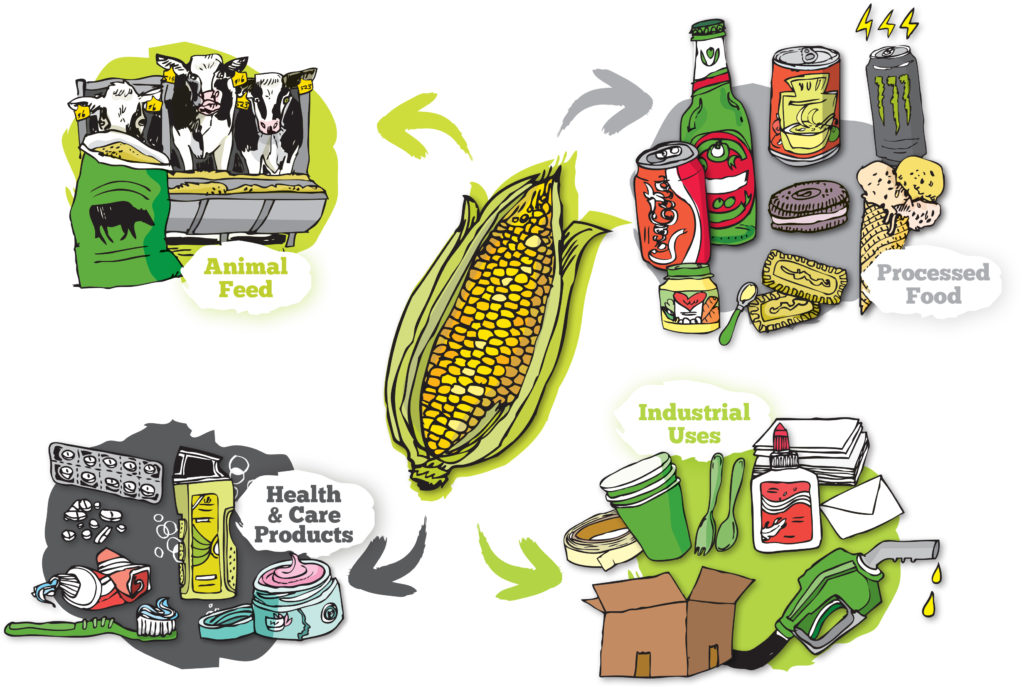
Commercial products made with agro-ecological maize are difficult to find in Spain but there is an increasingly wide range of commercialisation channels for agro-ecological production. Some agro-ecological products can be certified as organic and end up in specialised organic shops or restaurants, and a large percentage may be sold on the farms themselves, in farmers markets, county fairs or organic food cooperatives. Agro-ecological products, however, are unlikely to be sold in large supermarkets.
To Know More
[Activity] Investigate how different selling points (such as a farmer’s market, a small (perhaps organic) food shop and/or a large supermarket) offer different types of products from different agri-food networks.
- What are the main differences and similarities you find between different selling points?
- Can you find the same type of products in different selling points?
- Can you easily find organically produced products everywhere?
- Can you identify GM products?
- Where do the products you purchase regularly come from and how have they been produced?
You!
Behind all of the food items that you buy and consume are many hidden stories; stories that have huge impacts on social structures and relations as well as environmental conditions. This includes the stories about how that food has been produced and processed, who has been involved, what technologies have been used, what knowledge has been mobilised and what impacts the production has had on other humans, organisms and ecosystems. These impacts are directly linked to you through the choices you make about what food you choose to buy and consume every day. Every time you buy food, you are investing in reproducing and reinforcing certain agri-food webs at the expense of others. Both individual and collective acts of consumption therefore involve ethical choices and can also be used as a political tool. Therefore make your choices wisely and think carefully about the agri-food webs you want to invest in and support for our common future.

Globalisation
All the maize we see today stems from the traditional varieties originally developed and cultivated by the indigenous people of Latin America. However, these traditional varieties have now been further developed by various farms and modern breeding programs.
The availability of different varieties of maize means that in addition to it being a staple food in several countries, it is also increasingly a major global commodity used in animal feed and a multiplicity of industrial products. This means that maize is now grown all around the world and is transported and consumed around the globe as not only food, but also feed, fiber and agrofuel.
In agro-ecological webs, there is a strong commitment to shorten supply chains, localise agri-food webs and enhance food sovereignty. This is with an aim of a) reducing food miles and increasing energy efficiency, b) eliminating synthetic chemical inputs, c) bringing closer and fostering a sense of community between producer, consumers and relevant intermediaries, and d) facilitating a fair exchange between producers and consumers).
To Know More
[Interactive website] Where our food comes from?
